Ursa Major constellation lies in the northern sky. Its name means “the great bear” or “the larger bear” in Latin. The smaller bear is represented by Ursa Minor. Ursa Major is the largest northern constellation and the third largest constellation in the sky. Its brightest stars form the Big Dipper asterism (the Plough), one of the most recognizable star patterns in the night sky.
The Great Bear constellation is well known in many world cultures and associated with many different myths. It was one of the constellations catalogued by the Greek astronomer Ptolemy in the 2nd century CE. In Greek mythology, it is associated with the myth of Callisto, a nymph who was turned into a bear by Zeus’ jealous wife Hera.
Ursa Major contains many notable stars and famous deep sky objects. The brightest deep sky objects in the constellation include the Pinwheel Galaxy (M101), Bode’s Galaxy (M81) the Cigar Galaxy (M82), and the Owl Nebula (M97).
Facts, location and map
Ursa Major is the third largest constellation in the sky, after Hydra and Virgo. It occupies an area of 1280 square degrees. It is located in the second quadrant of the northern hemisphere (NQ2). The entire constellation can be seen from locations between the latitudes +90° and -30°.
The neighboring constellations are Boötes, Camelopardalis, Canes Venatici, Coma Berenices, Draco, Leo, Leo Minor and Lynx.
The constellation name Ursa Major is pronounced /ˌɜːrsə ˈmeɪdʒər/. In English, the constellation is known as the Great Bear. The genitive form of Ursa Major, used in star names, is Ursae Majoris (pronunciation: /ˌɜːrsiː məˈdʒɒrɪs/). The three-letter abbreviation, adopted by the International Astronomical Union (IAU) in 1922, is UMa.
Ursa Major contains seven Messier objects: Messier 40 (M40, Winnecke 4), Messier 81 (M81, NGC 3031, Bode’s Galaxy), Messier 82 (M82, NGC 3034, Cigar Galaxy), Messier 97 (M97, NGC 3587, Owl Nebula), Messier 101 (M101, NGC 5457, Pinwheel Galaxy), Messier 108 (M108, NGC 3556, Surfboard Galaxy), and Messier 109 (M109, NGC 3992).

Ursa Major, image: Constellation Guide
The Great Bear constellation contains 21 stars with confirmed planets. The stars with multiple planets include Chalawan (47 UMa) and HIP 57274 with three orbiting planets each and HD 89744 and Násti (HD 68988) with two planets each.
The brightest star in Ursa Major is Alioth, Epsilon Ursae Majoris. The evolved A-type star has an apparent magnitude of 1.77 and lies 82.6 light-years away. It is the 32nd brightest star in the night sky.
The constellation Ursa Major contains 22 formally named stars. The star names approved by the International Astronomical Union (IAU) are Alcor (80 Ursae Majoris A), Alioth (Epsilon Ursae Majoris), Alkaid (Eta Ursae Majoris), Alkaphrah (Kappa Ursae Majoris A), Alula Australis (Xi Ursae Majoris Aa), Alula Borealis (Nu Ursae Majoris), Aniara (HD 102956), Chalawan (47 Ursae Majoris), Dombay (HAT-P-3), Dubhe (Alpha Ursae Majoris A), Intercrus (41 Lyncis), Liesma (HD 118203), Mazalaai (HAT-P-21), Megrez (Delta Ursae Majoris), Merak (Beta Ursae Majoris), Mizar (Zeta Ursae Majoris Aa), Muscida (Omicron Ursae Majoris A), Násti (HD 68988), Phecda (Gamma Ursae Majoris A), Taiyangshou (Chi Ursae Majoris), Talitha (Iota Ursae Majoris Aa), Tania Australis (Mu Ursae Majoris A), and Tania Borealis (Lambda Ursae Majoris).
There are two meteor showers associated with the constellation: the Alpha Ursae Majorids and the Leonids-Ursids.
Ursa Major belongs to the Ursa Major family of constellations, along with Boötes, Camelopardalis, Canes Venatici, Coma Berenices, Corona Borealis, Draco, Leo Minor, Lynx, and Ursa Minor.
The best time of the year to see Ursa Major is during the month of April, when the constellation appears high above the horizon at 9 pm. The Great Bear is circumpolar to most northern observers but never rises very high in the sky for observers in the southern hemisphere.
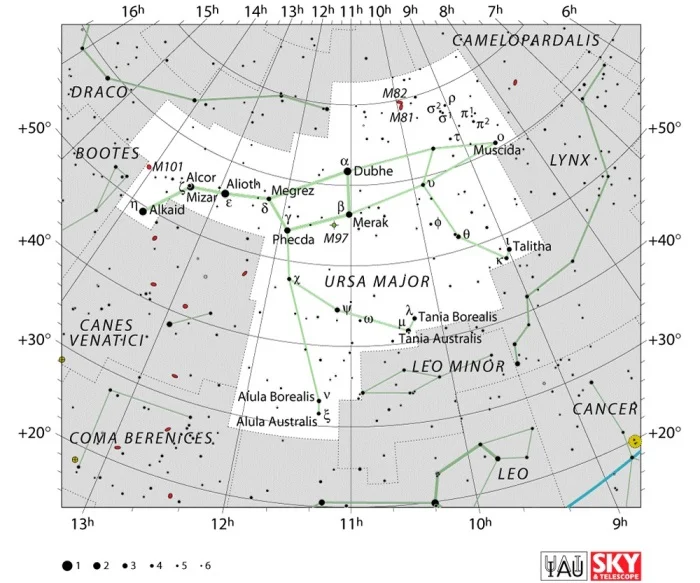
Ursa Major constellation map by IAU and Sky&Telescope magazine (Roger Sinnott & Rick Fienberg) (CC BY 3.0)
Myth
Ursa Major is a well-known, significant constellation in many cultures. It is one of the oldest constellations in the sky, with a history dating back to ancient times. The constellation is referenced in Homer and the Bible. A great number of tales and legends across the globe associate Ursa Major with a bear.
Ancient Greeks associated the constellation with the myth of Callisto, the beautiful nymph who had sworn a vow of chastity to the goddess Artemis. Zeus saw the nymph one day and fell in love. The two had a son, and named him Arcas. Artemis had already banished Callisto when she had learned about the nymph’s pregnancy and broken vow.
Zeus’ jealous wife Hera was not amused by her husband’s actions. Angered by Zeus’ betrayal, she turned Callisto into a bear.
Callisto lived as a bear for the next 15 years, roaming the forest and always running and hiding from hunters. One day, her son Arcas was walking in the forest and the two came face to face. At the sight of the bear, Arcas quickly drew his spear.
Seeing the scene from Olympus, Zeus intervened to prevent a tragedy. He sent a whirlwind that carried both Callisto and Arcas into the heavens, where he turned Arcas into the constellation Boötes, the Herdsman, and Callisto into Ursa Major. (In another version, Arcas becomes the constellation Ursa Minor.) This only further infuriated Hera and she persuaded her foster parents Oceanus and Tethys never to let the bear bathe in the northern waters. This, according to the legend, is why Ursa Major never sets below the horizon in the mid-northern latitudes.
In a different version of the tale, it is not Hera but Artemis who transforms Callisto into a bear. Artemis does this to punish the nymph for breaking her vow of chastity to the goddess. Many years later, both Callisto and Arcas are captured in the forest and taken to King Lycaon as a gift. The mother and son take refuge in the temple of Zeus, and the god intervenes and saves them, placing them both in the sky.
There is an entirely different Greek myth associated with Ursa Major. It involves two bears that saved Zeus from his father Cronus (or Cronos) and nourished him for a year.
A more familiar version of the story involves Adrasteia, one of the nymphs who took care of Zeus when he was very young. In Greek lore, Zeus’ father Cronus was told by an oracle that one of his children would eventually overthrow him. Fearful of the prophecy, Cronus swallowed all his children until Zeus was born. Rhea, Zeus’ mother, smuggled their youngest child to the island of Crete, where the nymphs Adrasteia and Ida nursed young Zeus for a year. In this version of the myth, Ida is associated with the constellation Ursa Minor. Amaltheia, the goat that nursed Zeus, was placed in the sky as the bright star Capella in the constellation Auriga. The prophecy eventually came true. Zeus overthrew Cronus and freed his brothers Hades and Poseidon and sisters Demeter, Hera and Hestia.
The Romans called the constellation Septentrio, or “seven plough oxen,” even though only two of the seven stars represented oxen, while the others formed a wagon. The name was also used for Ursa Minor.
Ursa Major is associated with many different forms in the sky in different cultures, including the camel, shark, skunk, sickle, bushel and canoe. The Chinese know the seven brightest stars, or Tseih Sing, as the Government, or Pih Tow, the Northern Measure.
In Hindu legend, the brightest stars of Ursa Major represent the Seven Sages and the constellation is known as Saptarshi. The sages in question are Bhrigu, Atri, Angirasa, Vasishta, Pulastya, Pulalaha and Kratu.
In some Native American tales, the bowl of the Big Dipper represents a large bear and the stars that mark the handle of the Dipper are the warriors chasing it. Since the constellation is pretty low in the sky in autumn, the legend says that it is the blood of the wounded bear that causes the leaves to turn red.
In more recent American history, the Big Dipper played a role in the Underground Railroad, as its position in the sky helped escaped slaves find their way north. There were numerous songs that spread in the south that said to follow the ‘Drinking Gourd’ to get to a better life.

Photo of the constellation Ursa Major with annotations from IAU and Sky & Telescope. Image credit: E. Slawik/NOIRLab/NSF/AURA/M. Zamani (CC BY 4.0)
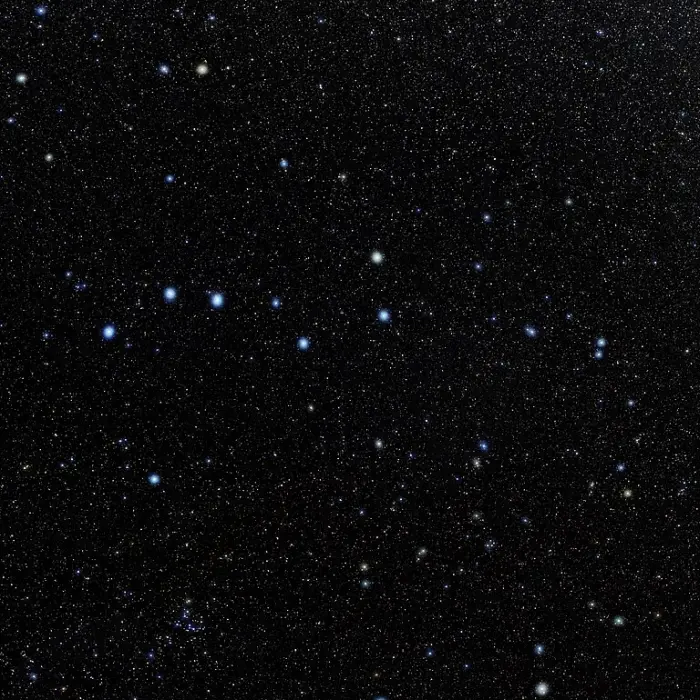
Photo of the constellation Ursa Major produced by NOIRLab in collaboration with Eckhard Slawik, a German astrophotographer. Credit: E. Slawik/NOIRLab/NSF/AURA/M. Zamani (CC BY 4.0)
Asterisms
Big Dipper
The Big Dipper is one of the most recognizable asterisms in the night sky. Formed by seven bright Ursa Major stars, the star pattern is visible even from light-polluted areas. For observers in the northern hemisphere, it stays above the horizon throughout the year.
The Big Dipper is formed by Dubhe (Alpha UMa), Merak (Beta UMa), Phecda (Gamma UMa), Megrez (Delta UMa), Alioth (Epsilon UMa), Mizar (Zeta UMa), and Alkaid (Eta UMa). Alkaid, Mizar and Alioth form the Big Dipper’s handle, and Phecda, Megrez, Dubhe and Merak outline the bowl.
The Big Dipper’s handle can be used to find the bright star Arcturus, the bear keeper. Arcturus is the brightest star in the northern celestial hemisphere and the lucida of the constellation Boötes (the Herdsman). The star’s name is derived from the Greek ἄρκτος (arktos), meaning “bear,” and οὖρος (ouros), “watcher” or “guardian.”
Following the curved line past Arcturus leads to Spica, the brightest star in the constellation Virgo and the 16th brightest star in the sky.
The Big Dipper has significance in many cultures and is known by many different names. These include the Plough, Charles’ Wain, the Seven Oxen, the Great Wagon, the Saucepan, the Seven Sages, and the Northern Dipper.

Big Dipper (Ursa Major constellation) over Old Faithful geyser, Yellowstone National Park, Wyoming. Image credit: Wikimedia Commons/Astroval1 (CC BY-SA 4.0)
Pointer Stars
Merak and Dubhe, the outer stars of the Big Dipper’s bowl, are known as the Pointer Stars (or simply the Pointers). They point in the direction of Polaris, the nearest visible star to the northern celestial pole. A line extended from Merak through Dubhe leads to the North Star.
Polaris is the brightest star in Ursa Minor (the Little Bear). It marks the tip of the Little Bear’s tail and the end of the Little Dipper’s handle. The middle stars of the Little Dipper are quite faint and difficult to make out in less-than-ideal conditions, which is why the two brighter stars of the Big Dipper are commonly used to find the pole star and true north.
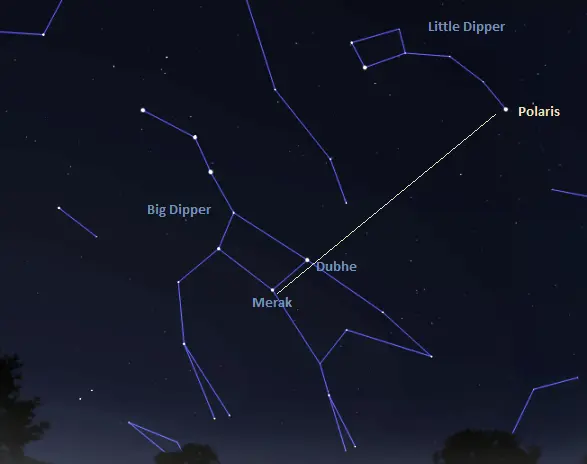
How to find Polaris using the Pointer stars in the Big Dipper, image: Stellarium
Horse and Rider
The stars Mizar and Alcor form a visual double star that was known as the Horse and Rider in Arabic astronomy. Mizar is the middle star of the Big Dipper’s handle and Alcor is its fainter companion. The two stars were long believed to be unrelated but are now known to form a multiple star system.
Three Leaps of the Gazelle
The Three Leaps of the Gazelle is an old Arabic asterism formed by three pairs of stars that mark the Great Bear’s feet. It represents the leaps of a gazelle that dashed across a pond after seeing a lion. The pond is represented by the constellation Coma Berenices.
The Three Leaps asterism is formed by Alula Borealis and Alula Australis (the First Leap), Tania Borealis and Tania Australis (the Second Leap), and Talitha and Alkaphrah (the Third Leap). These stars lie halfway between the Big Dipper and the constellation figure of Leo.
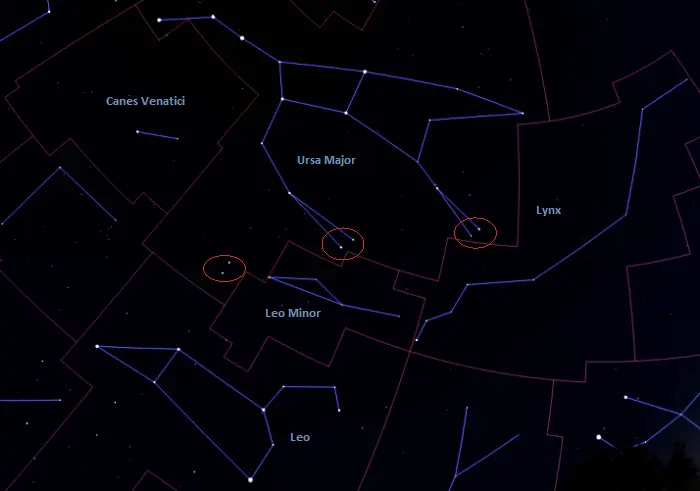
Three Leaps of the Gazelle, Leo Minor and Lynx, image: Stellarium
Messier 40 (M40, Winnecke 4, WNC 4)
Winnecke 4 is a double star in Ursa Major. It was originally catalogued as a Messier object by Charles Messier in 1764, while he was looking for a nebula that Johann Hevelius reported seeing in the region. Not finding the nebula, Messier catalogued the binary star instead.
The German astronomer Friedrich August Theodor Winnecke rediscovered the visual double star in 1863 and included it in his Winnecke Catalogue of Double Stars of 1869.
The two stars of Messier 40 appear in the same field of view but are unrelated. One is an orange giant of the spectral type K0 III, located 1,013 light-years away, and the other is a yellow dwarf with the stellar classification G0 V that lies at less than half the distance, 470 light years away. The stars have apparent magnitudes of 9.64 and 10.11.
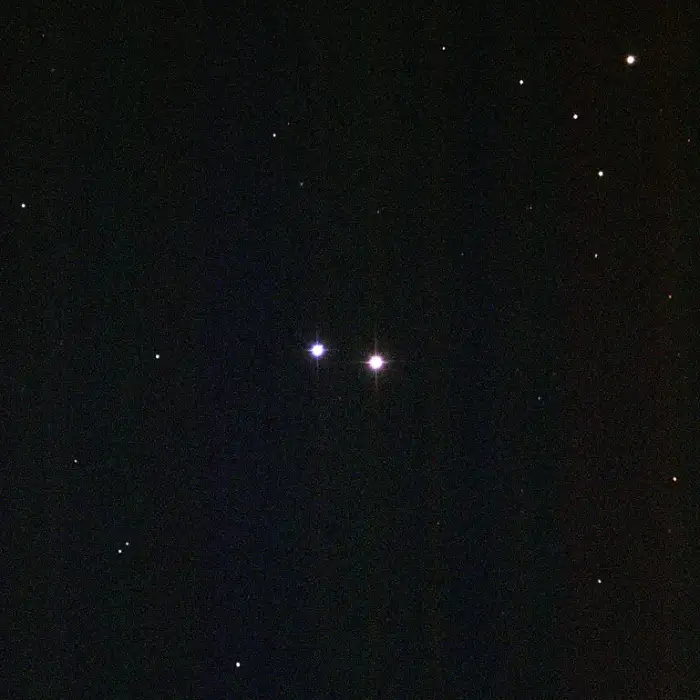
M40 is a faint double star cataloged by Messier while searching for a nebula reported in error by Hevelius. This indicates some of the shortcomings of Messier’s work which, while ground breaking and of inestimable value, was somewhat less than systematic. The pair was re-observed in 1863 and entered in the catalog compiled by A. Winnecke of the Pulkovo Observatory. Image credit: NOIRLab/NSF/AURA (CC BY 4.0)
Broken Engagement Ring
The Broken Engagement Ring is a telescopic asterism about a degree west of Merak. It is a semi-circle of stars about 15 arcminutes across, with a magnitude 7.4 star appearing as the diamond.
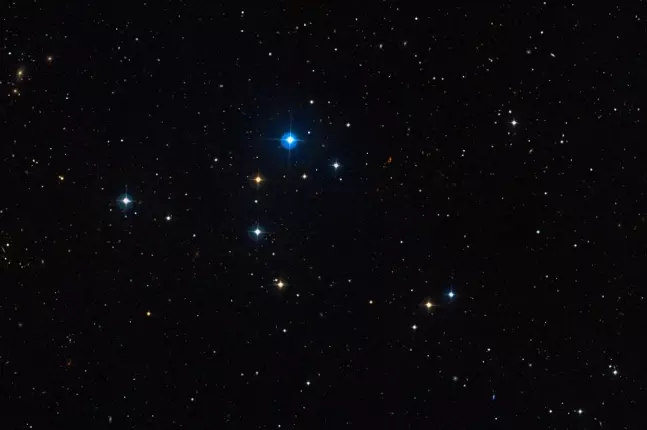
Broken Engagement Ring, image credit: ESO/Digitized Sky Survey 2 (CC BY 4.0)
Eiffel Tower
The Eiffel Tower is a faint asterism in the region of the Big Dipper’s handle. It forms a triangle with Alioth and Mizar. The star pattern resembles the famous landmark and is about 28 arcminutes across. It is also known as Ferrero 6, after its discoverer, the French amateur astronomer Laurent Ferrero.
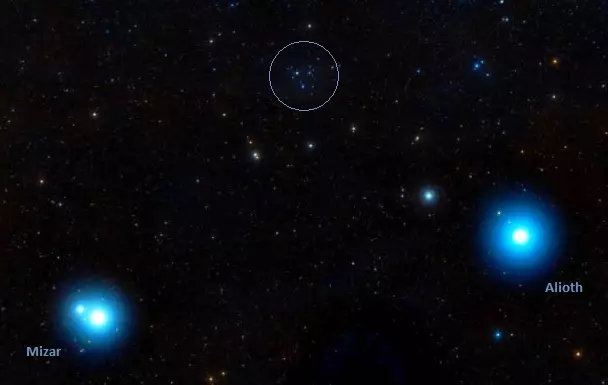
The Eiffel Tower asterism, image credit: ESO/Digitized Sky Survey 2 (CC BY 4.0)
Stars
Ursa Major is one of the brighter northern constellations. It does not contain any first magnitude stars, but its six brightest stars shine at second magnitude and are easily visible even from light-polluted areas. They are part of the Big Dipper.
Most bright stars in the constellation of Ursa Major are members of the Ursa Major Moving Group. Also known as the Ursa Major association and Collinder 285, the stellar grouping is the nearest moving group to the Sun. The members include Big Dipper stars Alioth, Mizar, Phecda, Merak and Mizar. These stars share common velocities in space and are believed to have a common origin.
The Ursa Major Moving Group was discovered by the English astronomer Richard A. Proctor in 1869. Proctor realized that all stars of the Big Dipper with the exception of Alkaid and Dubhe have proper motions heading toward a common point in the constellation Sagittarius. The stars Alphecca (Alpha Coronae Borealis), Menkalinan (Beta Aurigae), Skat (Delta Aquarii), Gamma Leporis and Zhou (Beta Serpentis) are outlying members of the group.
Alioth, the brightest star in Ursa Major, has the Bayer designation Epsilon Ursae Majoris, while the slightly fainter Dubhe has the designation Alpha Ursae Majoris. German astronomer Johann Bayer, who assigned the Greek letter designations to 1,564 stars in his star atlas Uranometria (1603), was guided by the order of magnitude and not by individual brightness. In the case of Ursa Major, he assigned the Greek letters going from west to east. He designated the Pointer Stars Dubhe and Merak Alpha and Beta because they are the westernmost second magnitude stars in the constellation. Alioth lies in the Big Dipper’s handle, to the east, and was given the designation Epsilon.
Alioth – ε Ursae Majoris (Epsilon Ursae Majoris)
Alioth (ε UMa) is an evolved star located 82.6 light-years away. With an apparent magnitude of 1.77, it is the brightest star in Ursa Major and, on average, the 32nd brightest star in the sky. It is the star in the Great Bear’s tail that is the closest to the Bear’s body.
Alioth has the spectral type A1III-IVp kB9, indicating a chemically peculiar blue-white giant or subgiant star. Even though it is a relatively young star, with an estimated age of 300 million years, Alioth has burned through its supply of hydrogen fuel and evolved away from the main sequence. It has 2.91 times the Sun’s mass and a radius 4.29 times that of the Sun. With an effective temperature of 8,908 K, it is 104.4 times more luminous than the Sun.
Alioth is classified as an Alpha2 Canum Venaticorum variable. Alpha2 CVn stars are chemically peculiar stars with strong magnetic fields that show variations in brightness by 0.01 to 0.1 magnitudes, accompanied by changes in their spectral lines and magnetic fields. The brightness variations are believed to be caused by an uneven distribution of elements in the stars’ atmospheres, resulting in spots that come in and out of view as the stars spin. Alioth exhibits fluctuations in its spectral lines with a period of 5.1 days.
The star’s traditional name comes from the Arabic phrase alyat al-hamal, meaning “the fat tail of a sheep.”
Dubhe – α Ursae Majoris (Alpha Ursae Majoris)
Dubhe (α UMa) is an orange giant star located approximately 123 light-years away. With an apparent magnitude of 1.79, it is the second brightest star in Ursa Major and the 34th brightest star in the sky. To the unaided eye, it appears as bright as Alioth. Unlike Alioth, Dubhe does not belong to the Ursa Major Moving Group.
The name Dubhe comes from the Arabic dubb, meaning “bear.” It is taken from the phrase żahr ad-dubb al-akbar, “the back of the Greater Bear.”
Dubhe has a mass of 3.7 solar masses and a radius of 26.85 solar radii. With a surface temperature of 4,650 K, it has an energy output of 339 Suns. It has an estimated age of 280 million years.
Dubhe has a fainter spectroscopic companion, Alpha Ursae Majoris B. The companion is a blue-white main sequence star of the spectral type A5V. It has a mass 2.5 times that of the Sun.
The two stars have an orbital period of 44.45 years. They are separated by only 0.590 arcseconds in the sky, corresponding to a physical separation of about 23 astronomical units (AU). The pair cannot be resolved even in the largest of telescopes.
Dubhe and its close companion form a quadruple star system with another spectroscopic binary star at an angular separation of 7.1 arcminutes, or about 90,000 AU away from the main pair. The component Alpha Ursae Majoris C shines at 7th magnitude. Its individual components orbit each other with a period of 6.035 days.
Alkaid – η Ursae Majoris (Eta Ursae Majoris)
Alkaid (η UMa) is a hot blue main sequence star of the spectral type B3 V. It shines at magnitude 1.86 from a distance of 103.9 light-years. It is the third brightest star in Ursa Major and the 38th brightest star in the sky.
Alkaid is the easternmost star in the Big Dipper asterism. It marks the end of the Dipper’s handle and the tip of the Great Bear’s tail. Like Dubhe, it does not belong to the Ursa Major stellar family. The luminous star is much younger than other Big Dipper stars. It has an estimated age of only 10 million years. However, it will evolve much faster than its bright neighbours due to its high mass (6.1 solar masses).
Alkaid has a surface temperature of 15,540 K and shines with 594 solar luminosities. It is a very fast spinner, with a projected rotational velocity of 150 km/s.
Alkaid was traditionally also known as Elkeid and Benetnasch (or Benetnash). Both traditional names come from the Arabic phrase qā’id bināt na’sh, meaning “the leader of the daughters of the bier.” In Arabic lore, the three stars marking the handle of the Big Dipper represented three mourning maidens, while the stars that form the body of the bowl represented the bier. The name Alkaid itself means leader.
Mizar – ζ Ursae Majoris (Zeta Ursae Majoris)
Mizar (ζ UMa) is the primary component in a quadruple star system located 82.9 light years away. It is the middle star in the handle of the Big Dipper. With an apparent magnitude of 2.04, it is the fourth brightest star in the Great Bear. Mizar forms a visual double star with the fainter Alcor (a binary system) and the two may form a sextuple star system.
Zeta Ursae Majoris consists of two pairs of spectroscopic binary stars separated by 14.4 seconds of arc in the sky. The system has a combined apparent magnitude of 2.04. The components Zeta1 Ursae Majoris and Zeta2 Ursae Majoris shine at magnitudes 2.23 and 3.88.
Zeta1 Ursae Majoris is composed of nearly identical stars of the spectral type A2Vp. The components are Ap stars, chemically peculiar stars with strong lines of strontium and silicon.
Both stars have a mass of around 2.2 solar masses and radii 2.4 times that of the Sun. They are around 370 million years old and have effective temperatures of 9,000 K. Both components have luminosities of 33.3 Suns. They orbit each other with a period of 20.5386 days and are separated by only 9.83 milliarcseconds in the sky.
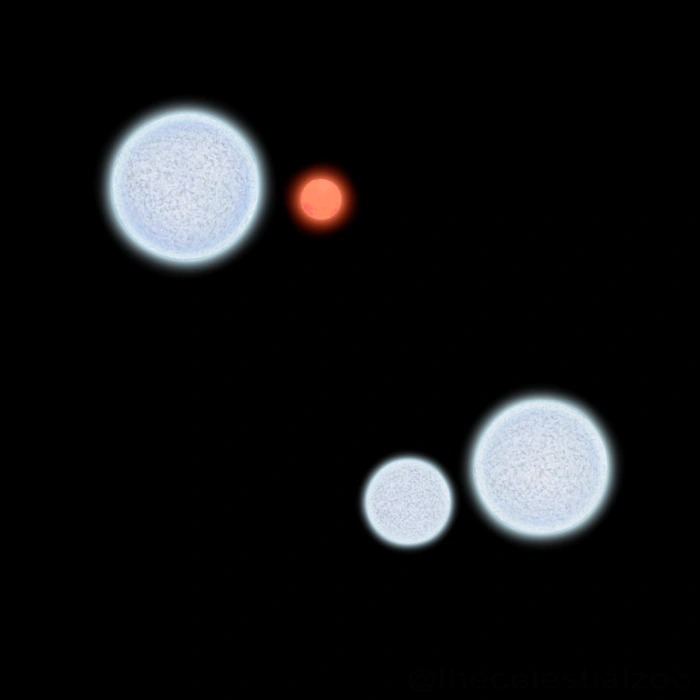
The Mizar system, credit: Pablo Carlos Budassi (CC BY-SA 4.0)
Zeta2 Ursae Majoris is a single-lined spectroscopic binary system with an orbital period of around 176 days. The system has the combined spectral type kA1h(eA)mA7IV-V, with the luminosity class between main sequence and subgiant. The primary component has a mass of 1.85 solar masses and a radius 1.8 times that of the Sun. The secondary component is considerably less massive, with a mass of only 0.25 solar masses.
The name Mizar is derived from the Arabic mīzar, which means “girdle” or “waistband.”
Mizar was the first double star ever to be photographed. The early American photographer and inventor John A. Whipple and astronomer George P. Bond took the photo of the binary system in 1857 using a wet collodion plate and the 15-inch refractor telescope at Harvard College Observatory. Bond had previously also photographed the star Vega in the Lyra constellation in 1850.
Mizar A was the first star to be identified as a spectroscopic binary system. American astronomer Antonia Maury, one of the Harvard Computers, determined the system’s orbit based on the periodic doubling of some of its spectral lines in 1890.
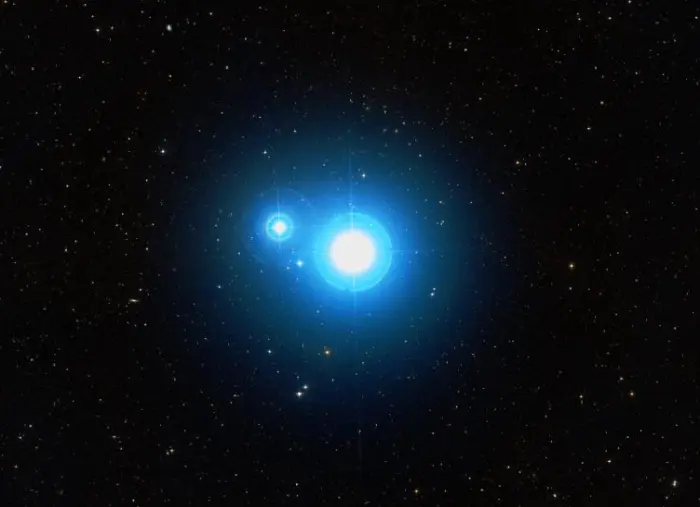
Mizar and Alcor, image credit: ESO/Digitized Sky Survey 2 (CC BY 4.0)
Alcor (80 Ursae Majoris)
Alcor (80 UMa) is a binary star composed of a white main sequence star and a red dwarf. The star system lies 81.7 light years away and shines at magnitude 3.99. The name Alcor comes from the Arabic al-khawāri, meaning “the faint one.”
Alcor is a visual companion to the brighter Mizar in the sky. The two stars are sometimes known as the Horse and Rider. They are separated by about 12 arcminutes and appear as a visual pair to the unaided eye. Both stars are members of the Ursa Major Moving Group and share a common proper motion. However, it is not certain that they are gravitationally bound to each other because the stars’ exact distances from Earth are not completely certain.
Astronomers believe that the physical separation between the two star systems is 74,000 ± 39,000 AU, or 0.5 – 1.5 light-years. If, however, they lie at the same distance from the Sun, then the distance between them is 17,800 AU, or only 0.281 light-years.
Alcor, the primary component in the 80 Ursae Majoris system, has the spectral class A5Vn. It has a mass of 1.842 solar masses and is about 14 times more luminous than the Sun. It has an estimated age of 422 million years.
Alcor is an exceptionally fast spinner. It has a projected rotational velocity of 239 km/s. As a result, it has an oblate shape. It has an equatorial radius of 2.002 solar radii and a polar radius of 1.723 solar radii. Since the star’s poles are closer to the centre of mass, they are hotter than the equator. The star has an equatorial temperature of 7,556 K and a polar temperature of 8,985 K.
The companion, Alcor B, is a red dwarf of the spectral type M3-4. It has only 25% of the Sun’s mass and is believed to be around 500 million years old. It was discovered in 2009. The dim star has an apparent magnitude of 8.8.
Alcor was historically also known as Saidak (“true”), Al Sadak (“the test”), and Suha or Suhā/Sohā (“the forgotten one” or “the neglected one”). In Hindu mythology, it was associated with Arundhati, the wife of the Sage Vashishta (Mizar).
Merak – β Ursae Majoris (Beta Ursae Majoris)
Merak (β UMa) is a white subgiant star located 79.7 light years away. With an apparent magnitude of 2.37, it is the fifth brightest star in Ursa Major. The name Merak comes from the Arabic al-maraqq, meaning “the loins.”
Merak has the spectral type A1IVps. It is mild Am star, a chemically peculiar metallic-line star with prominent lines of heavier elements. It has a mass of 2.56 solar masses and a radius 2.81 times that of the Sun. The star is 63.5 times more luminous than the Sun, with an effective temperature of 9,700 K. It is believed to be around 390 million years old.
Merak shows an excess emission in the infrared, indicating that it has an orbiting circumstellar debris disk. The dust disk orbits at 47 AU from the star. It has a temperature of 120 K and a mass 0.27 percent that of the Earth.
The slightly fainter Phecda, the other star at the base of the Big Dipper’s bowl, is one of Merak’s closest neighbours. They are separated by only 11 light years. 37 Ursae Majoris is even closer to Merak, at a distance of 5.2 light-years.
Phecda – γ Ursae Majoris (Gamma Ursae Majoris)
Phecda (γ UMa) is a white main sequence star of the spectral type A0 Ve. It shines at magnitude 2.438 from a distance of 83.2 light-years. It is the lower left star in the bowl of the Big Dipper
Phecda forms a binary system with a fainter orange main sequence star with the spectral class K2 V. The two stars take 20.5 years to complete an orbit around the common centre of mass. They are separated by only 0.460 arcseconds in the sky.
Phecda has 2.412 times the Sun’s mass and is 44.57 times more luminous than the Sun. It is an Ae star, surrounded by an envelope of expelled gas that is adding emission lines to its spectrum. It is ejecting material because of its exceptionally high spin rate (184.5 km/s). The star has an estimated age of 333 million years.
Fast rotation is also responsible for the star’s oblate shape. Like Alcor, Phecda is an example of gravity darkening. Because of its flattened shape, its poles are closer to the centre of mass and therefore hotter and brighter than the equatorial region. The star has a polar radius of 2.186 solar radii and an equatorial radius of 3.385 solar radii, and a temperature of 10,520 K at the poles and 6,751 at the equator.
The companion, Gamma Ursae Majoris B, has 79% of the Sun’s mass and shines with 39.7% of the Sun’s luminosity. It is much cooler than Gamma Ursae Majoris A, with a surface temperature of 4,780 K.
The star’s traditional name, Phecda (or Phad), is derived from the Arabic phrase fakhð ad-dubb, meaning “the thigh of the bear.”
Phecda is located only 8.55 light years away from the Mizar-Alcor star system.
Ψ Ursae Majoris (Psi Ursae Majoris)
Psi Ursae Majoris (ψ UMa) is an orange giant of the spectral type K1 III. It lies at a distance of 140 light-years and has an apparent magnitude of 3.01. It appears in one of the Great Bear’s legs. In Chinese astronomy, it is known as Tien Tsan or Ta Tsun, meaning “exceptionally honourable.” Even though it is a relatively bright star, Psi UMa does not have a formal name approved by the International Astronomical Union (IAU).
The star has a mass of 2.31 solar masses and a radius of 19.12 to 20.79 solar radii. With an effective temperature of 4,543 K, it is 140 times more luminous than the Sun.
Tania Australis – μ Ursae Majoris (Mu Ursae Majoris)
Tania Australis (μ UMa) is the primary component in a binary star system located 230 light-years from Earth. The system has an apparent magnitude of 3.06.
The Mu Ursae Majoris system is composed of a red giant of the spectral type M0 IIIab and a fainter unseen companion. The two stars have an orbital period of 230.089 days and are separated by only 0.0028 arcseconds in the sky. At this separation, the individual components cannot be resolved even in the largest telescopes.
The primary component, Tania Australis, has a mass 6.3 times that of the Sun and radius 75 times the Sun’s. It is 977 – 1,200 times more luminous than our host star.
Tania Australis is a suspected variable star. Its brightness has been reported to vary between magnitude 2.99 and 3.33.
The companion has an estimated mass of 0.96 solar masses.
The name Tania Australis refers to the Three Leaps of the Gazelle asterism. It is derived from the Arabic Al Fiḳrah al Thānia, meaning “the second spring (of the gazelle).” Tania is Arabic for “second” and australis is Latin for “southern.” Mu Ursae Majoris is the southern of the two stars of the Second Leap of the Gazelle. The fainter Tania Borealis is the other half of the pair.
θ Ursae Majoris (Theta Ursae Majoris)
Theta Ursae Majoris (θ UMa) is a yellow-white subgiant star with the stellar classification F6 IV. It appears in the front leg of the Great Bear. It has an apparent magnitude of 3.7 and lies 43.96 light-years away.
The star has a mass of 1.41 solar masses and a radius of 2.41 solar radii. It shines with 7.871 solar luminosities and spins at 6.8 km/s. It has an estimated age of 2.2 billion years.
Theta Ursae Majoris may be the primary component in a triple star system. The presence of a spectroscopic companion was reported in 1976, but it remains disputed. The star also has a common proper motion companion at a separation of 4.1 arcseconds.
Talitha – ι Ursae Majoris (Iota Ursae Majoris)
Talitha (ι UMa) is the primary component in a multiple star system located 47.3 light-years away. The star system marks the celestial Bear’s front paw. It has an apparent magnitude of 3.14.
The Iota Ursae Majoris system is composed of two pairs of binary stars. The two binary systems orbit each other with a period of 2,084 years.
Talitha (Iota Ursae Majoris Aa) is the brightest component in the system. It is a white subgiant star of the spectral type A7V(n). It has a mass of 1.7 solar masses and a radius of 1.67 solar radii. With an effective temperature of 8,242 K, it shines with 8.98 solar luminosities. It has an estimated age of 620 million years.
Talitha has a spectroscopic companion, Iota Ursae Majoris Ab, which is believed to be a white dwarf with a mass similar to the Sun’s. The companion has not been directly observed.
The other binary system consists of a pair of red dwarfs, Iota Ursae Majoris C and Iota Ursae Majoris D, with masses of 0.35 and 0.30 solar masses and radii of 0.46 and 0.43 solar radii. The brighter component is a 9th magnitude star, invisible to the unaided eye, and the fainter shines at 10th magnitude. The red dwarfs take 39.7 years to complete an orbit and are separated by about 0.7 arcseconds, corresponding to a physical distance of at least 10 AU between the stars.
The name Talitha comes from the Arabic Al Ḳafzah al Thalitha, meaning “the third leap of the gazelle.” Talitha and the fainter Alkaphrah form the Third Leap of the Gazelle.
Megrez – δ Ursae Majoris (Delta Ursae Majoris)
Megrez (δ UMa) is a white main sequence star of the spectral type A3 V. With an apparent magnitude of 3.312, it is the faintest of the seven bright stars that form the Big Dipper asterism. Megrez lies 80.5 light-years away. It forms the inner part of the Big Dipper’s bowl with the brighter Phecda.
Megrez has a mass 2.062 times that of the Sun and is 23 times more luminous than the Sun. It is another fast spinner with an oblate shape. With a projected rotational velocity of 244.6 km/s, it takes only 3.1 hours to complete a rotation. The star has an estimated age of 414 million years.
Due to its fast rotation, Megrez has a flattened shape. It has a radius of 1.921 solar radii at the poles and 2.512 solar radii at the equator. The surface temperature of the star is higher at the poles (10,030 K) than it is at the equator (6,909 K).
Delta Ursae Majoris emits an excess of infrared radiation, which indicates the presence of an orbiting debris disk. The disk orbits at a distance of 16 astronomical units (AU) from the star.
The star’s name, Megrez, is derived from the Arabic word al-maghriz, which means “the base.” The name refers to the star’s position at the base of the Great Bear’s tail.
Muscida – ο Ursae Majoris (Omicron Ursae Majoris)
Muscida (ο UMa) is a yellow giant star of the spectral type G5III. It lies 182 light years away and has an apparent magnitude of 3.35. It marks the Great Bear’s nose or snout.
The star has 2.72 times the Sun’s mass and it expanded to a size of 13.84 solar radii as it evolved into a giant. It has an effective temperature of 5,242 K and a luminosity 116 times that of the Sun. The star is much younger than the Sun. It has an estimated age of only 360 million years. It evolved faster than the Sun because it is more massive.
Muscida has a fainter companion at a separation of 7.1 seconds of arc. The companion has an apparent magnitude of 15.2.
Muscida has a planet, Omicron Ursae Majoris b, discovered in 2012. The planet has a minimum mass of 4.1 Jupiter masses. It orbits Muscida with a period of 1,630 days at an orbital distance of 3.9 astronomical units (AU).
Muscida is a runaway star. It has a peculiar velocity of 35.5 km s-1 relative to nearby stars.
The star’s traditional name, Muscida, means “the muzzle” in Latin.
Tania Borealis – λ Ursae Majoris (Lambda Ursae Majoris)
Tania Borealis (λ UMa) is a subgiant star of the spectral type A2 IV. It shines at magnitude 3.45 from a distance of 138 light years. It has an estimated age of 380 million years.
The star has a mass of 2.11 solar masses and a radius 2.3 times that of the Sun. With a surface temperature of 9,247 K, it is 37 times more luminous than the Sun. It spins at 50 km/s.
The star’s traditional name, Tania Borealis, means “the Northern (star) of the Second (leap).”
Alula Borealis – ν Ursae Majoris (Nu Ursae Majoris)
Alula Borealis (ν UMa) is a binary star located 399 light years away. It has an apparent magnitude of 3.49. It is believed to be about 200 million years old.
The primary component, Nu Ursae Majoris A, is an orange giant of the spectral type K3 III. It has a mass of 3.82 solar masses and a radius 60 times that of the Sun. It is 1,242 times more luminous than our host star and has an effective temperature of 4,422 K.
The star has a much fainter companion, a yellow dwarf, at an angular separation of 7.1 arcseconds. The companion has an apparent magnitude of 10.1.
The star’s traditional name, Alula Borealis, is derived from the Arabic word al-Ūlā, which means “the first (leap),” and the Latin word for “northern,” borealis.
Alkaphrah – κ Ursae Majoris (Kappa Ursae Majoris)
Alkaphrah (κ UMa) is a double star located 358 light-years away. It has a combined apparent magnitude of 3.56. The individual components shine at magnitudes 4.16 and 4.54.
Both stars in the Kappa Ursae Majoris system are A-type stars. The primary component, Kappa UMa A, has the stellar classification A0 IV-V, indicating that it is coming to the end of its hydrogen fusing lifetime. The companion is still on the main sequence and has the spectral type A0 V.
The primary component has 3.79 times the Sun’s mass and a radius 7.87 times that of the Sun. It has a surface temperature of 9,060 K and is an exceptionally fast spinner, with a projected rotational velocity of 201 km/s. The star has a debris disk with a mean temperature of 165 K orbiting at a distance of 55.2 astronomical units.
The name Alkaphrah comes from the Arabic al-qafzah, meaning “the leap.”
Taiyangshou – χ Ursae Majoris (Chi Ursae Majoris)
Taiyangshou (χ UMa) is an orange giant star of the spectral type K0.5 IIIb. It shines at magnitude 3.72 from a distance of 198 light years. It has a mass of 1.49 solar masses and has expanded to a size of 23.15 solar radii as it evolved into a giant. It is 170.1 times more luminous than the Sun and has an effective temperature of 4,331 K.
Taiyangshou is the brightest point of light near the imaginary line connecting Phecda and Alula Borealis. The spiral galaxy NGC 3877 appears only 15 arcminutes south of the star.
The name Taiyangshou comes from the Chinese Tai Yang Shou (太陽守), meaning “the Sun Governor” or “Guard of the Sun.”
Alula Australis – ξ Ursae Majoris (Xi Ursae Majoris)
Alula Australis (ξ UMa) is a quintuple star system located 28.5 light-years away. It is the second closest quintuple system to the Sun, after V1054 Ophiuchi in the constellation Ophiuchus. The two visual components, Xi Ursae Majoris A and Xi Ursae Majoris B, have apparent magnitudes of 4.264 and 4.729.
Alula Australis was discovered to be a visual double star by the German-born British astronomer William Herschel in 1780. In 1828, French astronomer Félix Savary calculated the system’s orbit. This was the first star system for which an orbit was calculated.
The main components in the Xi Ursae Majoris system are yellow dwarfs of the spectral types F8.5:V and G2V. They orbit each other with a period of 59.878 years and are separated by 2.536 arcseconds in the sky.
Both components are themselves single-lined spectroscopic binary stars. The components Xi UMa Aa and Ab have an orbital period of 669 days, while Xi UMa Ba and Bb take only 3.98 days to complete an orbit around a common centre of mass. Xi UMa Ab is believed to be a red dwarf, and Xi UMa Bb either a red dwarf or a white dwarf.
The system has another companion, a brown dwarf, at a separation of 8.5 arcminutes, corresponding to a physical distance of around 4,000 astronomical units.
Xi Ursae Majoris is classified as an RS Canum Venaticorum variable. RS Canum Venaticorum variables are close binary stars with large stellar spots caused by the stars’ active chromospheres. In some cases, the fluctuations in brightness are caused by the stars being eclipsing binaries. The component Xi UMa B is believed to be the source of the variations. Its brightness varies by 0.01 magnitude.
The name Alula comes from the Arabic phrase Al Ḳafzah al Ūla, meaning “the first spring” or “the first leap.” The word itself means “the first.” Australis is Latin for “southern.”
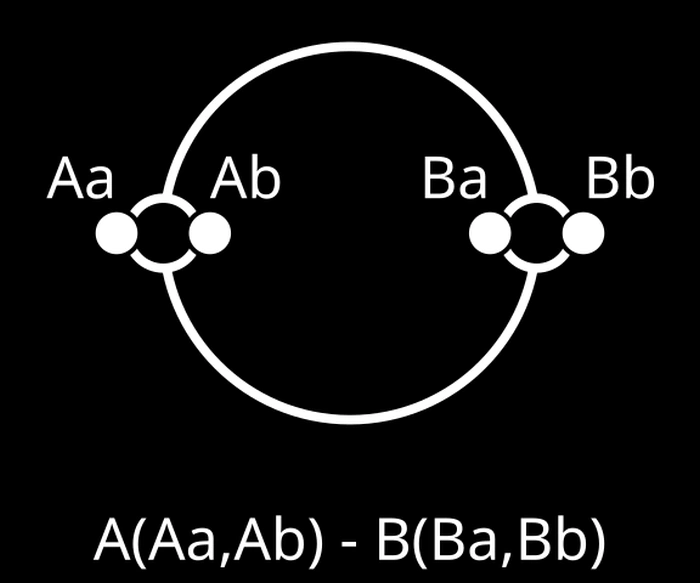
The Xi Ursae Majoris star system, not scaled, credit: Wikimedia Commons/Antonsusi (PD)
Chalawan (47 Ursae Majoris)
Chalawan (47 UMa) is a yellow main sequence star located 45.30 light years away. It has the spectral type G1V. With an apparent magnitude of 5.03, the solar analog is faintly visible to the unaided eye. It appears in the region of the Great Bear’s feet.
The star is slightly larger and more massive than the Sun. It has a mass of 1.08 solar masses and a radius of 1.172 solar radii. With a surface temperature of 5,887 K, it shines with 1.48 solar luminosities.
Chalawan has about 110 percent of the Sun’s abundance of iron and is older than our parent star. It has an estimated age of 6.03 billion years.
47 Ursae Majoris hosts three orbiting planets. 47 Ursae Majoris b was detected in 1996. It was the first long-period planet to be discovered. It has a mass at least 2.53 times that of Jupiter and orbits 47 UMa with a period of 1,078 days (2.95 years).
The discovery of 47 Ursae Majoris c was announced in 2002. The planet has an orbital period of 2,391 days (6.55 years) and a mass of at least 0.540 Jupiter masses.
The third planet, 47 Ursae Majoris c, was discovered in 2010. It has a mass of at least 1.64 Jupiter masses and an orbital period of 14,002 days (38.33 years). It orbits Chalawan at a distance of 11.6 AU with an eccentricity of 0.16.
In 2015, the star 47 Ursae Majoris was named Chalawan, after a mythological crocodile from a Thai folktale. The planets 47 Ursae Majoris b and c were formally named Taphao Thong and Taphao Kaew, after two sisters from the same tale.
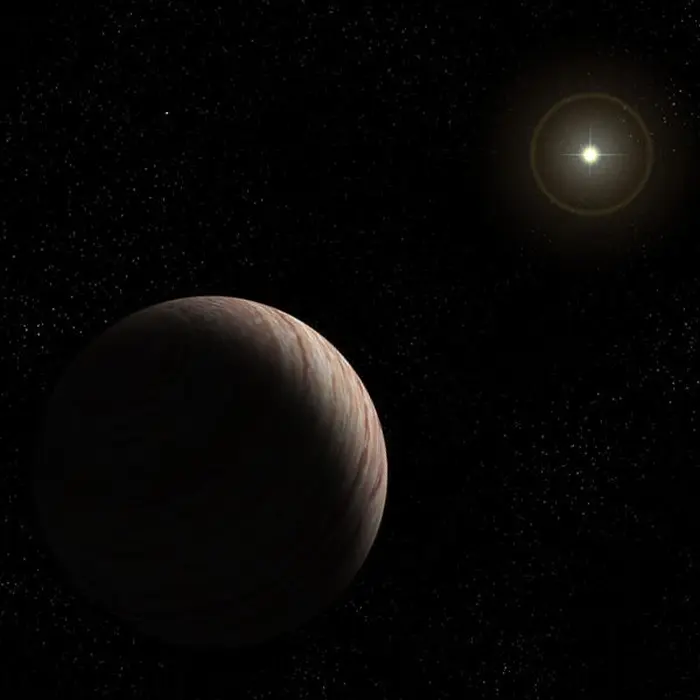
47 Ursae Majoris b (illustration), credit: Wikimedia Commons/Debivort (CC BY-SA 3.0)
Intercrus (41 Lyncis)
Intercrus (41 Lyn) is an orange giant located approximately 276 light-years away. It appears in the area between the second and third leaps of the gazelle, near the border with the constellation Lynx. It has an apparent magnitude of 5.39.
41 Lyncis has the stellar classification K0 III. It has a mass 107% that of the Sun and a radius about 11 times the Sun’s. It shines with 60.30 solar luminosities with an effective temperature of 4,797 K. The evolved star is slightly younger than the Sun, with an estimated age of 4.07 billion years.
The star has the Bayer designation 41 Lyncis because it belonged to the constellation Lynx before the International Astronomical Union (IAU) established the constellation boundaries in 1930.
41 Lyncis hosts an orbiting exoplanet, 41 Lyncis b (HD 81688 b). The discovery of the planet was announced on February 19, 2008. 41 Lyncis b has a minimum mass of 2.7 Jupiter masses and orbits the host star with a period of 183.93 days.
41 Lyncis was named Intercrus in December 2015. The name means “between the legs” and refers to the star’s position in Ursa Major. The planet HD 81688 b was named Arkas, after the son of the nymph Callisto in Greek mythology.
HD 89744
HD 89744 is an old F-type star located 125.8 light-years away. It appears only 0.4 degrees south of the brighter Tania Australis (Mu Ursae Majoris). It has an apparent magnitude of 5.73.
HD 89744 is classified as a main sequence star or subgiant of the spectral type F7V or F8IV. It has an estimated age of 8.4 billion years. It has a mass of 1.37 solar masses and a radius 2.16 times that of the Sun. With a surface temperature of 6,381 K, the star is 6.38 times more luminous than the Sun. It spins at 9.3 km/s, taking around 9 days to complete a rotation.
HD 89744 has a brown dwarf companion with a mass of 0.076 solar masses at an angular separation of 63.1 arcseconds, corresponding to a distance of 2,456 astronomical units.
A planet was discovered orbiting the primary component in 2000. HD 89744 b has a mass of at least 8.35 Jupiter masses and an orbital period of around 257 days. It orbits at a separation of 0.917 astronomical units.
A second planet, HD 89744 c, was reported in 2019. The unconfirmed planet has a minimum mass of 5.36 Jupiter masses and orbits the star with a period of 6,974 days at a distance of 8.3 astronomical units.
Argelander’s Star (Groombridge 1830)
Groombridge 1830 is an orange main sequence star of the spectral type K1V Fe-1.5. It has an apparent magnitude of 6.44 and lies only 29.914 light years away.
When it was discovered, Groombridge 1830 was the star with the highest proper motion of any star known. It dropped to the third place after the discovery of Kapteyn’s Star in the constellation Pictor and Barnard’s Star in Ophiuchus.
Groombridge 1830 has a mass of 0.63 solar masses and a radius of 0.586 solar radii. It shines with 0.221 solar luminosities and has an effective temperature of 5,174 K. It has an estimated age between 4.7 and 5.3 billion years.
The star was catalogued by the British astronomer Stephen Groombridge in the early 19th century in his Catalogue of Circumpolar Stars, published posthumously in 1838.
Groombridge 1830 is also known as Argelander’s Star, after the German astronomer Friedrich Wilhelm Argelander, who noted its high proper motion in 1842.
Like Kapteyn’s Star, Groombridge 1830 is a halo star, one that appears to be moving in the direction opposite to the galaxy’s rotation because it does not follow the rotation of the Milky Way. Halo stars are typically metal-poor, because they formed when the galaxy was younger. Most halo stars are located either far above or below the galactic plane and believed to be at least 10 billion years old. They have highly eccentric orbits and high space velocities.
Lalande 21185
Lalande 21185 (Gliese 411) is a red dwarf located only 8.3044 light-years away. With an apparent magnitude of 7.5, it is below unaided eye visibility, but it is nonetheless the brightest red dwarf in the northern celestial hemisphere. The small red star appears in the region of the Great Bear’s hind legs, near Praecipua, the brightest star in Leo Minor.
Lalande 21185 is the fourth nearest star or star system and the sixth nearest individual true star to the Sun, after Proxima Centauri, Rigil Kentaurus and Toliman in the Alpha Centauri system in the constellation Centaurus, Barnard’s Star in Ophiuchus, and Wolf 359 in Leo. The brown dwarfs Luhman 16 A and B in Vela and WISE 0855−0714 in Hydra also lie closer to Earth.
Lalande 21185 lies only 0.3 light years closer to us than Sirius, the brightest star in the sky. It is catalogued as Gliese 411 (GJ 411) in the Gliese Catalogue of Nearby Stars.
The red dwarf star has only 38.9% of the Sun’s mass and 39.2% of the Sun’s radius. With a surface temperature of 3,547 kelvin, it has a bolometric luminosity of only 0.02194 solar luminosities and a visual luminosity 0.55% that of the Sun. Most of the star’s energy output is in the infrared part of the spectrum.
Lalande 21185 takes 56.15 days to complete a rotation. The star is much older than the Sun. It has an estimated age of 8.047 billion years.
Lalande 21185 is classified as a BY Draconis-type variable and is a known X-ray source. BY Draconis stars vary in brightness by up to 0.5 magnitudes due to chromospheric activity and starspots.
Three planets – one of them unconfirmed – have been reported to be orbiting the red dwarf. All three orbit outside of the star’s goldilocks zone. Lalande 21185 b has a mass of at least 2.69 Earth masses and orbits the star with a period of only 12.9394 days at a distance of 0.07879 astronomical units.
The unconfirmed planet Lalande 21185 d has a mass of at least 3.89 Earth masses and an orbital period of 215.7 days. It is separated by 0.5142 AU from the host star.
The outermost planet, Lalande 21185 c, has a mass of at least 13.8 Earth masses and orbits Lalande 21185 at a distance of 2.94 astronomical units, taking 2,946 days to complete an orbit.
W Ursae Majoris
W Ursae Majoris (W UMa) is a binary star system located 169.2 light years away. With a combined apparent magnitude of 7.90, the system is well below unaided eye visibility. The two individual components have apparent magnitudes of 7.75 and 8.48. They may have a 12th magnitude common proper motion companion.
W Ursae Majoris serves as the prototype for a class of variable stars called the W Ursae Majoris variables. These are low-mass contact binary stars that show variations in brightness because the components eclipse each other as they orbit. These stars share a common envelope of material and they transfer mass.
W Ursae Majoris A and W Ursae Majoris B are in a very tight orbit with a period of only 0.336 days (8 hours and 26 seconds). When the brighter primary component is eclipsed, the system’s brightness decreases by 0.73 magnitudes. When the primary component eclipses the fainter secondary star, the brightness drops by 0.68 magnitudes.
Both components of the W Ursae Majoris system are main sequence stars with the stellar classification F8Vp. The primary component has a mass of 1.139 solar masses and a radius of 1.092 solar radii. It is 1.557 times more luminous than the Sun.
The secondary component has less than half the mass (0.551 M☉) and a radius of 0.792 solar radii. It shines with 0.978 solar luminosities.

W Ursae Majoris (W UMa) type binary star, image credit: Wikimedia Commons/Merikanto (CC BY-SA 4.0)
Aniara (HD 102956)
HD 102956 is an orange subgiant star located approximately 399 light years from Earth. It has a mass of 1.68 solar masses and a radius 4.4 times that of the Sun. With a surface temperature of 5,054 K, it is 11.6 times more luminous than the Sun. The star has an estimated age of 2.3 billion years.
The evolved star was named Aniara during the 2019 NameExoWorlds campaign. Aniara is the name of a spaceship in the epic science fiction poem Aniara (1956) by Swedish author and Nobel laureate Harry Martinson.
Aniara hosts an orbiting exoplanet, HD 102956 b, formally named Isagel, after the fictional pilot of the Aniara spaceship. The planet was discovered in 2010. It has a mass of 1.23 Jupiter masses and a radius of 0.96 Jupiter radii. It orbits Aniara at a distance of 0.807 astronomical units, taking 6.5 days to complete an orbit.
Liesma (HD 118203)
HD 118203 is a yellow dwarf star of the spectral type G0V. It lies 300.2 light years away and has an apparent magnitude of 8.06.
HD 118203 is older, larger and more massive than the Sun. It has a mass of 1.353 solar masses and a radius of 1.993 solar radii. With a surface temperature of 5,872 K, it shines with 4.42 solar luminosities. The star is believed to be 5.4 billion years old. It spins at 7 km/s.
The name Liesma comes from the Latvian poem Staburags and Liesma and means “flame.”
An orbiting extrasolar planet, HD 118203 b, was reported in the HD 118203 system in 2006. The planet has a mass of around 2.173 Jupiter masses and a mean radius of 1.133 Jupiter radii. It has an equilibrium temperature of 26° C (46.8° F). It orbits the star at a distance of 0.7 astronomical units, taking 6.134 days to complete an orbit.
The planet HD 118203 b was formally named Staburags, after a character in the poem Staburags and Liesma.
A second planet orbiting HD 118203 was discovered in 2024. HD 118203 c has 11.1 times Jupiter’s mass and orbits the host star with a period of 5,070 days at a distance of 6.20 AU.
Násti (HD 68988)
HD 68988 is a yellow main sequence star of the spectral type G1 V. It lies approximately 197 light-years away and shines at magnitude 8.20. It is sometimes classified as a yellow subgiant.
The star has a mass of 1.16 solar masses and a radius 1.08 times that of the Sun. With a surface temperature of 5,919 K, it shines with 1.297 solar luminosities. It spins at 6.4 km/s and has an estimated age of around 1 billion years.
The name Násti comes from the Northern Sami language and means “star.”
HD 68988 hosts two exoplanets, discovered in October 2001 and November 2006. HD 68988 b is a hot Jupiter with a mass of at least 1.86 Jupiter masses and an orbital period of 6.27711 days. It orbits the parent star at a distance of 0.0704 AU. The gas giant is formally named Albmi. The name means “sky” in the Sami language.
The more distant HD 68988 c has around 15 times the mass of Jupiter and orbits HD 68988 with a period of 16,100 days at a distance of 13.2 AU.
HIP 57274
HIP 57274 is an orange dwarf of the spectral type K5 V. It has an apparent magnitude of 8.96 and lies at an approximate distance of 84.4 light-years from Earth. The star is much older than the Sun, with an estimated age of 7.87 billion years.
HIP 57274 has only 73% of the Sun’s mass and shines with 68% of the Sun’s luminosity. It has a radius of 0.68 solar radii and spins very slowly, at 0.5 km/s. It takes 45 days to complete a rotation.
HIP 57274 hosts a planetary system, discovered in 2011. All three planets are much more massive than Earth and none of them orbit in the host star’s habitable zone.
The innermost known planet, HD 57274 b, has a mass of at least 11.6 Earth masses and an orbital period of 8.1352 days. It orbits the parent star at a distance of only 0.0713 AU.
HD 57274 c has a mass of more than 0.41 Jupiter masses an orbital period of 32.03 days. It lies at an orbital distance of 0.1778 AU from HD 57274.
The outermost planet, HD 57274 d, has a mass of at least 0.527 Jupiter masses (167 Earth masses). The gas giant planet orbits the star with a period of 431.7 days at a distance of 1.007 AU, which is almost equivalent to Earth’s average orbital distance from the Sun.
Mazalaai (HAT-P-21)
HAT-P-21 is a yellow dwarf with the spectral class G3V. It shines at magnitude 11.46 from a distance of 927 light years. The star has an orbiting exoplanet, HAT-P-21b, discovered in 2010.
HAT-P-21 has a mass of 0.947 solar masses and a radius of 1.105 solar radii. With a surface temperature of 5,634 K, it shines with 1.06 solar luminosities. The star is much older than the Sun. It has an estimated age of 10.2 billion years.
The hot super-Jovian planet orbiting HAT-P-21 has a mass of 4.063 Jupiter masses and a radius of 1.08 Jupiter radii. It orbits the host star with a period of 4.124481 days at a distance of 0.0494 astronomical units, or about 5% of the average distance between the Earth and the Sun.
The star HAT-P-21 was given the name Mazalaai and the planet HAT-P-21b was named Bambaruush during the 2019 IAU NameExoWorlds campaign. Mazalaai is the Mongolian name for the endangered Gobi bear subspecies and Bambaruush is the Mongolian word for “bear cub.”
Dombay (HAT-P-3)
HAT-P-3 is an orange dwarf of the spectral type K5 V. It lies 439.8 light-years away and has an apparent magnitude of 11.577, well below unaided eye visibility. The star is smaller and less massive than the Sun, with a mass of 0.925 solar masses and a radius of 0.850 solar radii. It has an estimated age of only 2.9 million years.
HAT-P-3 hosts an extrasolar planet, HAT-P-3b, discovered in 2007. The planet has a mass of 0.609 Jupiter masses and a radius 89% that of Jupiter. It orbits the parent star at a distance of 0.03899 astronomical units and takes 2.8997360 ± 0.0000020 days to complete an orbit.
In 2019, the star was named Dombay, after a resort region in the North Caucasus mountains known for its rich wildlife, including bears. The planet was named Teberda, after a river in the Dombay region.
US 708
US 708 is one of the fastest moving stars in the Milky Way galaxy. It is a class O subdwarf located 60,300 light-years away. With an apparent magnitude of 18.8, it is well below unaided eye visibility.
The hypervelocity star was discovered by a team led by Peter Usher at Pennsylvania State University in 1982.
In 2015, a team of astronomers led by Stephan Geier of the European Southern Observatory (ESO) reported that the star was moving with a velocity of 1,200 km/s. This exceeds the escape velocity of the Milky Way. However, it does not make US 708 the fastest known star. The A-type star S5-HVS1 in the constellation Grus is the record-holder, with a velocity of 1,755 km/s.
US 708 was once believed to have come from the Milky Way’s centre and that its speed could be attributed to our galaxy’s central black hole.
However, more recent studies have found that the star did not come from the Galactic centre. Astronomers now believe that it was ejected from a binary system by a supernova. It likely had a white dwarf companion when it reached its red giant phase. The white dwarf was accreting mass and, when it reached the critical mass of 1.44 solar masses, it went out as a type Ia supernova. The supernova event flung US 708 at its high velocity.
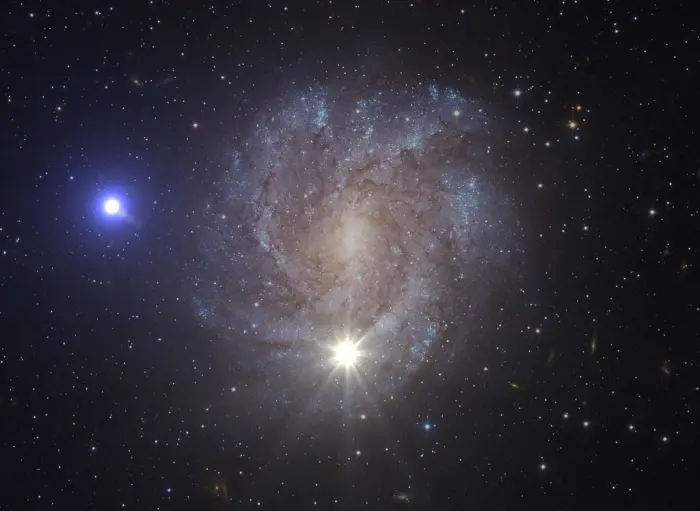
Illustration of the possible event that led to the high-speed ejection of US 708: a type Ia supernova. US 708 is a hyper velocity white dwarf in the Milky Way Galaxy. One of the fastest moving stars in the galaxy, it was first surveyed in 1982. Credit: ESA/Hubble, NASA, S. Geier (CC BY 4.0)
Deep sky objects in Ursa Major
Ursa Major is best-known for its many bright galaxies. Even though it is the third largest constellation in the sky, it does not have any particularly bright star clusters or diffuse nebulae.
Ursa Major contains seven objects listed in the Messier catalogue. One of these, Messier 40, is an optical double star. Of the remaining six objects, one is the planetary nebula Messier 97 – the famous Owl Nebula – and the others are galaxies. All five Messier galaxies in Ursa Major – Bode’s Galaxy (M81), the Cigar Galaxy (M82), the Pinwheel Galaxy (M101), the Surfboard Galaxy (M108), and M109 – can be found using the bright stars of the Big Dipper.
The Great Bear constellation does not contain any Caldwell objects, but it is home to as many as 46 deep sky objects listed in the Herschel 400 catalogue. All of them are galaxies. Only the constellation Virgo, the home of the Virgo Cluster, contains more objects included on the Herschel 400 observing list. Deep sky objects listed in the Messier, Caldwell and Herschel 400 catalogues can be observed in amateur telescopes.
Owl Nebula – Messier 97 (M97, NGC 3587)
The Owl Nebula (M97) is a planetary nebula located between 2,030 and 2,800 light-years away. It appears near Merak (Beta UMa) and the spiral galaxy Messier 108 in the sky. It is believed to be about 8,000 years old.
The nebula formed when an evolved red giant star on the asymptotic giant branch (AGN) reached the end of its life and expelled its outer layers. The hot central stellar remnant ionizes the surrounding clouds of material, making them glow.
The Owl Nebula is one of the brightest planetary nebulae in the sky. It is one of only four planetary nebulae listed in the Messier catalogue, along with the Ring Nebula (M57) in the constellation Lyra, the Dumbbell Nebula (M27) in Vulpecula, and the Little Dumbbell Nebula (M76) in Perseus.
The nebula Messier 97 has an apparent magnitude of 9.9 and an apparent size of 3.4 by 3.3 arcminutes. It has a physical radius of 0.91 light years. The nebula is known for its owl-like “eyes” that can be seen in larger telescopes. It has a 14th magnitude central star with an effective temperature of 123,000 K.
The Owl Nebula was discovered by the French astronomer Pierre Méchain on February 16, 1781. Even though it is bright and large, it requires exceptionally good conditions to be seen. It appears 2.5 degrees southeast of Merak.
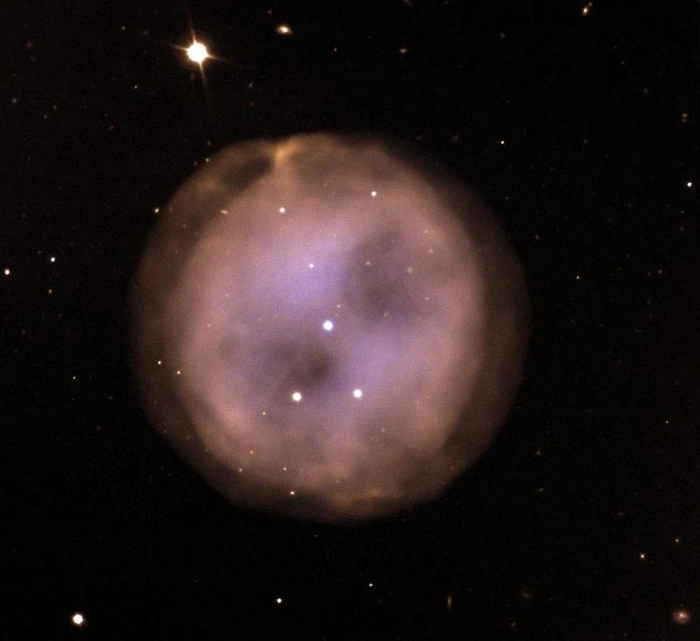
Owl Nebula (M97), image credit: ESO/Digitized Sky Survey 2 (CC BY 4.0)
Bode’s Galaxy – Messier 81 (M81, NGC 3031)
Bode’s Galaxy (M81) is a grand design spiral galaxy located approximately 11.8 million light-years away. With an apparent magnitude of 6.94 and an apparent size of 26.9 by 14.1 minutes of arc, it is the third brightest spiral galaxy in the sky, after the Andromeda Galaxy (Messier 31) in the constellation Andromeda and the Triangulum Galaxy (Messier 33) in Triangulum.
Bode’s Galaxy is a popular target for amateur astronomers and astrophotographers. It makes a striking pair with the nearby Cigar Galaxy (Messier 82). The galaxies can be spotted in binoculars and small telescopes.
M81 and M82 are among the most studied galaxies in the sky. Their brightness and proximity make them a frequent target for observations. These galaxies provide astronomers with insights into star formation and the evolution of interacting galaxies in galaxy groups.
Messier 81 is the brightest member of the Messier 81 Group, a group of 34 galaxies that includes Messier 82, IC 2574 (Coddington’s Nebula), NGC 4236, NGC 2366, NGC 2403, NGC 2976, NGC 3077, UGC 5692, UGCA 133, Holmberg II, and Holmberg IX. These galaxies lie in the constellations Ursa Major, Camelopardalis, and Draco.
M81 is in the process of interacting with M82 and the smaller disrupted elliptical galaxy NGC 3077. As a result of the interactions between the galaxies, hydrogen gas has been stripped away from all three and gaseous filamentary structures have formed within the group. Another consequence of the gravitational interactions is the vigorous star forming activity caused by interstellar gas falling into the centres of Messer 82 and NGC 3077.
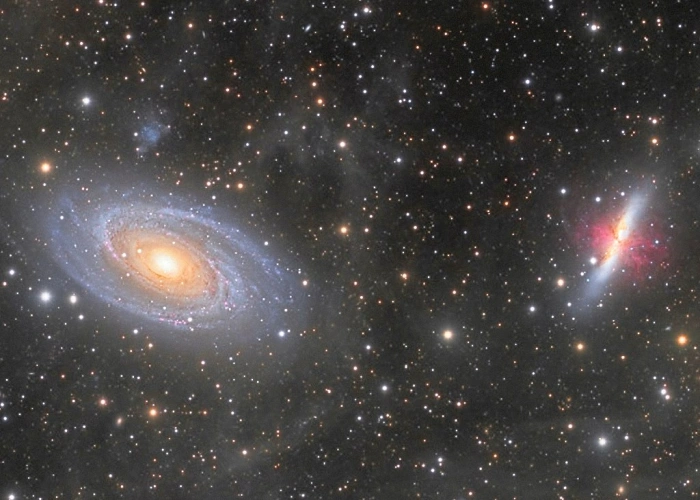
Messier 81 – 82 and Integrated Flux Nebula Credits: Leonardo Ciuffolotti, Andrea Pistocchini, Giuseppe Nicosia, Alessandro Falesiedi, Tim Stone, Giuseppe Donatiello (CC0 1.0)
The M81 Group is one of the nearest galaxy groups to the Local Group. It lies within the larger Virgo Supercluster.
Bode’s Galaxy has a diameter of 96,000 light-years. It contains a supermassive black hole with a mass of 70 million solar masses. The central black hole has a relativistic jet and an accretion disk. The galaxy may have a second supermassive black hole that orbits the primary one with a period of about 30 years.
M81 is home to around 210 globular clusters and numerous star formation regions. It hosted a supernova, SN 1993J, observed on March 28, 1993. At the time of discovery, SN 1993J was the second brightest type II supernova detected in the 20th century. It shone at magnitude 10.7 at its peak.
Bode’s Galaxy was named after the German astronomer Johann Elert Bode, who discovered it on December 31, 1774. In 1779, Charles Messier identified the galaxy independently and included it in his catalogue.
M81 appears around 10 degrees northwest of Dubhe (Alpha UMa). It can be found by drawing a line from Phecda (Gamma UMa) through Dubhe and extending it by about the same distance as that between the two stars. The Cigar Galaxy appears in the same field of view.
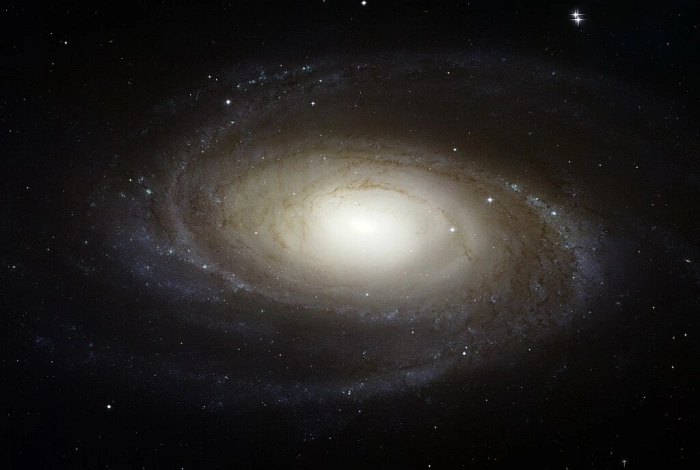
The spiral galaxy Messier 81 is tilted at an oblique angle on to our line of sight, giving a “birds-eye view” of the spiral structure. The galaxy is similar to our Milky Way, but our favorable view provides a better picture of the typical architecture of spiral galaxies. Though the galaxy is 11.6 million light-years away, NASA Hubble Space Telescope’s view is so sharp that it can resolve individual stars, along with open star clusters, globular star clusters, and even glowing regions of fluorescent gas. Credit: NASA, ESA and the Hubble Heritage Team (STScI/AURA) (PD)
Cigar Galaxy – Messier 82 (M82, NGC 3034)
The Cigar Galaxy (M82) is one of the nearest starburst galaxies to the Milky Way. It lies 11.4 – 12.4 million light-years away and has an apparent magnitude of 8.41. It appears edge-on from our point of view. The galaxy has an apparent size of 11.2 by 4.3 arcminutes
Messier 82 is the second largest member of the Messier 81 Group. It has an isophotal diameter of about 40,800 light-years. The galaxy has five times the luminosity of the Milky Way and its core region is about a hundred times more luminous. The starburst activity in M82 was triggered by the interaction with the nearby Messier 81. The galaxy’s starburst core contains 197 massive clusters of young stars, discovered by the Hubble Space Telescope in 2005. Star formation that occurs in the galaxy’s core is ten times faster than star formation in the entire Milky Way.
Messier 82 is usually classified as an irregular galaxy. However, it has two spiral arms that were only discovered in the near-infrared band in 2005. Astronomers had previously missed them because of the high surface brightness of M82’s disk and the inclination of the galaxy.
The Cigar Galaxy hosted several observed supernovae in recent decades. The type II supernova SN 2004am was discovered in March 2004. The radio transient SN 2008iz was detected in 2008. The supernova, SN 2014J, observed on January 21, 2014. It was classified as a type Ia supernova and peaked at magnitude 10.1.
The Cigar Galaxy is believed to have had at least one tidal encounter with Messier 81 and, as a result, a large amount of gas ended up funneled into its core in the last 200 million years. Consequently, star forming activity in the galaxy has increased tenfold compared to most other galaxies.
M82 was discovered by Johann Elert Bode on December 31, 1774, along with M81. Bode originally described both galaxies as nebulous patches.
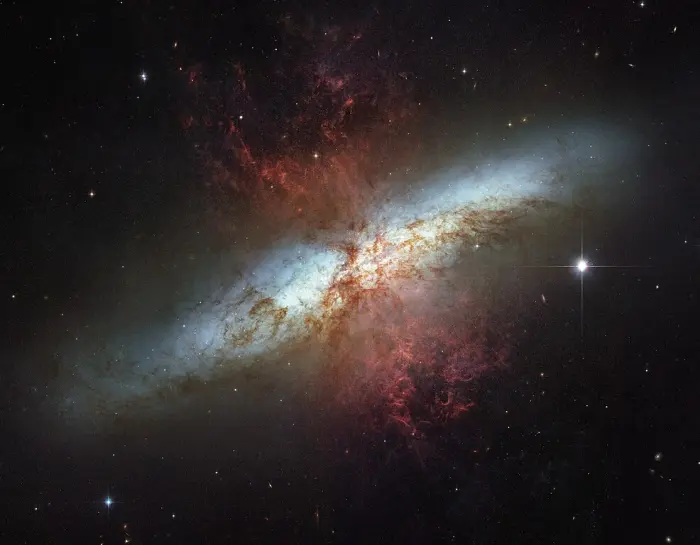
To celebrate the Hubble Space Telescope’s 16 years of success, the two space agencies involved in the project, NASA and the European Space Agency (ESA), are releasing this image of the magnificent starburst galaxy, Messier 82 (M82). This mosaic image is the sharpest wide-angle view ever obtained of M82. The galaxy is remarkable for its bright blue disk, webs of shredded clouds, and fiery-looking plumes of glowing hydrogen blasting out of its central regions. Throughout the galaxy’s center, young stars are being born 10 times faster than they are inside our entire Milky Way Galaxy. The resulting huge concentration of young stars carved into the gas and dust at the galaxy’s center. The fierce galactic superwind generated from these stars compresses enough gas to make millions of more stars. Image credit: NASA, ESA, and The Hubble Heritage Team (STScI/AURA) (PD)
Pinwheel Galaxy – Messier 101 (M101, NGC 5457)
The Pinwheel Galaxy (M101) is a grand design spiral galaxy located approximately 21.6 million light-years away. The galaxy appears face-on and lies in the region of the Big Dipper’s handle. It forms a triangle with Alkaid and Mizar.
Messier 101 is an intermediate spiral galaxy, between a barred and an unbarred spiral. With a diameter of 252,000 light-years, it is more than twice the size of the Milky Way. It hosts about a trillion stars and has an estimated population of 150 globular clusters.
The galaxy is known for its many H II regions, ionized by the intense light of massive, luminous young stars. Some of its stellar nurseries have their own designations in the New General Catalogue (NGC).
The Pinwheel Galaxy has an apparent magnitude of 7.9 and an apparent size of 28.8 by 26.9 arcminutes. It is one of the brightest and largest spiral galaxies in the sky. It was discovered by Pierre Méchain on March 27, 1781. Méchain’s friend and colleague Charles Messier included the galaxy in his catalogue.
Pierre Méchain described Messier 101 as a “nebula without star, very obscure and pretty large, 6′ to 7′ in diameter, between the left hand of Boötes and the tail of the great Bear. It is difficult to distinguish when one lits the [grating] wires.”
Even though it is bright and large, the Pinwheel Galaxy requires exceptionally good conditions to be seen. It can be spotted in binoculars on a clear night, but to see its spiral arms one needs a larger telescope.
The grand design pattern of the Pinwheel Galaxy is suspected to be a result of the interaction between the galaxy and its companions. M101 has six prominent companions: NGC 5474, NGC 5204, NGC 5477, NGC 5585, UGC 9405, and Holmberg IV (UGC 8837). These galaxies are members of the M101 Group, a loose galaxy group within the Virgo Supercluster.
The Pinwheel Galaxy has hosted six observed supernovae: SN 1909A in 1909, SN 1951H in 1951, SN 1970G in 1970, SN 2011fe in 2011, the luminous red nova M101 OT2015-1 in 2015, and SN 2023ixf in 2023.
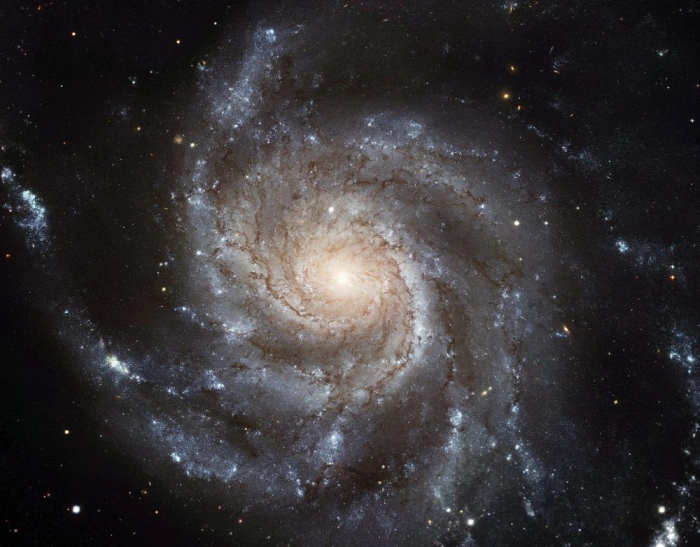
The galaxy Messier 101 (M101, also known as NGC 5457 and also nicknamed the Pinwheel Galaxy) lies in the northern circumpolar constellation, Ursa Major (The Great Bear), at a distance of about 21 million light-years from Earth. This is one of the largest and most detailed photos of a spiral galaxy that have been released from Hubble. The galaxy’s portrait is actually composed of 51 individual Hubble exposures, in addition to elements from images from ground-based photos. Image credit: European Space Agency & NASA; Acknowledgements: K.D. Kuntz (GSFC), F. Bresolin (University of Hawaii), J. Trauger (JPL), J. Mould (NOAO), and Y.-H. Chu (University of Illinois, Urbana), Davide De Martin (ESA/Hubble), CFHT image: Canada-France-Hawaii Telescope/J.-C. Cuillandre/Coelum, NOAO image: George Jacoby, Bruce Bohannan, Mark Hanna/NOAO/AURA/NSF (CC BY 4.0)
Surfboard Galaxy – Messier 108 (M108, NGC 3556)
The Surfboard Galaxy (M108) is a barred spiral galaxy located 46 million light years away. With an apparent visual magnitude of 10.0, it can be observed in a small telescope. The galaxy was discovered by Pierre Méchain on February 19, 1781. From our perspective, the galaxy appears nearly edge-on. It has an apparent size of 8.7 by 2.2 arcminutes. It appears near Merak and the Owl Nebula (M97) in the sky.
M108 is an isolated member of the Ursa Major Cluster, a spiral-rich galaxy cluster within the Virgo Supercluster. The galaxy contains about 290 globular clusters and 83 X-ray sources, including one in the galaxy’s core. The supermassive black hole at the centre of M108 has an estimated mass of 24 million solar masses.
The galaxy has hosted three observed supernovae: SN 1969B in 1969, SPIRITS 16tn in 2016, and SN 2023dbc in 2023. SPIRITS 16tn was only visible at infrared wavelengths because it was obscured by the intervening dust.
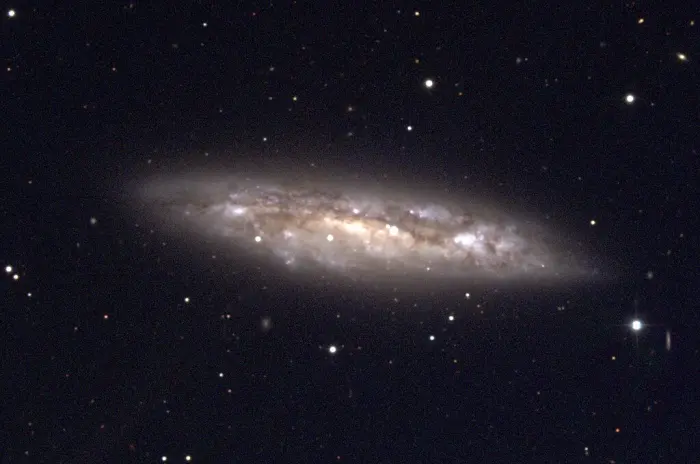
M108 is a type Sc spiral galaxy in the constellation Ursa Major. Almost edge-on, it shows little or no bulge and no noticeably strong center, being a motley collection of features often referred to, in classic understatement, as very dusty. The spiral structure is not very clearly delineated, unsurprisingly. M108 is around 40 to 50 million light-years away in a loose galaxy grouping which includes M109 and possibly M106. This picture was created from observations using the T2KA CCD camera at the Kitt Peak National Observatory’s 0.9-meter telescope in January of 1997. Credit: NOIRLab/NSF/AURA (CC BY 4.0)
Messier 109 (M109, NGC 3992)
Messier 109 (M109), sometimes known as the Vacuum Cleaner Galaxy, is a barred spiral galaxy located approximately 67.2 million light-years away. It is the most distant object listed in the Messier catalogue. It appears just southeast of Phecda (Gamma UMa).
Messier 108 has a diameter of 176,170 light-years. It has an apparent magnitude of 9.8 and an apparent size of 7.6 by 4.7 minutes of arc.
M109 is the most prominent member of the M109 Group (the Ursa Major Cloud), a large group consisting of more than 50 galaxies in Ursa Major. M109 has three known satellite galaxies, UGC 6923, UGC 6940, and UGC 6969. Other members of the M109 Group include the galaxies NGC 3718, NGC 3726, NGC 3729, NGC 3877, NGC 3893, and NGC 3949.
A type Ia supernova, SN 1956A, was seen in the galaxy in 1956. So far it has been the only supernova observed in M109.
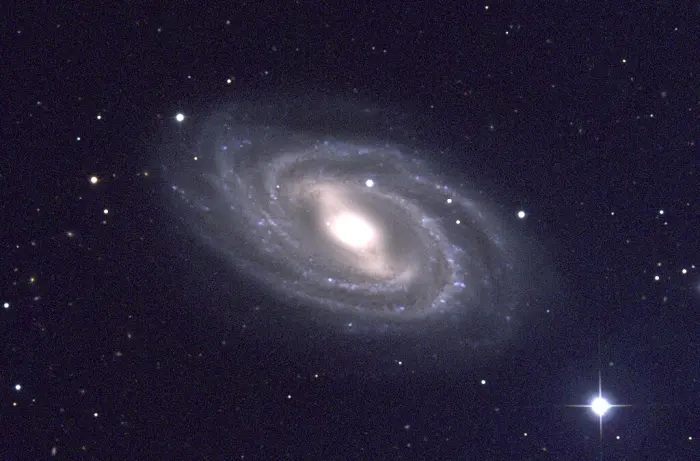
M109 is a type SBc barred spiral galaxy in the constellation Ursa Major. M109 is around 40 to 50 million light-years away in a loose galaxy grouping which includes M108 and possibly M106. This picture was created from observations using the T2KA CCD camera at the Kitt Peak National Observatory’s 0.9-meter telescope in January of 1997. Credit: NOIRLab/NSF/AURA (CC BY 4.0)
NGC 5474
NGC 5474 is a peculiar dwarf galaxy located 21.1 million light years from the solar system. It interacts with the larger Pinwheel Galaxy (M101). It is the closest companion to M101.
NGC 5474 has a visual magnitude of 11.3. The galaxy is heavily distorted by the tidal interactions with its larger neighbour. The galaxy’s disk is offset from the nucleus, and so is the star formation.
The galaxy is often classified as a dwarf spiral galaxy because it shows signs of a spiral structure. It was discovered by William Herschel on May 1, 1788.
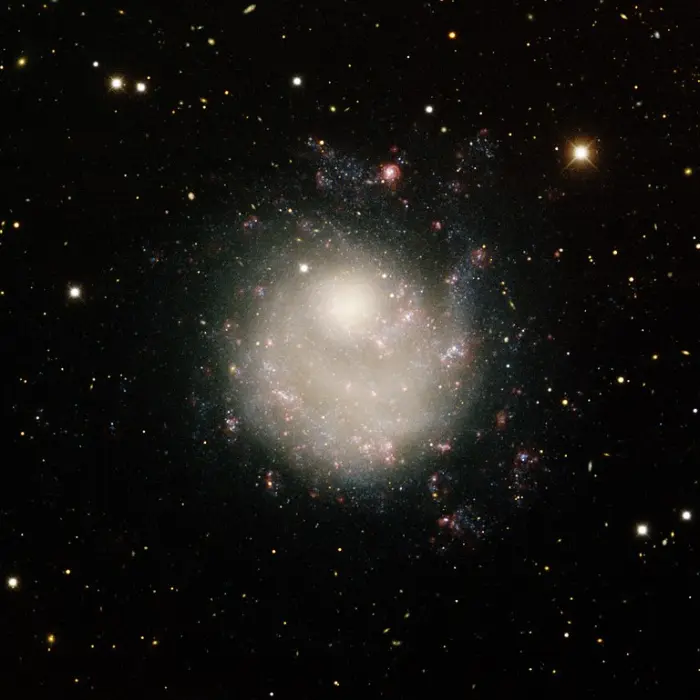
Located in the constellation Ursa Major, NGC 5474 is a dwarf galaxy and nearest companion to the large spiral galaxy M101. Strong gravitational interactions with M101 have distorted the shape of NGC 5474, triggering star formation and offsetting the nucleus of the galaxy from the disk. This image was obtained with the wide-field view of the Mosaic Camera on the Mayall 4-meter telescope at Kitt Peak National Observatory. Credit: T.A. Rector/University of Alaska Anchorage, H. Schweiker/WIYN and NOIRLab/NSF/AURA (CC BY 4.0)
Helix Galaxy (NGC 2685)
The Helix Galaxy (NGC 2685) is a lenticular polar ring galaxy located 48.2 million light-years away. It is one of the nearest polar ring galaxies to the Sun. It has an outer ring of stars and gas that rotates over the galaxy’s poles.
NGC 2685 has an apparent magnitude of 11.3 and appears near Muscida (Omicron UMa), in the region of the Great Bear’s head. The galaxy was discovered by the German astronomer Wilhelm Tempel on August 18, 1882.
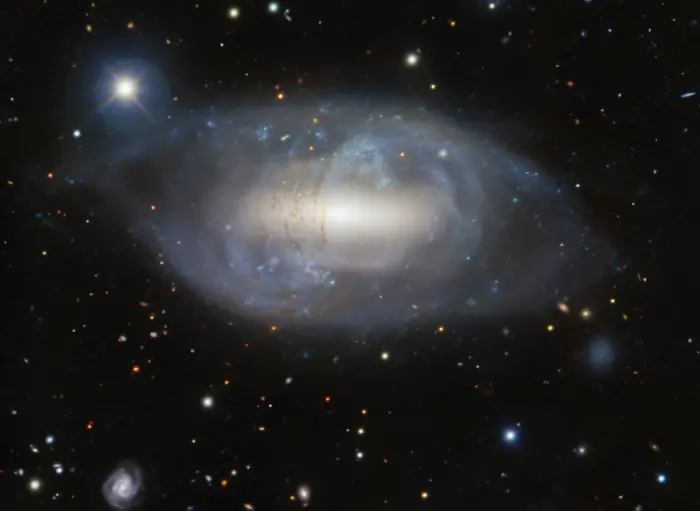
The very unusual galaxy NGC 2685, also known as the Helix Galaxy, is located about 40 million light-years away in the constellation Ursa Major. This image was captured by the Gemini North telescope, one half of the International Gemini Observatory, operated by NSF NOIRLab which is funded by the U.S. National Science Foundation. NGC 2685 is a peculiar lenticular galaxy known as a polar ring galaxy. A ring of gas, stars, and dust orbits NGC 2685 perpendicular to the flat plane of the host galaxy. This odd crossing of planes is believed to be evidence of galaxy interactions, mergers, or tidal accretion events. Current research suggests that the present structure of NGC 2685 was formed when it captured material from another galaxy, which was strung out into an encircling ring. This galaxy is one of our closest known polar ring galaxies and is therefore one of the easiest of its kind to study. Image credit: International Gemini Observatory/NOIRLab/NSF/AURA/L. Bassino Image processing: J. Miller (Gemini Observatory/NSF’s NOIRLab), M. Rodriguez (Gemini Observatory/NSF’s NOIRLab), & M. Zamani (NSF’s NOIRLab) (CC BY 4.0)
NGC 2787
NGC 2787 is a barred lenticular galaxy located 24 million light-years away. It appears in the same area as the Messier 81 and Messier 82 pair. It has an apparent magnitude of 11.79.
The galaxy was discovered by William Herschel on December 3, 1788. It is notable for its high mass-to-light ratio. It has a LINER nucleus (low-ionization nuclear emission-line region) with a supermassive black hole.
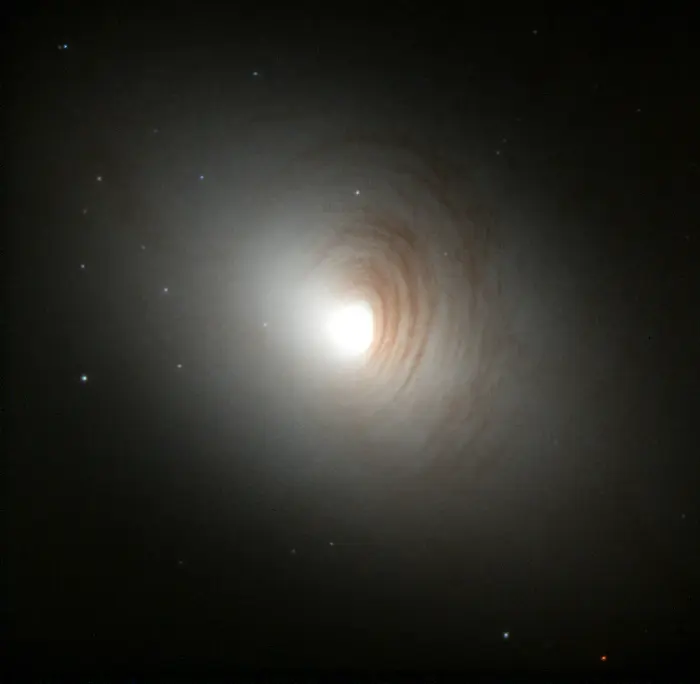
NGC 2787, credit: NASA and The Hubble Heritage Team (STScI/AURA) (PD)
NGC 3079
NGC 3079 is a barred spiral galaxy located 50 million light-years away. It appears near Phi Ursae Majoris. It has an apparent magnitude of 11.5 and an apparent size of 7.9 by 1.4 arcminutes.
The galaxy is around 135,600 light-years across. It is classified as a Seyfert II galaxy. It has a bright, quasar-like nucleus and a supermassive black hole. The galaxy has a prominent bubble about 3,000 light years wide, forming in the galaxy’s centre and rising over 3,500 light-years above the galactic disk. Astronomers believe that the bubble is formed by high-speed particles that are produced by an intense burst of star formation.
NGC 3079 was discovered by William Herschel on April 1, 1790. It is the brightest member of the NGC 3079 Group, which also includes NGC 3073, UGC 5479, UGC 5421, UGC 5460, and UGC 5459.
NGC 3079 hosted two observed supernovae – SN 2001ci and SN 2013ee – detected in 2001 and 2013.
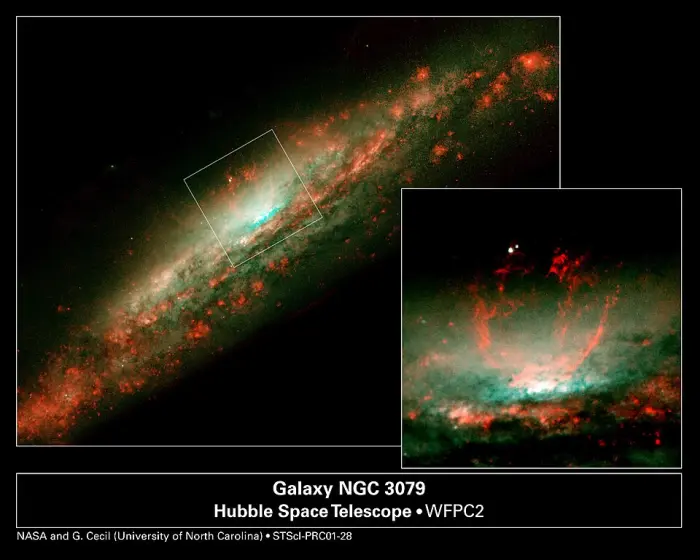
NGC 3079, credit: G. Cecil (U. North Carolina, Chapel Hill), S. Veilleux (U. Maryland, College Park), J. Bland-Hawthorn (AAO), and A. Filippenko (UC Berkeley) (PD)
UGC 5460
UGC 5460 is a barred spiral galaxy located 61.4 million light-years away. It is a member of the NGC 3079 Group. The galaxy has an estimated size of 43,900 light-years. It hosted two supernovae that were observed in recent decades.
SN 2011ht was a type IIn supernova with an apparent magnitude of 17, discovered by Scottish amateur astronomer Tom Boles in September 2011.
SN 2015as was a type IIb supernova discovered by Ken’ichi Nishimura on November 15, 2015. It had a visual magnitude of 16.
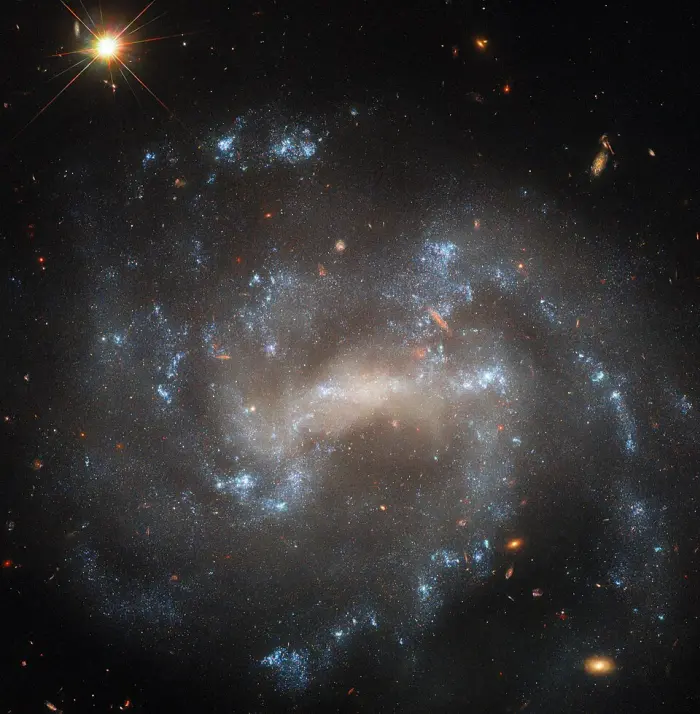
The sparkling spiral galaxy gracing this NASA/ESA Hubble Space Telescope Picture of the Week is UGC 5460, which sits about 60 million light-years away in the constellation Ursa Major. This image combines four different wavelengths of light to reveal UGC 5460’s central bar of stars, winding spiral arms and bright blue star clusters. Also captured in the upper left-hand corner of this image is a far closer object: a star just 577 light-years away in our own galaxy. Credit: ESA/Hubble & NASA, W. Jacobson-Galán, A. Filippenko, J. Mauerhan (CC BY 4.0)
Bow and Arrow Galaxy (NGC 3310)
The Bow and Arrow Galaxy (NGC 3310) is a grand design spiral galaxy located 34.8 million light-years away. It has an apparent magnitude of 11.2 and an apparent size of 3.1 by 2.4 arcminutes. It is about 22,000 light-years across. The galaxy is undergoing starburst activity, likely as a result of collision with a smaller satellite galaxy.
NGC 3310 was discovered by William Herschel on April 12, 1789. Three supernovae were detected in the galaxy in recent decades. The supernova SN 1974C (mag. 16.5) was discovered on February 26, 1974. The type Ib/c supernova SN 1991N (mag. 15) was spotted on March 29, 1991, and the type IIP supernova SN 2021gmj (mag. 15.1) was discovered on March 20, 2021.
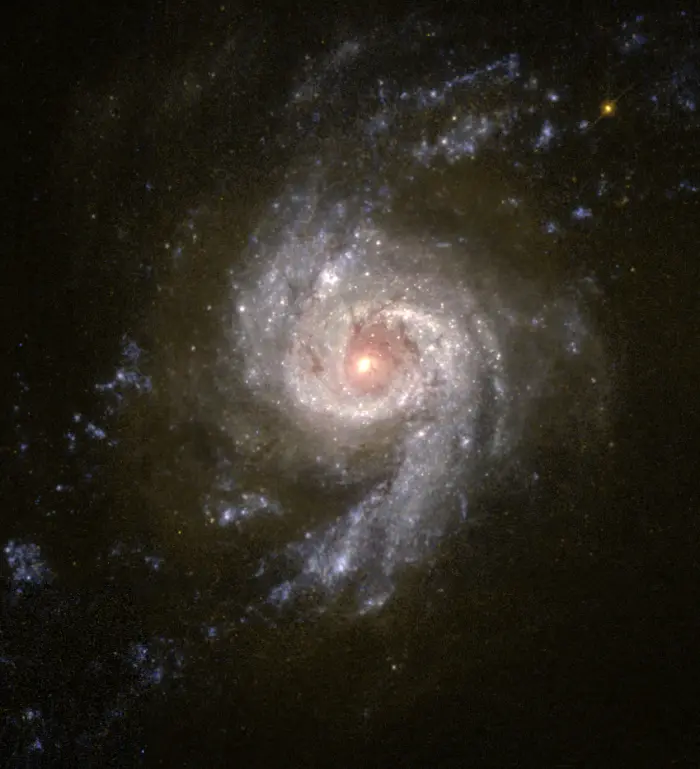
The Bow and Arrow Galaxy (NGC 3310), credit: NASA and The Hubble Heritage Team (STScI/AURA) (PD)
NGC 4013
NGC 4013 is an edge-on barred spiral galaxy located 60.6 million light-years away. It has an apparent magnitude of 12.1 and an apparent size of 5.2 by 1 arcminutes. The galaxy is a member of the Ursa Major Cluster, a cluster of galaxies within the larger Virgo Supercluster that also includes the galaxies Messier 109, NGC 3953, NGC 3938 and NGC 4051. These galaxies appear in the same area as NGC 4013.
NGC 4013 features a tidal stream of stars that extends for more than 80,000 light-years from the galaxy’s core. The stream is believed to be what is left of a smaller galaxy that collided with its large neighbour.
The galaxy was discovered by William Herschel on February 6, 1788. It hosted a supernova, SN 1989Z, that shone at magnitude 12.
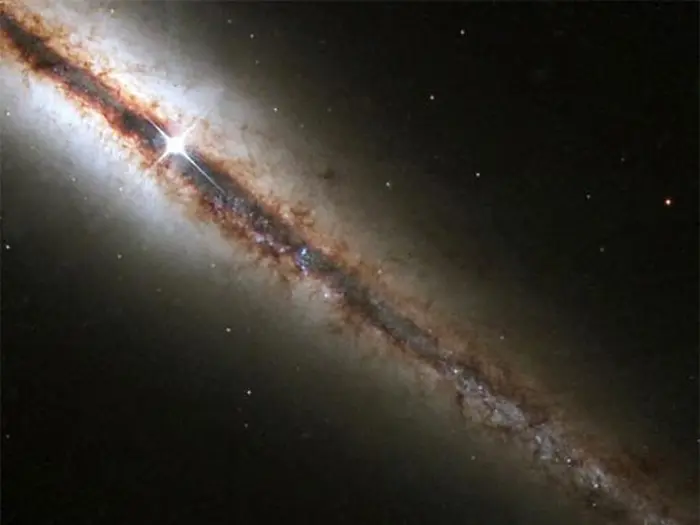
An amazing “edge-on” view of a spiral galaxy 55 million light years from Earth has been captured by the Hubble Space Telescope. The image reveals in great detail huge clouds of dust and gas extending along and above the galaxy’s main disk. Credit: NASA and the Hubble Heritage Team (STSci/AURA) (PD)
NGC 2768
NGC 2768 is a lenticular galaxy located at a distance of 63.5 million light years. With an apparent magnitude of 9.9 and an apparent size of 8.1 by 4.3 arcminutes, it can be observed in small and medium telescopes in good conditions.
NGC 2768 is a Seyfert galaxy with a supermassive black hole at its core. The bright central region is encircled by a dusty knotted ring.
The galaxy was discovered by William Herschel on March 19, 1790. It appears roughly halfway between Muscida (Omicron Ursae Majoris) and Upsilon Ursae Majoris.
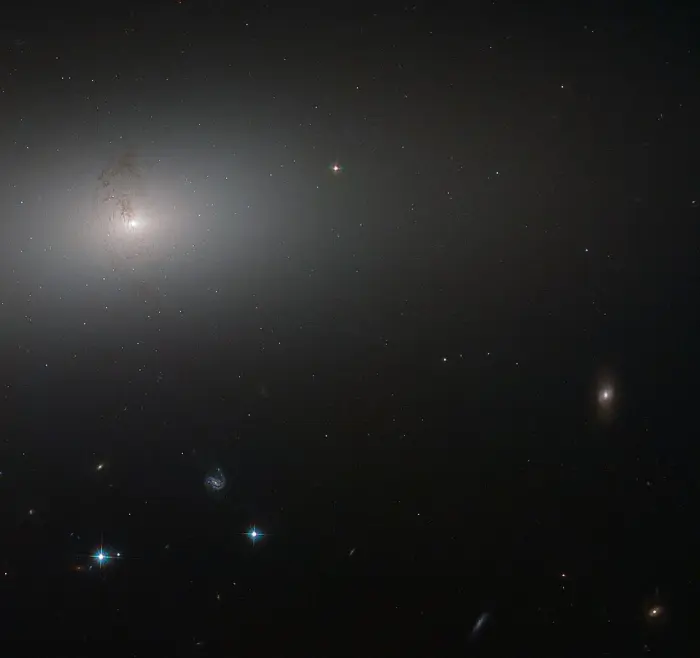
The soft glow in the picture above is NGC 2768, an elliptical galaxy located in the northern constellation of Ursa Major (The Great Bear). It appears here as a bright oval on the sky, surrounded by a wide, fuzzy cloud of material. This image, taken by the NASA/ESA Hubble Space Telescope, shows the dusty structure encircling the centre of the galaxy, forming a knotted ring around the galaxy’s brightly glowing middle. Interestingly, this ring lies perpendicular to the plane of NGC 2768 itself, stretching up and out of the galaxy. Credit: ESA/Hubble & NASA; Acknowledgment: Judy Schmidt (CC BY 4.0)
NGC 2841
NGC 2841 is an unbarred spiral galaxy located 46 million light-years away. It has an apparent magnitude of 10.1 and an angular size of 8.1 by 3.5 arcminutes. It appears near Theta Ursae Majoris in the sky.
NGC 2841 is the prototypical flocculent spiral galaxy, a galaxy with patchy and discontinuous spiral arms. It is classified as a LINER galaxy. It has a low-ionization nuclear emission-line region (LINER) at its centre.
The galaxy was discovered by William Herschel on March 9, 1788. It has hosted four observed supernovae in the past century.
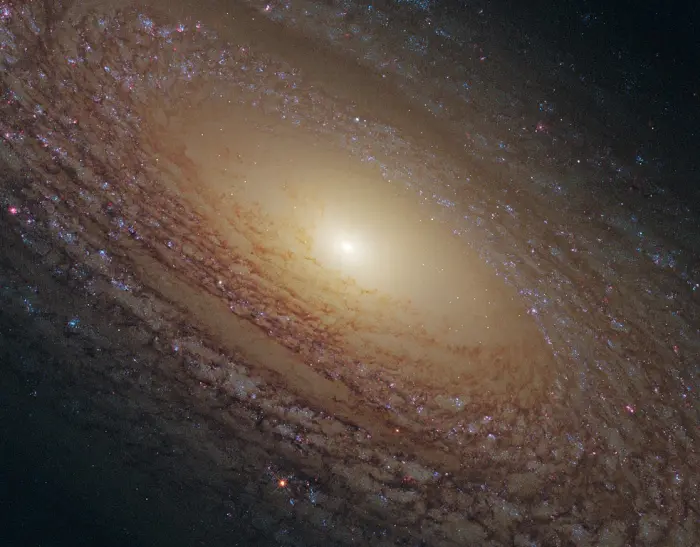
View of the spiral galaxy NGC 2841. A bright cusp of starlight marks the galaxy’s centre. Spiralling outward are dust lanes that are silhouetted against the population of whitish middle-aged stars. Much younger blue stars trace the spiral arms. Credit: NASA, ESA, and the Hubble Heritage (STScI/AURA)-ESA/Hubble Collaboration (PD)
NGC 2976
NGC 2976 is a peculiar dwarf galaxy located 11.6 million light-years away. It has an apparent magnitude of 16.90. The galaxy is a member of the M81 Group of galaxies and appears 1° 20’ southwest of the M81/M82 pair.
NGC 2976 was discovered by William Herschel on November 8, 1801. It is inclined 65° to our line of sight.
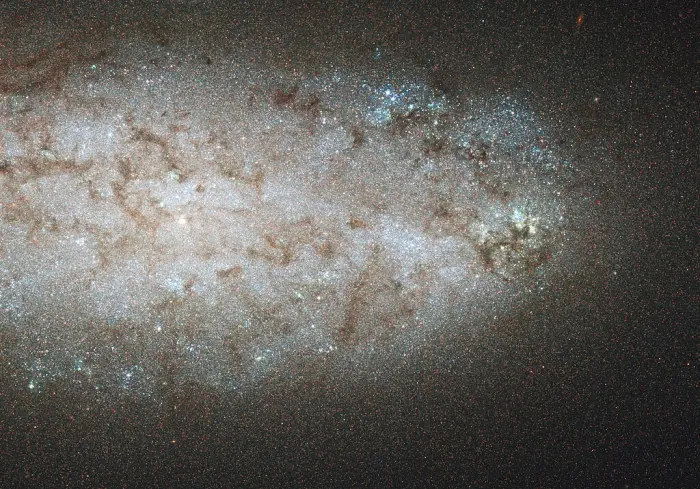
Astronomers were surprised to find that star-formation activities in the outer regions of NGC 2976 have been virtually asleep because they shut down millions of years ago. The celebration is confined to a few die-hard party-goers huddled in the galaxy’s inner region. The explanation, astronomers say, is that a raucous interaction with M81, a neighbouring group of hefty galaxies, ignited star birth in NGC 2976. Now the star-making fun is beginning to end. Images from NASA’s Hubble Space Telescope show that star formation in the galaxy began fizzling out in its outskirts about 500 million years ago as some of the gas was stripped away and the rest collapsed toward the centre. With no gas left to fuel the party, more and more regions of the galaxy are taking a much-needed nap. The star-making region is now confined to about 5,000 light-years around the core. Credit: NASA, ESA, and J. Dalcanton and B. Williams (University of Washington, Seattle) (PD)
NGC 2985
NGC 2985 is a spiral galaxy located approximately 70.1 million light-years away in Ursa Major, near the border with Draco. It was discovered by William Herschel on April 3, 1785. It has an apparent magnitude of 10.4 and an apparent size of 4.6 by 3.6 arcminutes.
The galaxy is 95,000 light-years across. It is inclined 37 degrees from our perspective. It has a bright nucleus and numerous molecular clouds where star formation is taking place in the galaxy’s inner regions.
NGC 2985 is classified as a LINER galaxy. It has an active galactic nucleus and an accretion disk around the central supermassive black hole.
NGC 2985 is the brightest galaxy in the NGC 2985 Group, which also includes the nearby NGC 3027, NGC 3252 and NGC 3403. The group lies north of the M81/M82 pair.
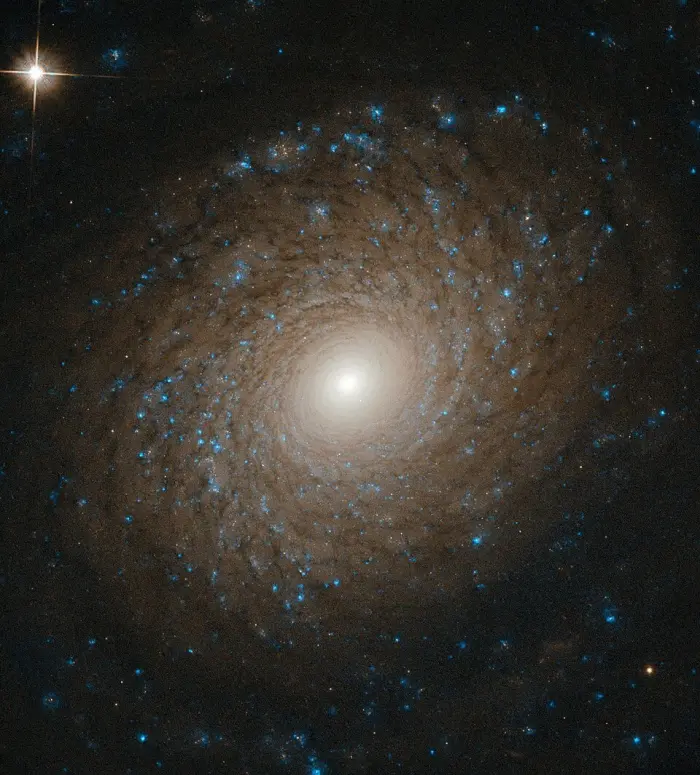
The intricate, near-perfect symmetry on display here reveals the incredible complexity of NGC 2985. Multiple tightly-wound spiral arms widen as they whorl outward from the galaxy’s bright core, slowly fading and dissipating until these majestic structures disappear into the emptiness of intergalactic space, bringing a beautiful end to their starry splendour. Credit: ESA/Hubble & NASA, L. Ho (CC BY 4.0)
NGC 3077
NGC 3077 is a disrupted dwarf galaxy that appears just southeast of Bode’s Galaxy. It is a member of the M81 Group. It lies 12.8 million light-years away and has an apparent visual magnitude of 10.6.
The small galaxy was discovered by William Herschel on November 8, 1801. Its peculiar appearance is the result of interaction with its larger neighbours.
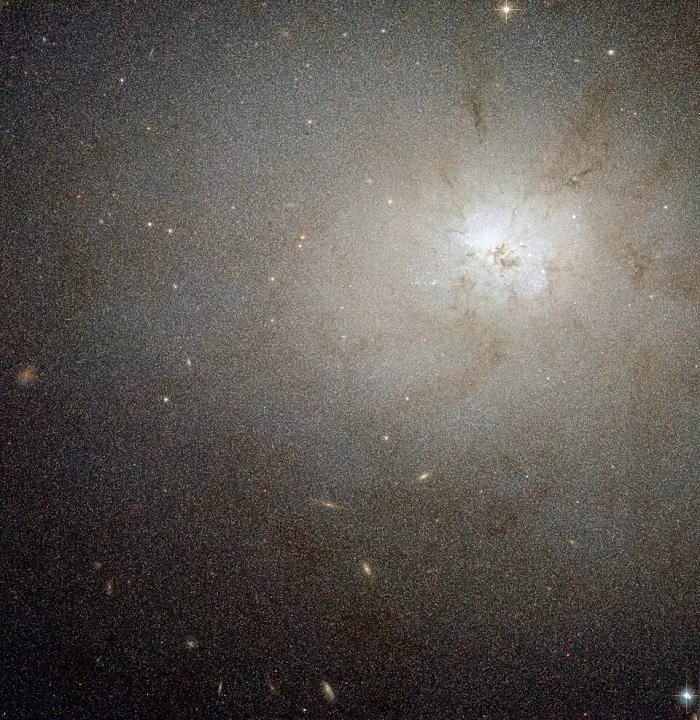
At first glance NGC 3077 looks like a typical, relatively peaceful elliptical galaxy. However, as this NASA/ESA Hubble Space Telescope image dramatically reveals it is actually a hotbed of very energetic star formation and the whole galaxy is laced with dusty tendrils. Although overshadowed by its brighter neighbours M81 and M82, NGC 3077 is also very active and resembles a less dramatic version of Messier 82. Interactions between the three galaxies have stoked the fires of star formation in the core of the galaxy and the brilliant glow of many huge young star clusters at the centre of NGC 3077 dominates the Hubble image. If you look closely you can see vast numbers of individual stars in the galaxy across the entire image, as well as several, much more remote, galaxies seen through the much closer NGC 3077. This picture was created from images taken using the Wide Field Channel on Hubble’s Advanced Camera for Surveys. It was made from images through blue (F475W, coloured blue), orange (F606W, coloured green) and near-infrared (F814W, coloured red) filters. The exposure times were about 27 minutes per filter. The field of view extends over about 3.3 arcminutes. Credit: ESA/Hubble & NASA (CC BY 3.0)
Little Pinwheel Galaxy (NGC 3184)
The Little Pinwheel Galaxy is an unbarred spiral galaxy located approximately 39.8 light-years away. It appears next to Tania Australis (Mu Ursae Majoris) in the sky. The galaxy has an apparent magnitude of 10.4 and an angular size of 7.4 by 6.9 arcminutes.
Named for its resemblance to the brighter and larger Pinwheel Galaxy (Messier 101), NGC 3184 has two symmetrical spiral arms and appears face-on. It is about 55,000 light-years across. It was discovered by William Herschel on March 18, 1787.
The Little Pinwheel Galaxy hosted seven observed supernovae and transient events in the past century. The most recent one, AT 2019sfe, was discovered on October 8, 2019.
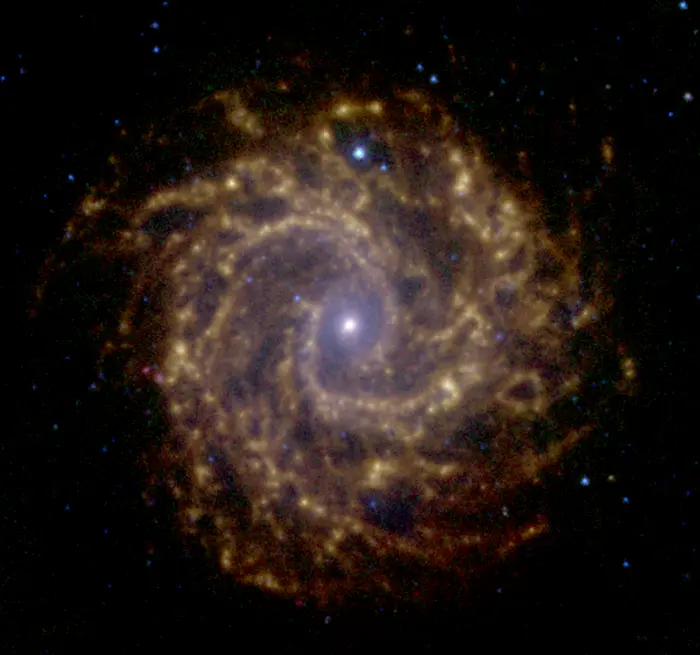
The Little Pinwheel Galaxy (NGC 3184), image credit: Médéric Boquien, from the data retrieved on the SINGS project public archives of the Spitzer Space Telescope (courtesy NASA/JPL-Caltech) (CC BY 3.0)
Mayall’s Object
Mayall’s Object is a pair of colliding galaxies located 450 million light-years away. It is the product of a collision that appears as a ring-shaped galaxy with a tail.
The colliding pair was named after American astronomer Nicholas U. Mayall, who discovered it in March 1940. Mayall’s Object lies near Psi and Omega Ursae Majoris in the sky.
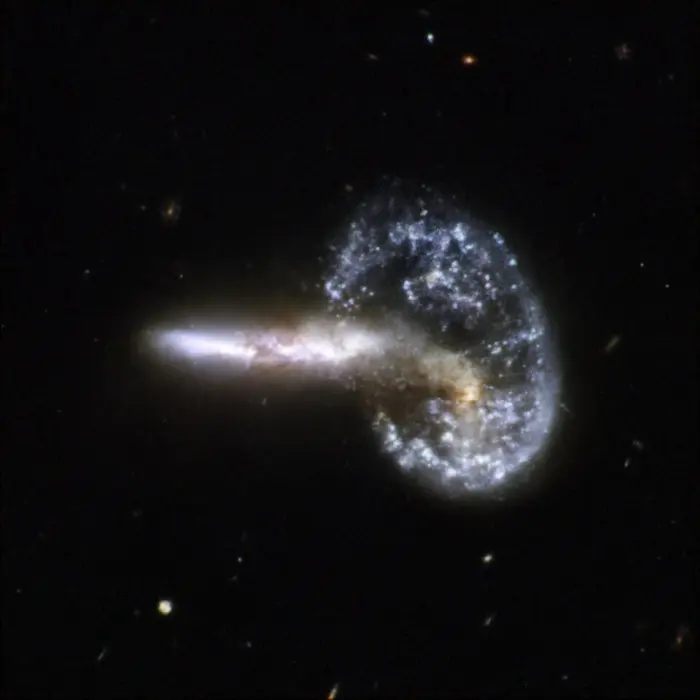
Mayall’s object is the staggering aftermath of an encounter between two galaxies, resulting in a ring-shaped galaxy and a long-tailed companion. The collision between the two parent galaxies produced a shockwave effect that first drew matter into the center and then caused it to propagate outwards in a ring. The elongated companion perpendicular to the ring suggests that Arp 148 is a unique snapshot of an ongoing collision. Credit: NASA, ESA, the Hubble Heritage (STScI/AURA)-ESA/Hubble Collaboration, and A. Evans (University of Virginia, Charlottesville/NRAO/Stony Brook University) (PD)
NGC 3198
NGC 3198 is a barred spiral galaxy located 47 million light-years away. It appears near Tania Borealis in the sky. It was discovered by William Herschel on January 15, 1788. The galaxy has an apparent magnitude of 10.3 and is around 121,800 light-years across.
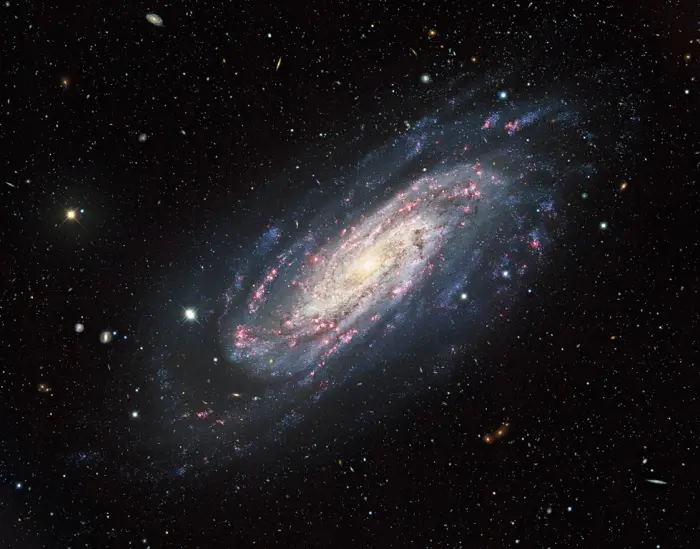
This stunning image features NGC 3198, a galaxy that lies about 47 million light-years away in the constellation Ursa Major. This image was taken with the Mosaic instrument on the 4-meter Nicholas U. Mayall Telescope at Kitt Peak National Observatory, a Program of NSF’s NOIRLab, and shows the full extent of the galaxy, from the bright central bulge to the tenuous outer reaches of the tightly-wound spiral arms. Credit: KPNO/NOIRLab/NSF/AURA; Acknowledgements: M T. Patterson (New Mexico State University); Image processing: Travis Rector (University of Alaska Anchorage), Mahdi Zamani & Davide de Martin (CC BY 4.0)
NGC 3610
NGC 3610 is an elliptical galaxy located 106 million light years away. It has an apparent visual magnitude of 11.63. It appears within the Big Dipper bowl. The galaxy was discovered by William Herschel on April 8, 1793.
NGC 3610 is still a young elliptical galaxy that has not yet lost its disk. It is believed to be the product of a merger that occurred about 4 ± 2.5 billion years ago.
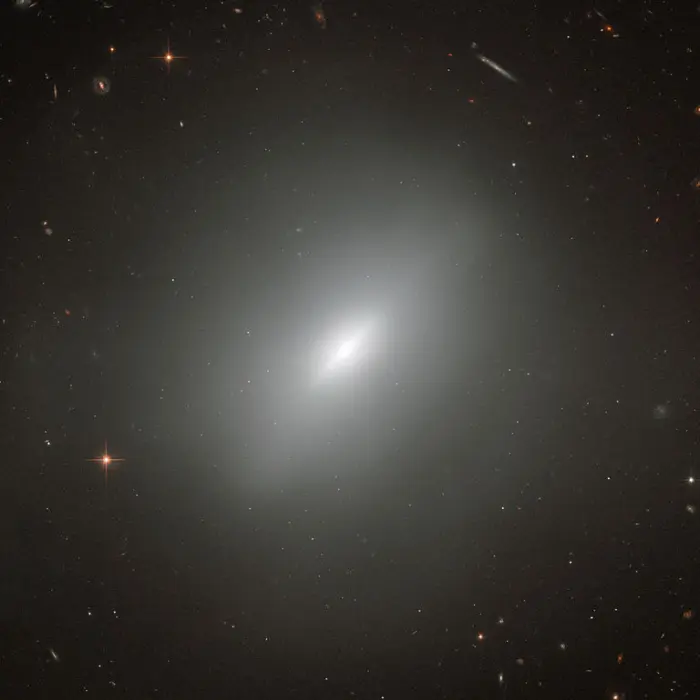
At the centre of this amazing image is the elliptical galaxy NGC 3610. Surrounding the galaxy are a wealth of other galaxies of all shapes. There are spiral galaxies, galaxies with a bar in their central regions, distorted galaxies and elliptical galaxies, all visible in the background. In fact, almost every bright dot in this image is a galaxy — the few foreground stars are clearly distinguishable due to the diffraction spikes that overlay their images. Credit: ESA/Hubble & NASA; Acknowledgement: Judy Schmidt (Geckzilla) (CC BY 4.0)
NGC 3619
NGC 3619 an unbarred lenticular galaxy located approximately 87 million light-years away in the Big Dipper’s bowl. It has an apparent magnitude of 12.6. It was discovered by William Herschel on March 18, 1790.
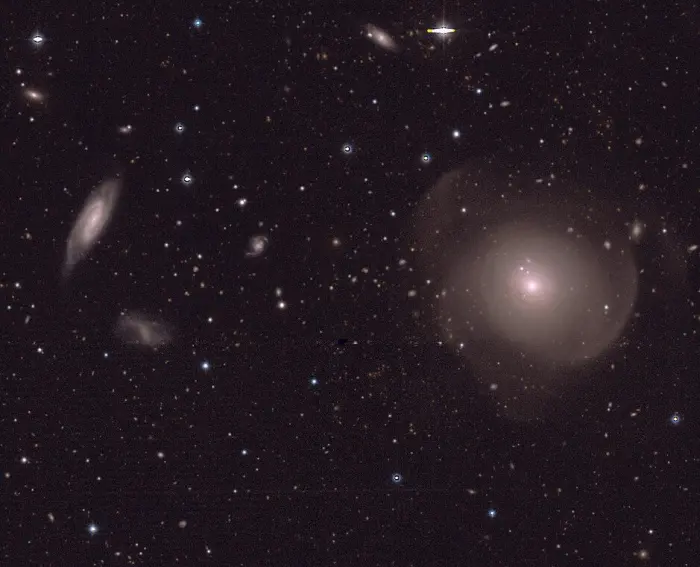
NGC 3619, NGC 3625 & UGC 6344, image: Legacy Surveys / D. Lang (Perimeter Institute), NERSC (CC BY 4.0)
NGC 3631
NGC 3631 is a grand design spiral galaxy located approximately 33.7 light-years away in Ursa Major. It appears in the same region as NGC 3619. It has an apparent magnitude of 10.1 and an apparent size of 5 by 4.8 minutes of arc. The galaxy was discovered by William Herschel on April 14, 1789.
The grand design spiral is about 60,000 light-years across and appears almost face-on. It has a supermassive black hole and two prominent spiral arms that branch into fainter secondary arms.
The galaxy contains six candidate ultraluminous X-ray sources in the galactic disk. It hosted four observed supernovae from 1964 to 2016.
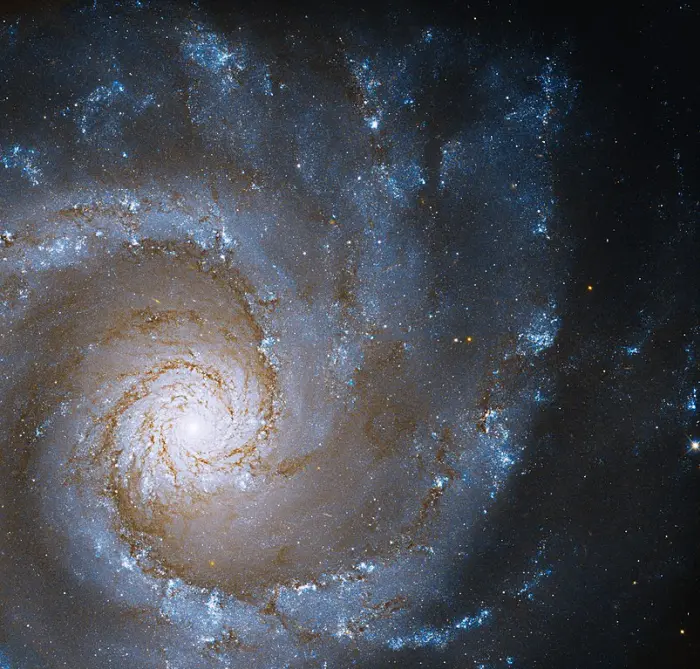
This image from NASA’s Hubble Space Telescope features the Grand Design Spiral, NGC 3631, located some 53 million light-years away in the direction of the constellation Ursa Major. The “arms” of grand design spirals appear to wind around and into the galaxy’s nucleus. Credit: NASA, ESA, A. Filippenko (University of California – Berkeley), and D. Sand (University of Arizona); Image Processing: G. Kober (NASA Goddard/Catholic University of America) (PD)
NGC 3656
NGC 3656 is a peculiar galaxy located 135 million light-years away. It appears just below the midpoint of the imaginary line connecting Phecda and Merak at the base of the Big Dipper’s bowl. It has an apparent magnitude of 12.3.
NGC 3656 was discovered by William Herschel on April 4, 1789. It is believed to be the product of a merger between two disk galaxies. It is around 70,000 light-years across. The galaxy has a prominent dark lane across its minor axis, similar to the one in the more famous Centaurus A.
NGC 3656 is the brightest member in the NGC 3656 Group of galaxies, which also includes NGC 3549 and UGC 6422. The galaxy hosted two supernovae, observed in 1963 (SN 1963K) and 1973 (SN 1973C).
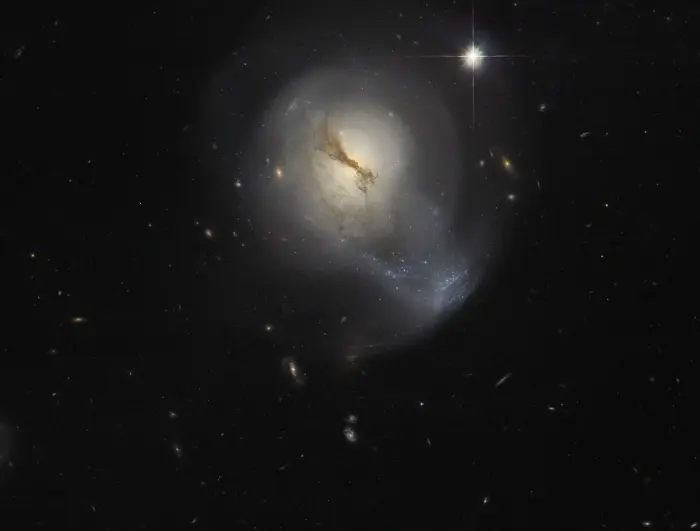
NGC 3656, credit: Wikimedia Commons/Solomon, Sloan Digital Sky Survey (CC BY 2.0)
NGC 3665
NGC 3665 is a lenticular galaxy in the region of the Great Bear’s hind legs. It has an apparent magnitude of 10.7 and an apparent size of 4.3 by 3.3 arcminutes. It is the most prominent member of the NGC 3665 Group of galaxies, which also includes NGC 3648, NGC 3652, and UGC 6433.
NGC 3665 was discovered by William Herschel on March 23, 1789. It has an active galactic nucleus with a supermassive black hole surrounded by an accretion disk. The galaxy features a prominent dust lane. It emits radio waves that are associated with a low luminosity active galactic nucleus (AGN) and two jet structures.
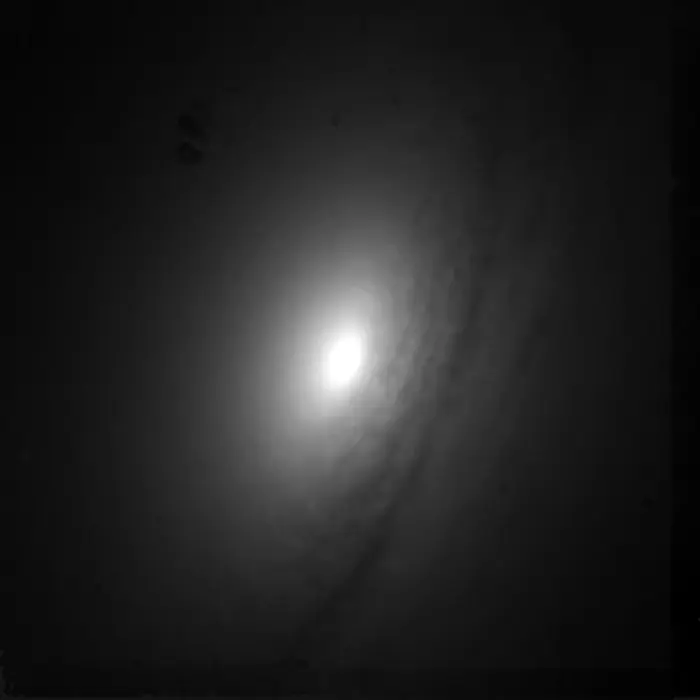
The central region of NGC 3665 by the Hubble Space Telescope. Image based on observations made with the NASA/ESA Hubble Space Telescope, and obtained from the Hubble Legacy Archive, which is a collaboration between the Space Telescope Science Institute (STScI/NASA), the Space Telescope European Coordinating Facility (ST-ECF/ESA) and the Canadian Astronomy Data Centre (CADC/NRC/CSA) (PD)
NGC 3675
NGC 3675 is a spiral galaxy located approximately 53 million light-years away. It has an apparent visual magnitude of 10 and an apparent size of 5.9 by 3.1 arcminutes. William Herschel discovered it on January 14, 1788.
The galaxy has a diameter of over 100,000 light years. It has a LINER nucleus with a supermassive black hole. It is a member of the Ursa Major Cluster. The galaxy has tightly wound spiral arms and two ring structures. The galaxy’s outer spiral arms are patchy.
NGC 3675 hosted a supernova, SN 1984R, discovered in December 1984.
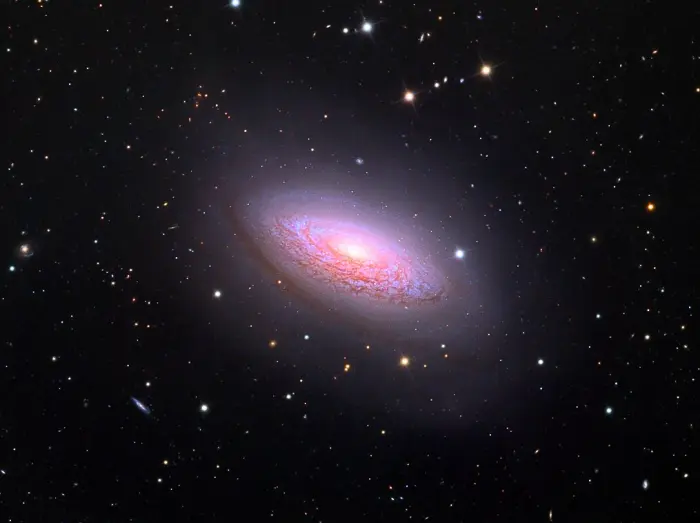
NGC 3675, image credit: Wikimedia Commons/ Jschulman555 (CC BY-SA 3.0)
Arp 214 (NGC 3718 and NGC 3729)
Arp 214 is a pair of interacting galaxies appearing below the base of the Big Dipper’s bowl. The two galaxies, NGC 3718 and NGC 3729, lie 47.84 and 65.7 million light-years away. William Herschel discovered them on April 12, 1789.
NGC 3718 is either a spiral or lenticular galaxy. It has an S-shape similar to the Condor Galaxy (NGC 6872) in the southern constellation Pavo. It shines at magnitude 10.61.
NGC 3729 is slightly fainter, with an apparent visual magnitude of 11. It is a barred spiral galaxy with a diameter of 60,000 light-years. The two galaxies are members of the M109 Group.
The colliding pair lies near the Hickson compact group HCG 56. Hickson 56 consists of five galaxies, four of which are interacting. Two of the galaxies are known radio sources. The compact galaxy group lies at about eight times the distance of Arp 214.
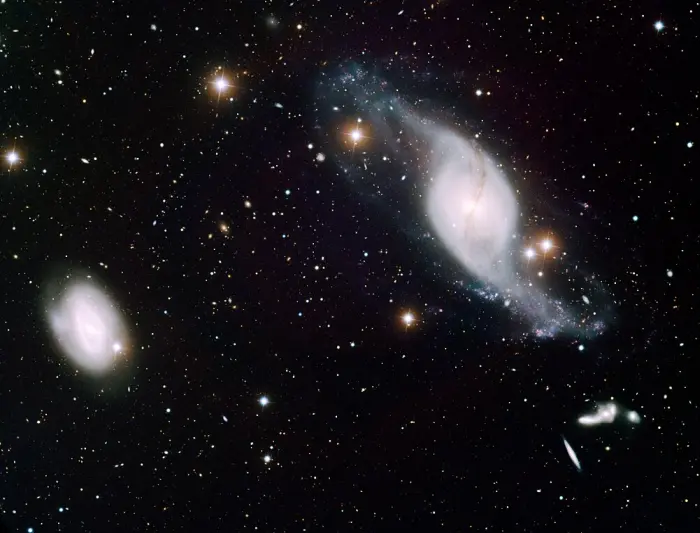
This image was obtained with the wide-field view of the Mosaic camera on the Mayall 4-meter telescope at Kitt Peak National Observatory. NGC 3718 is the twisted spiral galaxy in the upper-right corner of the image. Its distinctive shape is likely the result of gravitational interactions with the smaller spiral galaxy, NGC 3729, to the left. Below and to the right of NGC 3718 is the Hickson Compact Group 56, which consists of five interacting galaxies. Credit: T.A. Rector (University of Alaska Anchorage) and H. Schweiker (WIYN and NOIRLab/NSF/AURA) (CC BY 4.0)
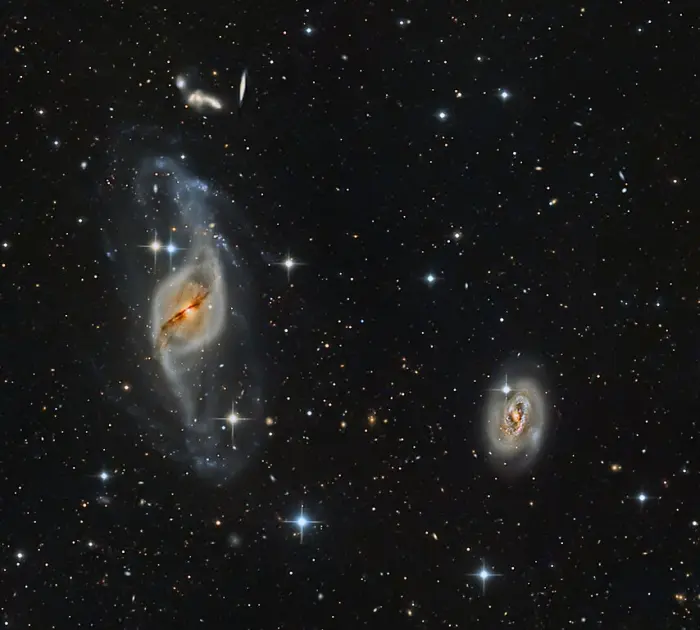
NGC 3729 and NGC 3718, credit: Wikimedia Commons/Safiy14 (CC BY 4.0)
NGC 3726
NGC 3726 is a barred spiral galaxy located approximately 46.6 million light-years away. It lies near the star Taiyangshou (Chi Ursae Majoris) and the galaxy NGC 3877. It has an apparent visual magnitude of 10.2. The galaxy was discovered by William Herschel on February 5, 1788.
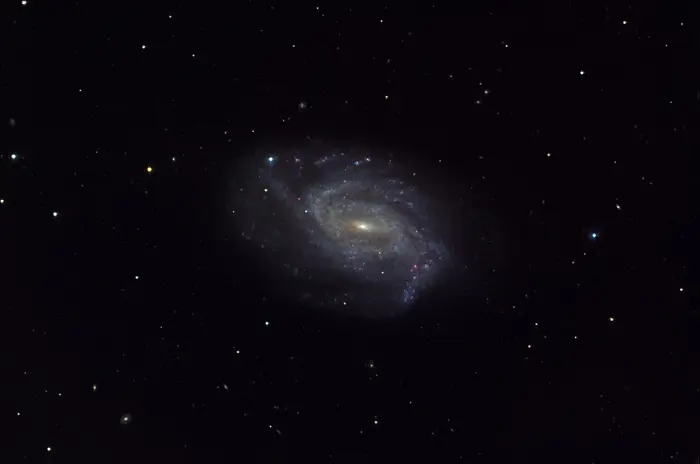
This barred spiral galaxy is located about 55 million lightyears away in the constellation Ursa Major. This image was taken as part of Advanced Observing Program (AOP) program at Kitt Peak Visitor Center during 2014. Credit: KPNO/NOIRLab/NSF/AURA/George Hickey/Adam Block (CC BY 4.0)
NGC 3877
NGC 3877 is a spiral galaxy located 50.5 million light-years away. It appears right next to the orange giant Taiyangshou (Chi UMa). It has an apparent magnitude of 12.1. The galaxy is about 80,900 light-years across. William Herschel discovered it on February 5, 1788.
NGC 3877 is a member of the M109 Group. The galaxy hosted a supernova, SN 1998S, observed on March 3, 1998. The supernova shone at magnitude 15.2 and was classified as a type IIn supernova.
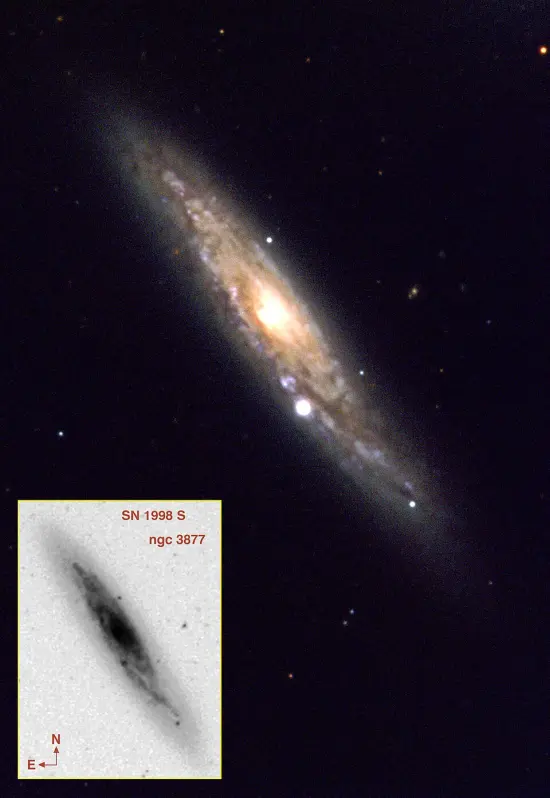
This 3.5-meter WIYN telescope image of supernova 1998S in the spiral galaxy NGC3877 is shown with a B&W insert of the galaxy taken from the second Palomar Observatory Sky Survey (POSS II), which shows clearly how a supernova can rival in brightness its entire parent galaxy. Credit: WIYN/NOIRLab/NSF (CC BY 4.0)
NGC 3898
NGC 3898 is a spiral galaxy that lies 72 million light years away in the Big Dipper’s bowl. It appears 1.5 degrees northwest of the lenticular galaxy NGC 3998. NGC 3898 has an apparent magnitude of 10.7. It was discovered by William Herschel on April 14, 1789.
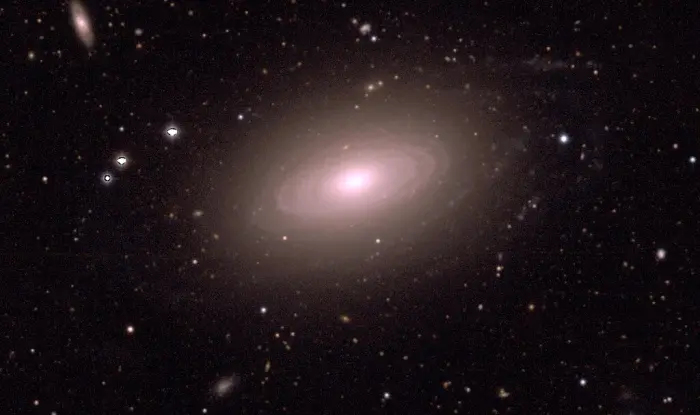
NGC 3898, image credit: Legacy Surveys / D. Lang (Perimeter Institute), NERSC (CC BY 4.0)
NGC 3938
NGC 3938 is an unbarred spiral galaxy located 43 million light-years away. It has an apparent magnitude of 10.9 and an angular size of 5.4 by 4.9 arcminutes. It was discovered by William Herschel on February 6, 1788. The galaxy hosted five supernovae in the period from 1961 to 2022.
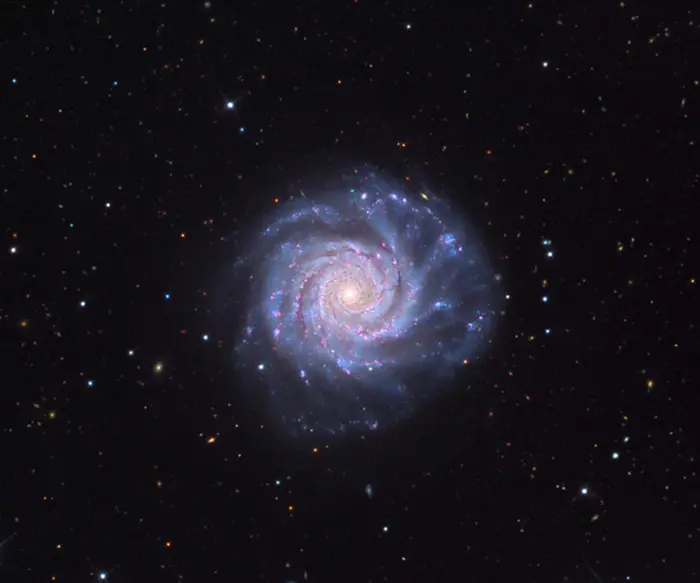
NGC 3938 with SN 2005ay taken at the Mount Lemmon SkyCenter of the University of Arizona. It was taken on a 32-inch Schulman Telescope using a SBIG STX CCD Camera. Credit: Adam Block/Mount Lemmon SkyCenter/University of Arizona (CC BY-SA 3.0)
NGC 3945
NGC 3945 is a barred lenticular galaxy located approximately 63 million light-years away. It was discovered by William Herschel on March 19, 1790.
The galaxy contains a LINER nucleus, a pseudobulge and two concentric arms. It appears about two thirds of the way from Alioth to Dubhe.
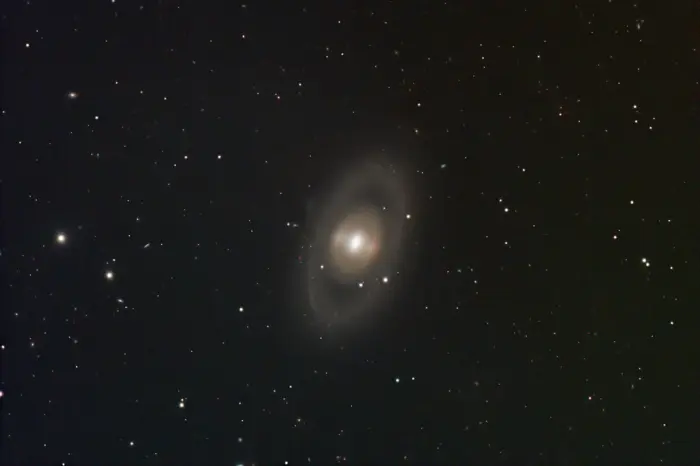
NGC 3945, image credit: Juan Lacruz (CC BY 4.0)
NGC 3949
NGC 3949 is a spiral galaxy located approximately 48.6 million light-years away. It appears east of Taiyangshou in the sky. William Herschel discovered it on February 5, 1788.
NGC 3949 has an apparent visual magnitude of 11.5. It is a member of the M109 Group. It hosted a type II supernova, SN 2000db, observed in August 2000.
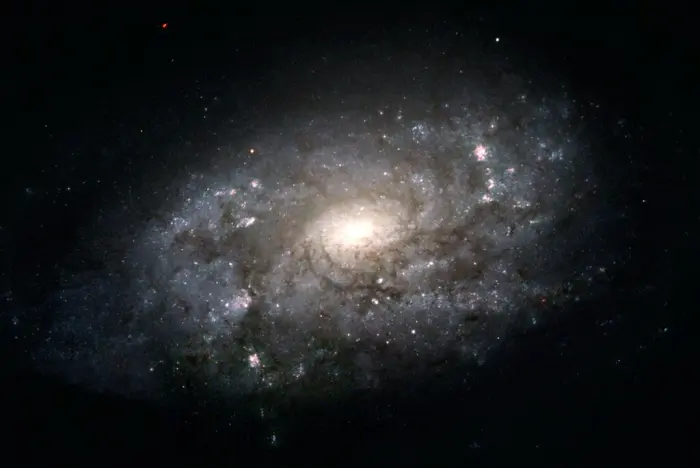
NGC 3949, credit: NASA, ESA and The Hubble Heritage Team (STScI/AURA) (PD)
NGC 3953
NGC 3953 is a barred spiral galaxy in the M109 Group. It has a diameter of 131,200 light years. The galaxy shines at magnitude 10.8 and has an apparent of 6.9 by 3.5 arcminutes. It was discovered by Pierre Méchain on March 12, 1781.
NGC 3953 appears just south of Phecda. It hosted two observed supernovae: the type Ia supernova SN 2001dp in 2001 and SN 2006bp in 2006.
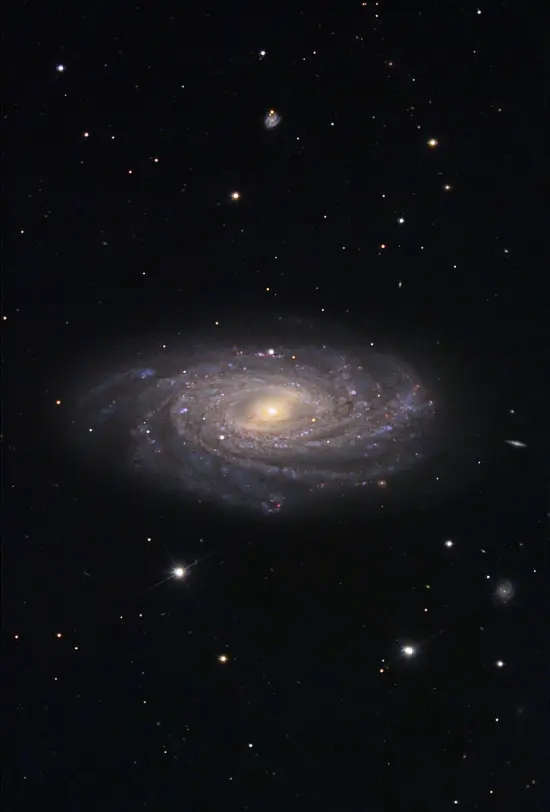
Like its more well-known neighbor M109, this galaxy is a surprising copy-cat barred spiral galaxy. Slightly more inclined and with tightly wound arms, NGC 3953 is a seemingly more spirited galaxy 46 million light years away. Credit: KPNO/NOIRLab/NSF/AURA/Tom and Gail Haynes/Adam Block (CC BY 4.0)
NGC 3982
NGC 3982 is an intermediate spiral galaxy located approximately 67.8 million light-years away. It has an apparent magnitude of 12 and appears north of Phecda. It is a member of the M109 Group.
NGC 3982 has an active galactic nucleus and is classified as a Seyfert 2 galaxy. It has a diameter of about 30,000 light-years. It hosted a supernova, SN 1998aq, observed in 1998.
The galaxy was discovered by William Herschel on April 14, 1789. It is best observed in larger instruments.
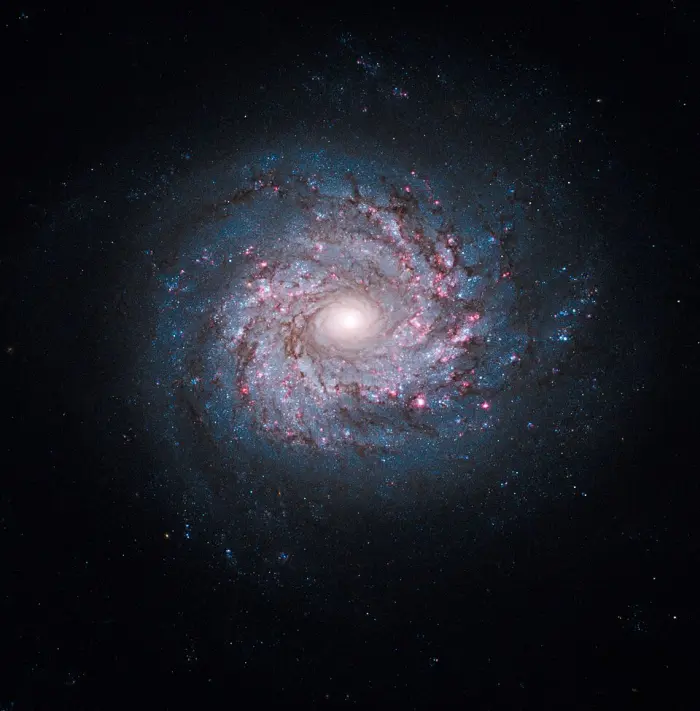
This face-on spiral galaxy, called NGC 3982, is striking for its rich tapestry of star birth, along with its winding arms. The arms are lined with pink star-forming regions of glowing hydrogen, newborn blue star clusters, and obscuring dust lanes that provide the raw material for future generations of stars. The bright nucleus is home to an older population of stars, which grow ever more densely packed toward the center. Credit: NASA, ESA, and the Hubble Heritage Team (STScI/AURA); Acknowledgment: A. Riess (STScI) (CC BY 4.0)
NGC 4036
NGC 4036 is a lenticular galaxy located 62.1 million light-years away. It appears roughly halfway and just north of the imaginary line connecting Dubhe and Megrez in the Big Dipper’s bowl. With an apparent magnitude of 10.7, it can be seen in small and medium telescopes. It was discovered by William Herschel on March 19, 1790.
The galaxy has a LINER nucleus and a tilted disk of stars orbiting the nucleus. It is a member of the LGG 266 Group of galaxies, along with NGC 4041, IC 758, UGC 7009, and UGC 7019.
NGC 4036 hosted a type Ia supernova, SN 2007gi, observed in July 2007. The supernova had an apparent magnitude of 16.3.
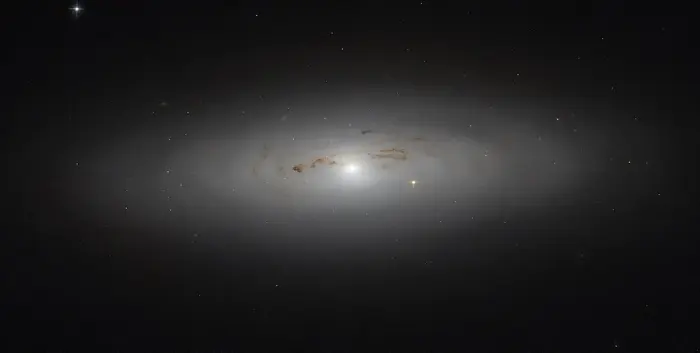
NGC 4036, credit: ESA/Hubble & NASA, Judy Schmidt (CC BY 4.0)
NGC 4041
NGC 4041 is a spiral galaxy located approximately 70.4 million light-years away. It forms a pair with NGC 4036. The two galaxies are separated by about 470,000 light-years.
William Herschel discovered NGC 4041 on March 19, 1790. The galaxy hosted a type IIp supernova, SN 1994W, observed 19 arcseconds northwest of the galaxy’s nucleus in July 1994.
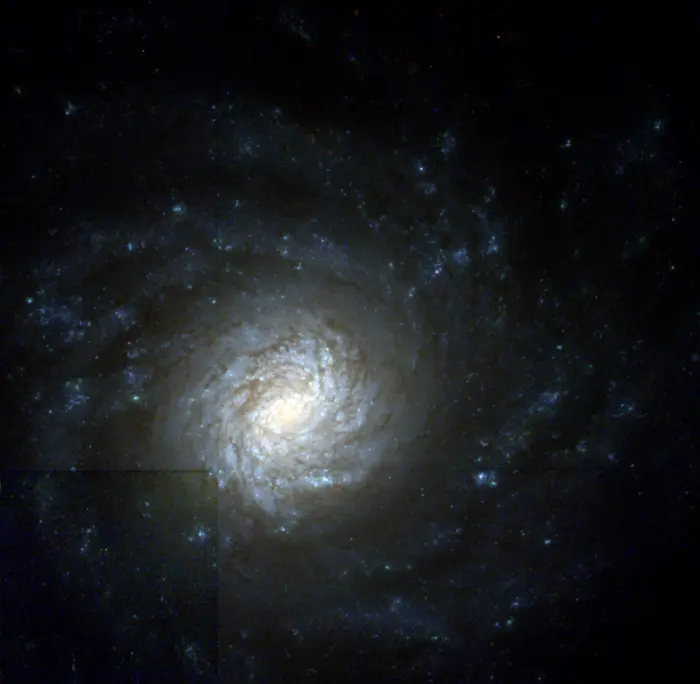
NGC 4041, based on observations made with the NASA/ESA Hubble Space Telescope, and obtained from the Hubble Legacy Archive, which is a collaboration between the Space Telescope Science Institute (STScI/NASA), the Space Telescope European Coordinating Facility (ST-ECF/ESA) and the Canadian Astronomy Data Centre (CADC/NRC/CSA) (CC BY-SA 3.0)
NGC 4051
NGC 4051 is an intermediate spiral galaxy located 54.14 million light-years from the Sun. It has an apparent magnitude of 12.92. It was discovered by John Herschel on February 6, 1788.
NGC 4051 is classified as a Seyfert galaxy. It has an active nucleus and emits bright X-rays. The galaxy’s central supermassive black hole has a mass of 1.73 million Suns.
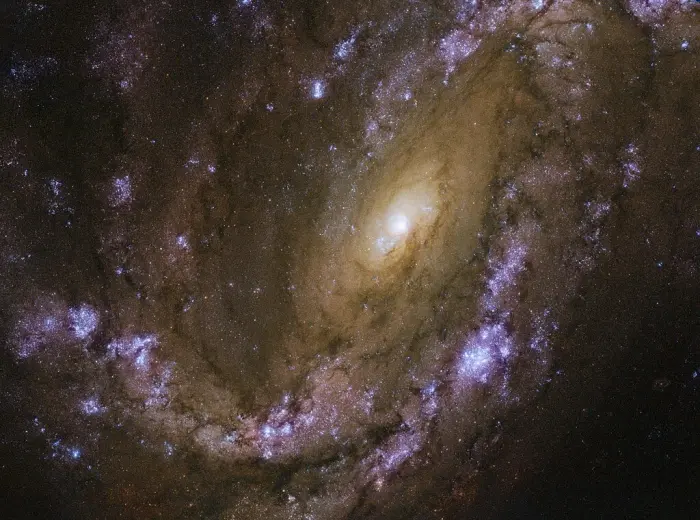
NGC 4051, credit: ESA/Hubble & NASA, D. Crenshaw and O. Fox (CC BY 4.0)
NGC 4088
NGC 4088 is a grand design spiral galaxy located 51.5 million light-years away. It has an apparent magnitude of 11.2. It forms a pair with NGC 4085. The two galaxies are separated by 11 arcminutes in the sky. They are members of the M109 Group.
NGC 4088 was discovered by William Herschel on March 9, 1788. It hosted three type II supernovae in recent decades: SN 1991G in February 1991, SN 2009dd in April 2009, and SN 2022jzc in May 2022.
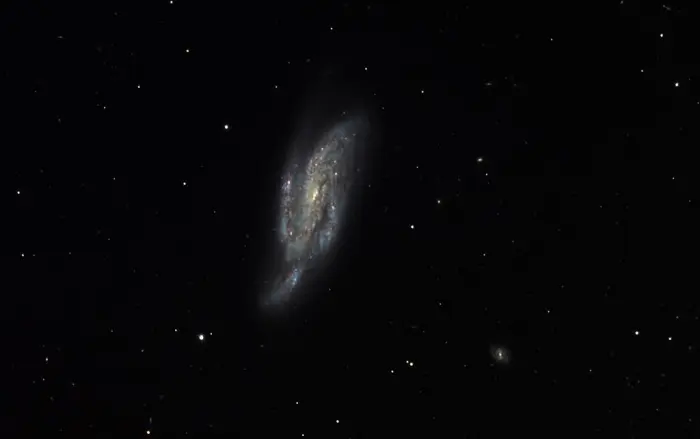
NGC 4088, credit: KPNO/NOIRLab/NSF/AURA/Bonnie Fisher and Mike Shade/Adam Block (CC BY 4.0)
NGC 4102
NGC 4102 is a barred spiral galaxy located 59.6 million light-years away. It has an apparent magnitude of 11.2. It was discovered by William Herschel on April 12, 1789. The galaxy appears southeast of Phecda and Messier 109. It is a member of the Ursa Major Cluster.
NGC 4102 has an active galactic nucleus (a LINER) with a supermassive black hole. It contains a region of intense star formation about 1,000 light years across at its core.
The galaxy hosted a supernova, SN 1975E, that shone at magnitude 16.7 in May 1975.
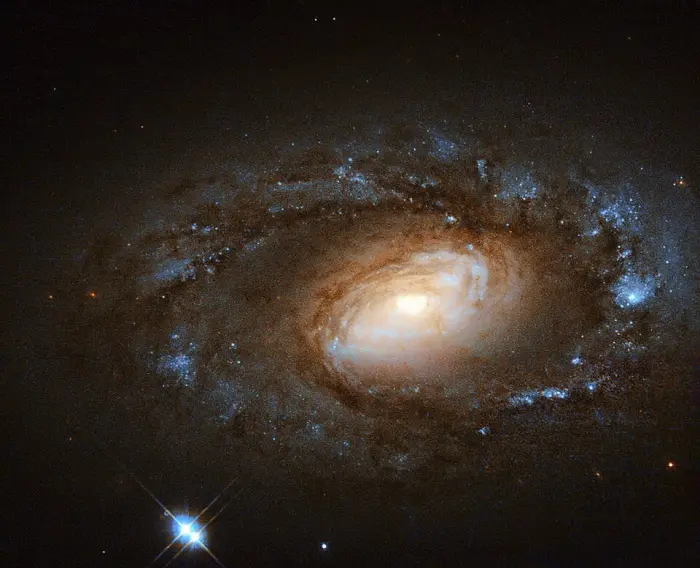
NGC 4102, credit: ESA/Hubble, NASA and S. Smartt (Queen’s University Belfast); Acknowledgement: Renaud Houdinet (CC BY 4.0)
NGC 5322
NGC 5322 is an elliptical galaxy located 79 million light-years away. It appears in the region between Mizar in the Big Dipper and Thuban in Draco. It has an apparent magnitude of 10.1.
The galaxy has a diameter of about 140,000 light-years. It contains an inner stellar disk that is thought to be the remnant of a smaller satellite galaxy that was devoured by its larger neighbour. It also has an edge-on nuclear dust disk that is aligned along the galaxy’s major axis.
NGC 5322 has a low-luminosity active galactic nucleus (AGN). The galaxy’s central supermassive black hole has an estimated mass between 129 and 813 million solar masses.
NGC 5322 was discovered by William Herschel on March 19, 1790. The galaxy is the most prominent member of the NGC 5322 Group, which also includes the galaxies NGC 5372, NGC 5379, and NGC 5389.
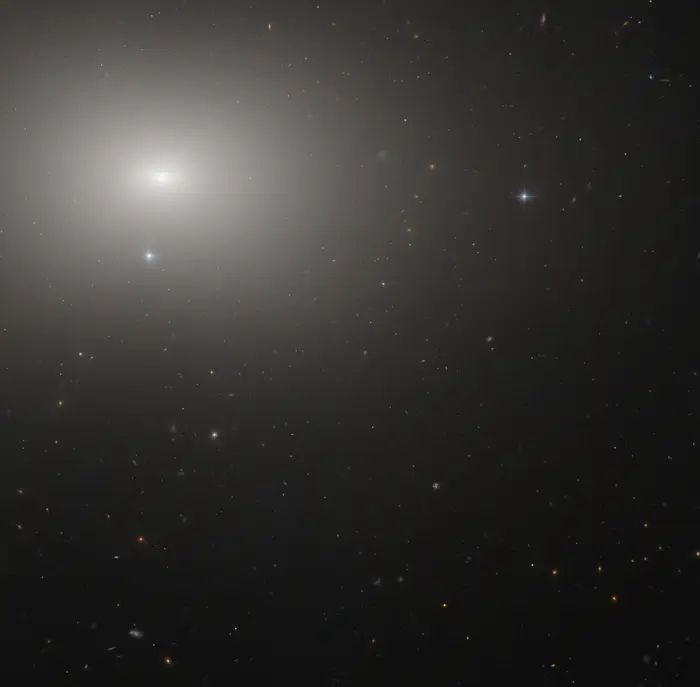
NGC 5322, image credit: Judy Schmidt (CC BY 2.0)
Arp 194 (UGC 6945)
Arp 194 is a pair or trio of colliding galaxies located approximately 570 million light years away. The two northern galaxies are gravitationally interacting with each other. They are in an advanced phase of merger.
The interaction has pulled out gas from both galaxies, which appears draped over the southern galaxy in the visual grouping. The southern galaxy was long believed to be interacting with the other two galaxies, but observations with Hubble have revealed that the stream of material appears superimposed on the galaxy. This indicates that the southern galaxy lies in the background.
Arp 194 appears in the region between Alula Borealis in Ursa Major and Cor Caroli in Canes Venatici.
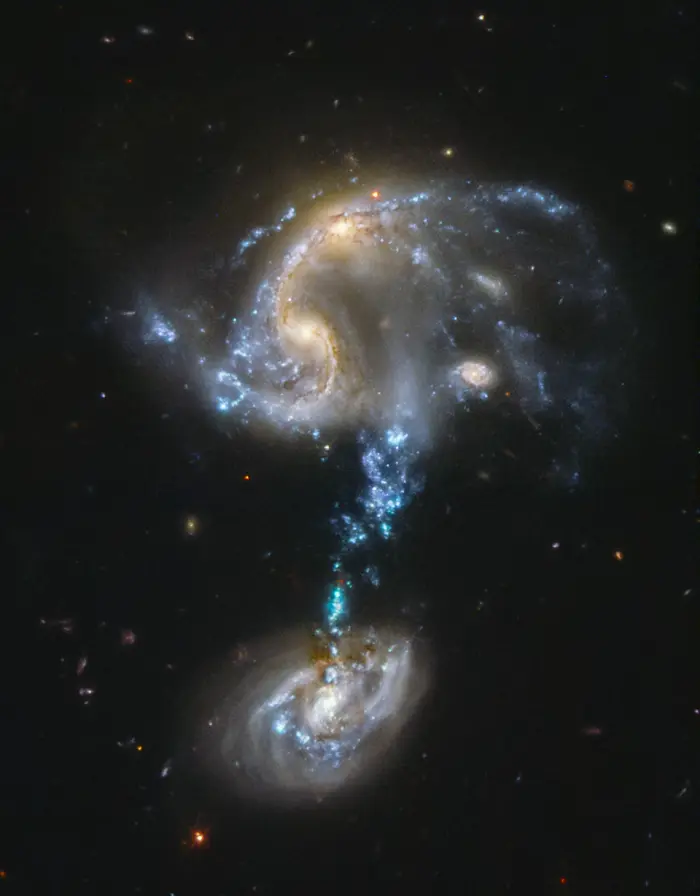
Arp 194, image: Judy Schmidt (CC BY 2.0)
Palomar 4
Palomar 4 is a globular cluster located 326,000 light-years away. It belongs to the Milky Way, but it is more distant even than the Sagittarius Dwarf Spheroidal Galaxy (SagDEG). The cluster was once believed to be a dwarf galaxy and called the Ursa Major Dwarf. It appears near Alula Australis in the sky.
Palomar 4 was discovered by the American astronomer Edwin Hubble in 1949. It is a member of the Palomar Globular Clusters group, which includes some of our galaxy’s faintest globular clusters, discovered in the first Palomar Observatory Sky Survey (POSS) in the 1950s.
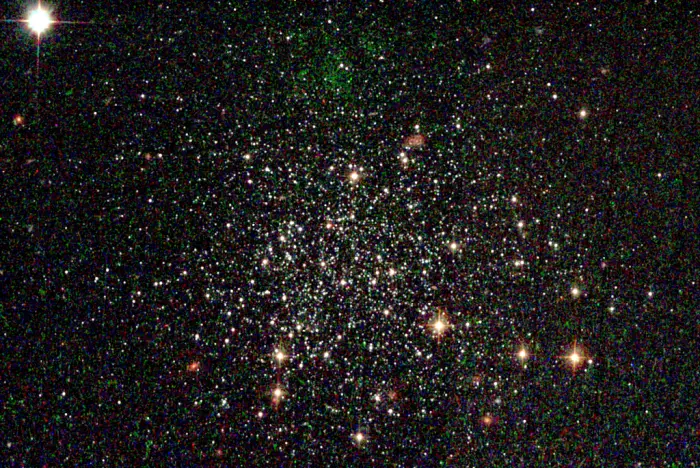
Palomar 4, credit: on observations made with the NASA/ESA Hubble Space Telescope, and obtained from the Hubble Legacy Archive, which is a collaboration between the Space Telescope Science Institute (STScI/NASA), the Space Telescope European Coordinating Facility (ST-ECF/ESA) and the Canadian Astronomy Data Centre (CADC/NRC/CSA) (CC BY-SA 3.0)
Cheshire Cat galaxies (SDSS J1038+4849)
The Cheshire Cat galaxy group is a grouping of galaxies that appear as a smiling face. The group consists of two clusters of galaxies centred on the Cat’s eyes, marked by the elliptical galaxies SDSS J103843.58+484917.7 and SDSS J103842.68+484920.2, and a distant background galaxy that appears as the Cat’s smile. The clusters lie 4.5 billion light-years away. They are speeding towards each other at at 1,350 km/s.
The smile and outline of the Cat’s face are formed by Einstein rings. The rings are the effect of gravitational lensing. The massive clusters in the foreground bend and magnify the light of distant galaxies that lie behind the clusters. The light is stretched into Einstein rings that appear in the same field of view as the Cat’s eyes.
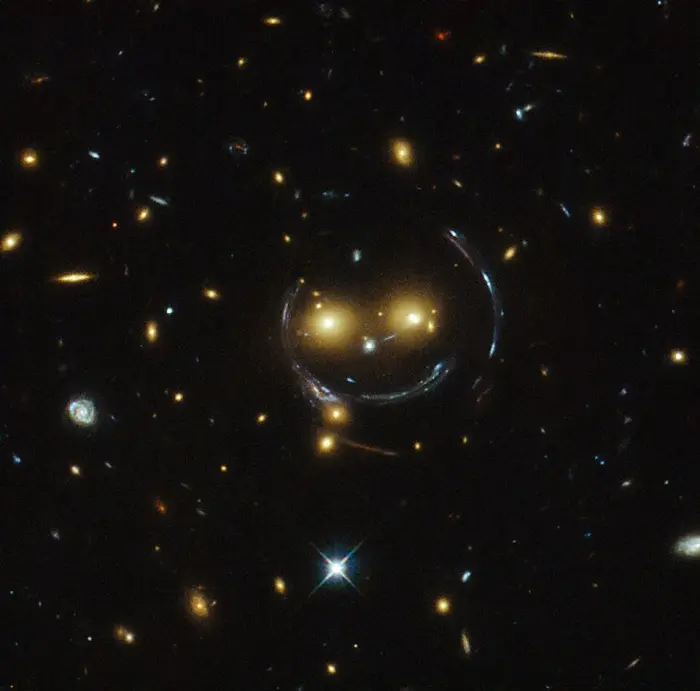
In the centre of this image, taken with the NASA/ESA Hubble Space Telescope, is the galaxy cluster SDSS J1038+4849 — and it seems to be smiling. You can make out its two orange eyes and white button nose. In the case of this “happy face”, the two eyes are very bright galaxies and the misleading smile lines are actually arcs caused by an effect known as strong gravitational lensing. Image credit: NASA/ESA (CC BY 3.0)
SDSS J103512.07+461412.2
SDSS J103512.07+461412.2 is an irregular galaxy located 23 million light years from Earth. It was imaged by the Hubble Space Telescope in 2023.
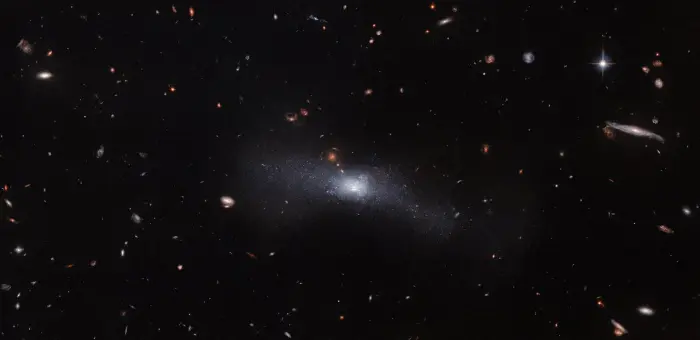
This Hubble Picture of the Week includes the pithily-named galaxy SDSS J103512.07+461412.2, visible in the centre of this image as a dispersed sweep of dust and stars with a denser, brighter core. SDSS J103512.07+461412.2 is located 23 million light-years from Earth in the constellation Ursa Major. The seemingly rambling name is because this galaxy was observed as part of the Sloan Digital Sky Survey (SDSS), a massive survey that began in 2000 with the aim of observing and cataloguing vast numbers of astronomical objects. Credit: ESA/Hubble & NASA, R. Tully (CC BY 4.0)
Skyrocket Galaxy (Kiso 5639)
Kiso 5639 is an irregular dwarf galaxy located approximately 85 million light-years away. The galaxy’s elongated shape with a bright head and a tail structure has earned it the nickname the Skyrocket Galaxy or Rocket Galaxy. It was described as a July 4th skyrocket by NASA. The galaxy appears in the region of the Great Bear’s rear feet.
Kiso 5639 has a maximum diameter of 2,700 light years. It is believed to have experienced a starburst around 1 million years ago. The brighter region in the “head” of the skyrocket is undergoing intense star formation.
The galaxy was discovered during observations with the Hubble Space Telescope in 2004.
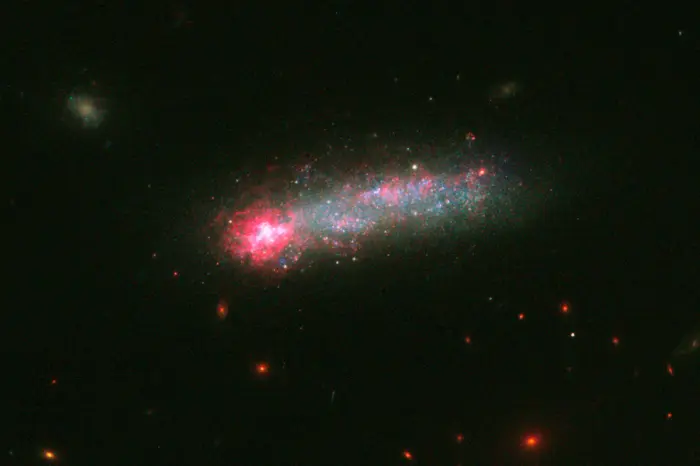
In this NASA Hubble Space Telescope image, a firestorm of star birth is lighting up one end of the diminutive galaxy Kiso 5639. The dwarf galaxy is shaped like a flattened pancake, but because it is tilted edge-on, it resembles a skyrocket, with a brilliant blazing head and a long, star-studded tail. Credit: NASA, ESA, and D. Elmegreen (Vassar College), B. Elmegreen (IBM’s Thomas J. Watson Research Center), J. Sánchez Almeida, C. Munoz-Tunon, and M. Filho (Instituto de Astrofísica de Canarias), J. Mendez-Abreu (University of St. Andrews), J. Gallagher (University of Wisconsin-Madison), M. Rafelski (NASA Goddard Space Flight Center), and D. Ceverino (Center for Astronomy at Heidelberg University) (PD)
Arp 238 (UGC 8335)
UGC 8335 is a pair of interacting spiral galaxies located 418 million light-years from Earth. The pair shines at magnitude 14.4. Both galaxies are heavily distorted and have prominent tidal tails pulled out by gravitational forces as a result of the close encounter. They are connected by a bridge of gas and stars. The galaxies are listed as Arp 238 in Halton Arp’s Atlas of Peculiar Galaxies.
UGC 8335 hosted a type II supernova, SN 2012by, observed in late April 2012. The supernova peaked at magnitude 17.3.
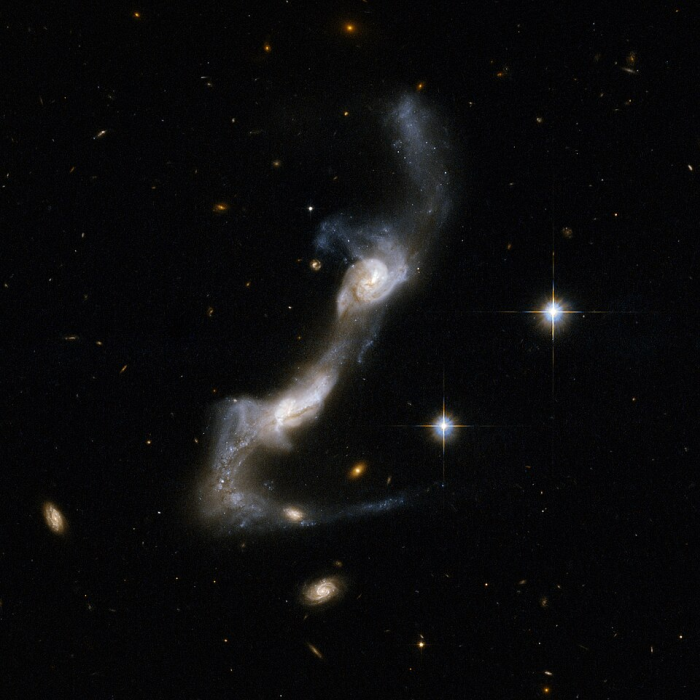
Arp 238 is a strongly interacting pair of spiral galaxies resembling two ice skaters. The interaction has united the galaxies via a bridge of material and has yanked two strongly curved tails of gas and stars from the outer parts of their bodies . Both galaxies show dust lanes in their centers. Credit: NASA, ESA, the Hubble Heritage (STScI/AURA)-ESA/Hubble Collaboration, and A. Evans (University of Virginia, Charlottesville/NRAO/Stony Brook University) (PD)
Arp 239 (NGC 5278 and NGC 5279)
NGC 5278 and NGC 5279 are a pair of interacting spiral galaxies appearing in the region near the Mizar/Alcor system. The brighter NGC 5278 has an apparent magnitude of 13.6. The galaxies are catalogued as Arp 239 in the Atlas of Peculiar Galaxies. They were discovered by William Herschel on April 14, 1789.
The nucleus of NGC 5278 is undergoing a starburst. It is an active galactic nucleus (Seyfert 2) and possibly a LINER. The galaxy appears bright in the ultraviolet band. It hosted two supernovae in the recent decades: the type Ic supernova SN 2001ai in 2001 and the type II supernova SN 2019cec in 2019.
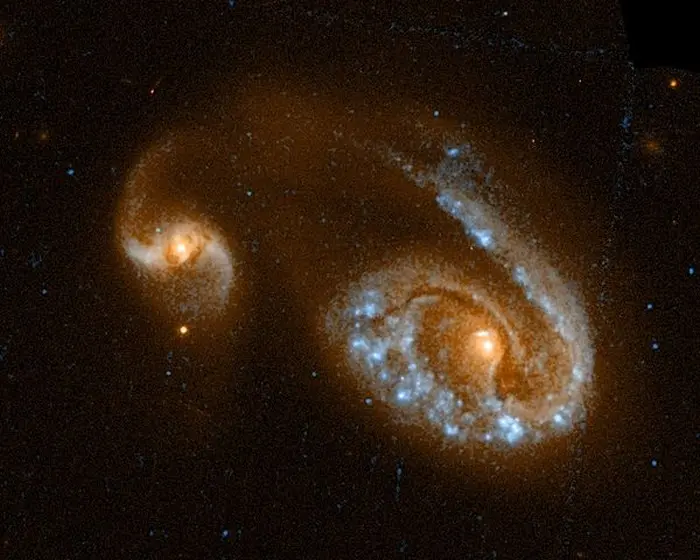
The galaxies NGC 5279 (left) anf NGC 5278 (right), based on observations made with the NASA/ESA Hubble Space Telescope, and obtained from the Hubble Legacy Archive, which is a collaboration between the Space Telescope Science Institute (STScI/NASA), the Space Telescope European Coordinating Facility (ST-ECF/ESA) and the Canadian Astronomy Data Centre (CADC/NRC/CSA) (CC BY-SA 3.0)
Arp 299 (NGC 3690 and IC 694)
Arp 299 is a pair of closely interacting galaxies located approximately 134 million light-years away. The galaxies appear a little less than halfway from Dubhe to Phecda in the Big Dipper’s bowl. They were discovered by William Herschel on March 18, 1790. The colliding galaxies have many young starburst regions, produced by their interaction. They have an apparent magnitude of 11.
NGC 3690 has hosted 12 observed supernovae, more than any other known galaxy, all observed from 1992 to 2024. IC 694 hosted three supernovae from 2005 to 2010.
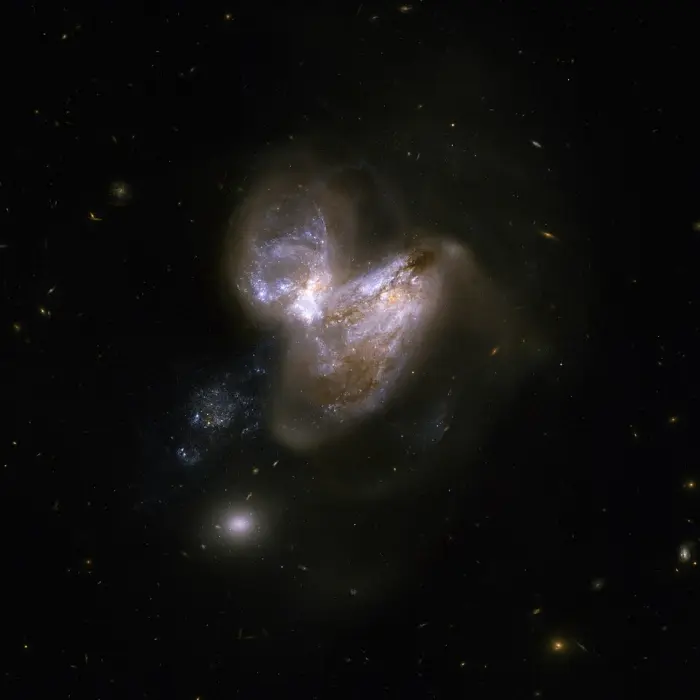
This system consists of a pair of galaxies, dubbed IC 694 and NGC 3690, which made a close pass some 700 million years ago. As a result of this interaction, the system underwent a fierce burst of star formation. In the last fifteen years or so six supernovae have popped off in the outer reaches of the galaxy, making this system a distinguished supernova factory. Credit: NASA, ESA, the Hubble Heritage (STScI/AURA)-ESA/Hubble Collaboration, and A. Evans (University of Virginia, Charlottesville/NRAO/Stony Brook University) (PD)
Twin Quasar
The Twin Quasar (Twin QSO, SBS 0957+561, QSO 0957+561 A/B) was the first gravitationally lensed double quasar ever identified. Discovered in 1979, the quasar appears as two images due to the effect of gravitational lensing by a massive foreground object. It lies approximately 8.7 billion light-years away and has an apparent visual magnitude of 16.7. The giant elliptical galaxy that acts as a lens lies much closer to us, at a distance of 3.7 billion light years. It is catalogued as YGKOW G1 or Q0957+561 G1.
The Twin Quasar appears only 10 arcminutes north of the barred spiral galaxy NGC 3079.
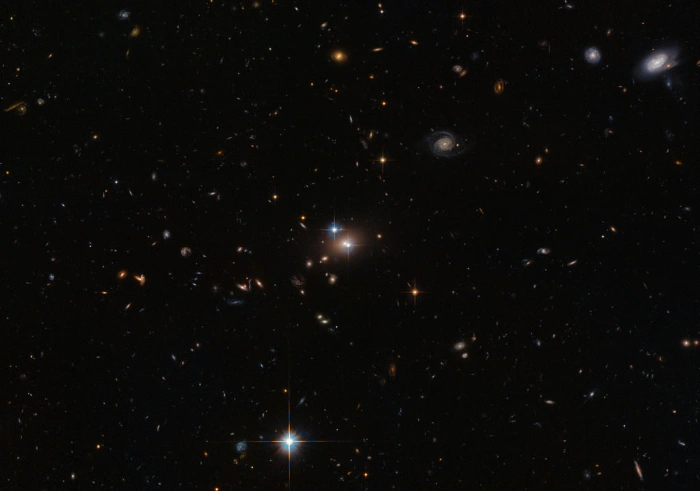
These cosmic doppelgangers make up a double quasar known as QSO 0957+561, also known as the “Twin Quasar”, which lies just under 9 billion light-years from Earth. Quasars are the intensely powerful centres of distant galaxies. So, why are we seeing this quasar twice? Some 4 billion light-years from Earth — and directly in our line of sight — is the huge galaxy YGKOW G1. This galaxy was the first ever observed gravitational lens, an object with a mass so great that it can bend the light from objects lying behind it. This phenomenon not only allows us to see objects that would otherwise be too remote, in cases like this it also allows us to see them twice over. Credit: ESA/Hubble & NASA (CC BY 4.0)
Medusa Merger (NGC 4194)
The Medusa merger is a late-stage galaxy merger located approximately 128 million light years away. It appears about a third of the way from Phecda to Alioth in the Big Dipper. It has an apparent magnitude of 13.30.
The galactic collision has triggered a burst of star forming activity throughout the galaxy. The gas-rich centre of the galaxy, the Eye of the Medusa, contains a region with an exceptionally high rate of star formation about 500 light years across. New stars are also forming in the galaxy’s tidal tail. Observations with the Chandra X-ray Observatory in 2009 revealed X-ray emission from a black hole in the tail.
NGC 4194 was discovered by William Herschel on April 2, 1791. It is catalogued as Arp 160 in the Atlas of Peculiar Galaxies.
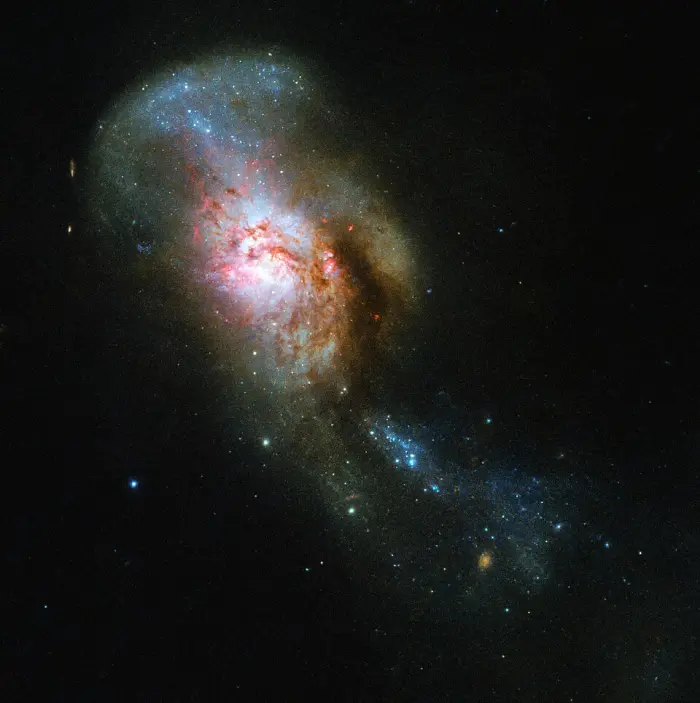
The galaxy pictured in this Hubble Picture of the Week has an especially evocative name: the Medusa merger.
Often referred to by its somewhat drier New General Catalogue designation of NGC 4194, this was not always one entity, but two. An early galaxy consumed a smaller gas-rich system, throwing out streams of stars and dust out into space. These streams, seen rising from the top of the merger galaxy, resembles the writhing snakes that Medusa, a monster in ancient Greek mythology, famously had on her head in place of hair, lending the object its intriguing name. The legend of Medusa also held that anyone who saw her face would transform into stone. In this case, you can feast your eyes without fear on the centre of the merging galaxies, a region known as Medusa’s eye. All the cool gas pooling here has triggered a burst of star formation, causing it to stand out brightly against the dark cosmic backdrop. Credit: ESA/Hubble & NASA, A. Adamo (CC BY 4.0)
I Zwicky 18
I Zwicky 18 is a dwarf irregular galaxy only 3,000 light-years across, located 59 million light years away. It was discovered by the Swiss astronomer Fritz Zwicky in the 1930s.
I Zwicky 18 is catalogued as a blue compact galaxy and a starburst galaxy. Nicknamed the Dorian Gray galaxy for its youthful appearance and primordial makeup, the galaxy puzzles astronomers because it is forming many new stars now and did not produce many in the past. The galaxy is composed almost exclusively of hydrogen and helium, with heavier elements almost completely missing.
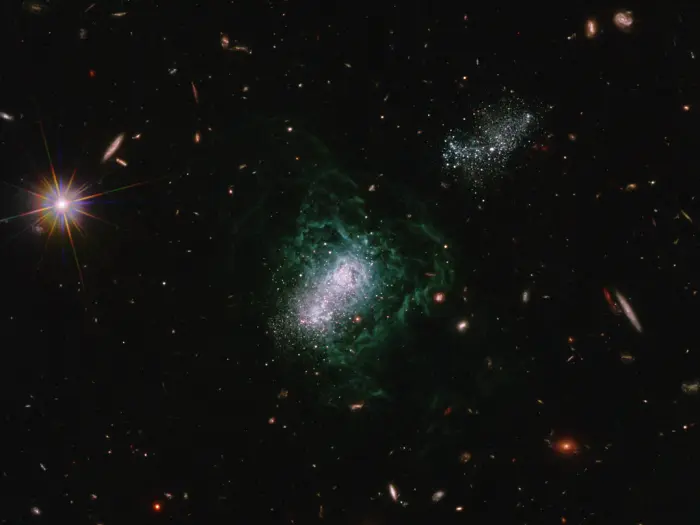
I Zwicky 18, credit: Judy Schmidt (CC BY 2.0)
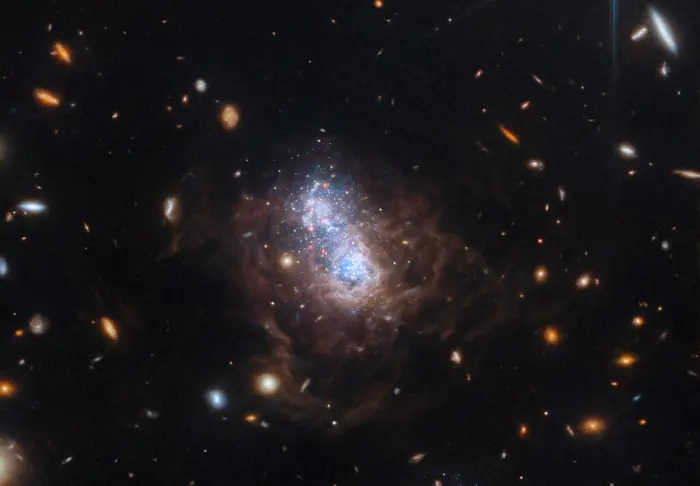
The NASA/ESA/CSA James Webb Space Telescope has captured a spectacular view of the galaxy I Zwicky 18 (I Zw 18) in this new image. The galaxy was first identified by Swiss astronomer Fritz Zwicky in the 1930’s and resides roughly 59 million light-years from Earth. This galaxy has gone through several sudden bursts of star formation. This galaxy is typical of the kinds of galaxies that inhabited the early Universe and it is classified as a dwarf irregular galaxy (much smaller than our Milky Way). Two major starburst regions are embedded in the heart of the galaxy. The wispy brown filaments surrounding the central starburst region are bubbles of gas that have been heated by stellar winds and intense ultraviolet radiation unleashed by hot, young stars. Credit: ESA/Webb, NASA, CSA, A. Hirschauer, M. Meixner et al. (CC BY 4.0)
Guitar Galaxies (NGC 3561)
NGC 3561 is a pair of colliding galaxies located 412.3 million light years away. Popularly known as the Guitar, the interacting duo appears south of Alula Australis and Alula Borealis, near the border with the constellation Leo. With an apparent magnitude of 14.5 and an apparent size of 1.36 by 0.69 arcminutes, it is a challenging target for amateur telescopes. The pair is catalogued as Arp 105 in the Atlas of Peculiar Galaxies. In April 1953, Halton Arp discovered a supernova, SN 1953A, in NGC 3561A. The supernova had an apparent magnitude of 16.
NGC 3561 was discovered by the English astronomer John Herschel on March 30, 1827. NGC 3561A is a spiral galaxy catalogued as a radio galaxy and NGC 3561B is an elliptical galaxy with a LINER-type active galactic nucleus.
The pair also contains Ambartsumian’s Knot, a tidal dwarf galaxy that appears at the end of the bridge of material that extends from NGC 3561B. The tidal tail of NGC 3651A stretches for around 325,000 light years from the host galaxy.
The Guitar galaxies are members of the Abell 1185 cluster, a galaxy cluster that spans about 1 million light years and lies within the Leo Supercluster.
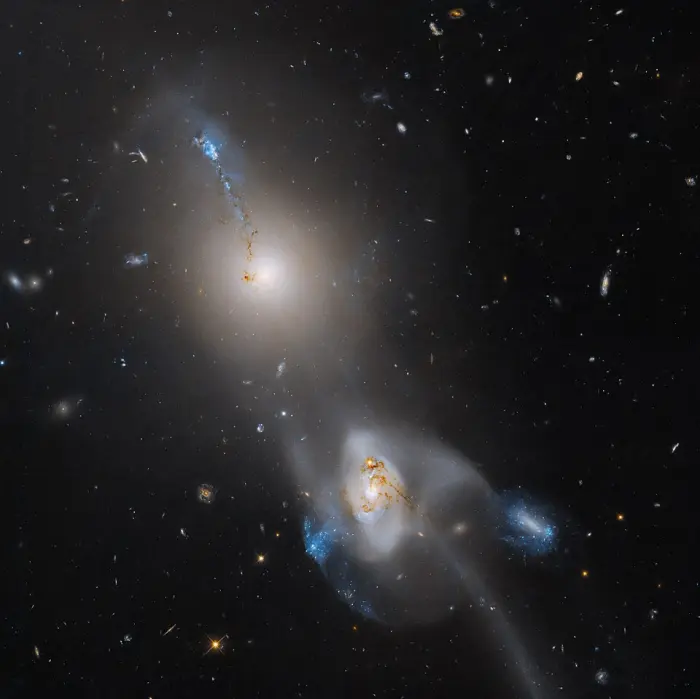
Arp 105 is a dazzling ongoing merger between an elliptical galaxy and a spiral galaxy drawn together by gravity, characterized by a long, drawn out tidal tail of stars and gas more than 362,000 light-years long. The immense tail, which extends beyond this image from NASA’s Hubble Space Telescope, was pulled from the two galaxies by their gravitational interactions and is embedded with star clusters and dwarf galaxies. The distinctively shaped arrangement of galaxies and tail gives the grouping its nickname: The Guitar. Credit: NASA, ESA and M. West (Lowell Observatory); Processing: Gladys Kober (NASA/Catholic University of America) (PD)
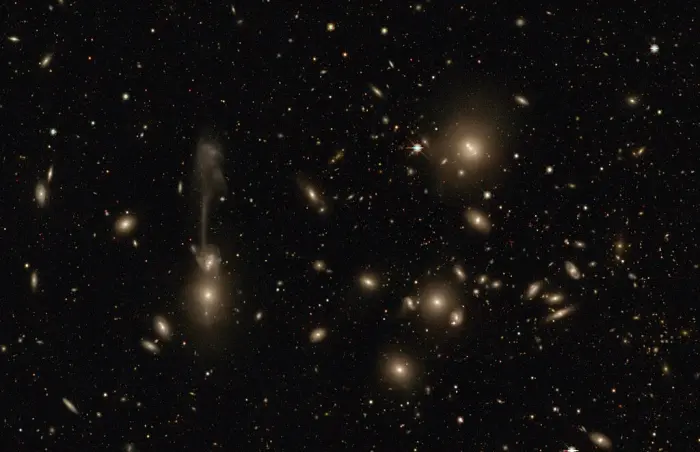
Abell 1185, containing NGC 3550, NGC 3552, NGC 3553, NGC 3554 and NGC 3561. Image: Legacy Surveys / D. Lang (Perimeter Institute), NERSC (CC BY 4.0)
SpARCS1049
SpARCS1049 is a cluster of galaxies located approximately 9.8 billion light-years away. It was discovered by the Hubble and Spitzer space telescopes in 2015. The cluster contains at least 27 galaxies.
Unlike most galaxy clusters, SpARCS1049 has a giant galaxy in its centre that is experiencing a starburst after colliding with a smaller companion. It forms around 860 new stars per year. In comparison, the Milky Way produces stars at a rate of 1-2 stars per year.
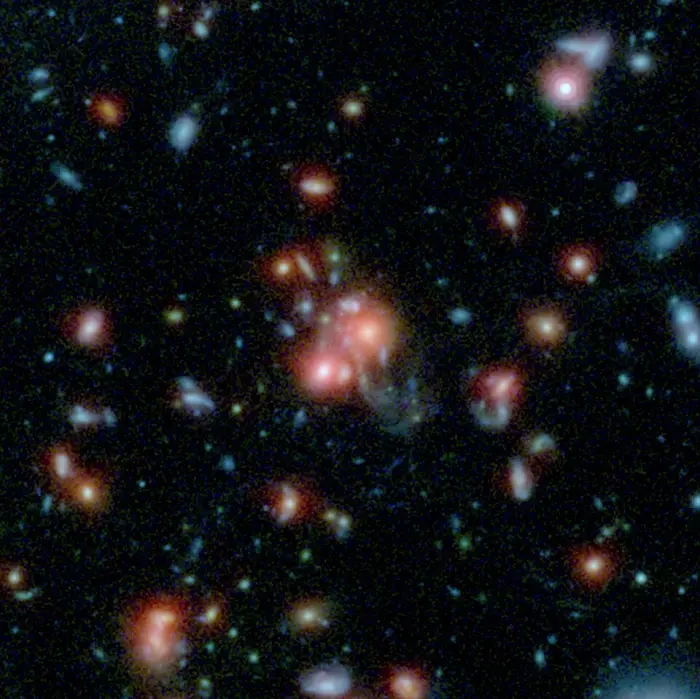
This image, using data from Spitzer and the Hubble Space Telescope, shows the galaxy cluster SpARCS1049. Credit: NASA/STScI/ESA/JPL-Caltech/McGill (CC BY 4.0)
NGC 3972
NGC 3972 is a spiral galaxy lying at an approximate distance of 66 million light-years. It appears north of Phecda, in the same region as the elliptical galaxy NGC 3998 and the spiral NGC 3982.
NGC 3972 is classified as a radio galaxy. It has an apparent magnitude of 13.14 and spans around 50,000 light-years. It is a member of the NGC 3992 Group (M109 Group).
The galaxy hosted two observed supernovae: the type Ia supernova SN 2011by (mag. 14.2) in April 2011 and the type II supernova SN 2021acna (mag. 19.39) in October 2021.
NGC 3972 and the nearby unbarred spiral galaxy NGC 3977 are catalogued as Holm 304. They form a line-of-sight pair and are not physically related. NGC 3977 lies 287.4 million light-years away.

This enchanting spiral galaxy can be found in the constellation of Ursa Major (the Great Bear). Star-studded NGC 3972 lies about 65 million light-years away from the Earth, meaning that the light that we see now left it 65 million years ago, just when the dinosaurs became extinct. Credit: NASA, ESA, A. Riess (STScI/JHU) (CC BY 4.0)
NGC 5308
NGC 5308 is a lenticular galaxy located 95.48 million light-years away. It appears in the region between Mizar in the Big Dipper’s handle and Thuban in the constellation Draco. The galaxy was discovered by William Herschel on March 19, 1790. It is a member of the NGC 5322 Group.
NGC 5308 has an apparent magnitude of 12.5 and an angular size of 3.7 by 0.7 arcminutes. It appears edge-on and has a diameter of 103,200 light-years. It hosted a type Ia supernova, SN 1996bk, observed in October 1996. The supernova had an apparent magnitude of 14.5.
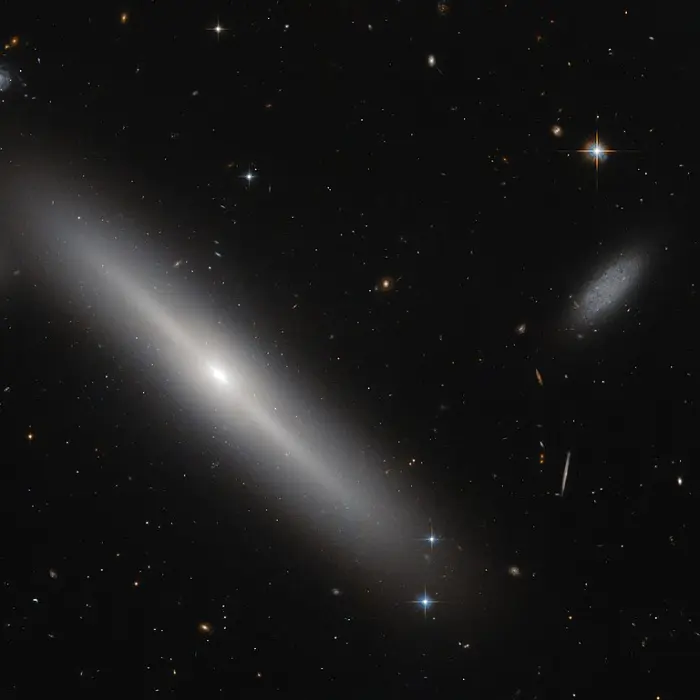
This NASA/ESA Hubble Space Telescope image shows star clusters encircling a galaxy, like bees buzzing around a hive. The hive in question the an edge-on lenticular galaxy NGC 5308, located just under 100 million light-years away in the constellation of Ursa Major (The Great Bear). Credit: ESA/Hubble & NASA, Judy Schmidt (Geckzilla) (CC BY 4.0)
NGC 3921
NGC 3921 is the remnant of a galaxy merger located 277.9 million light years away. It appears northwest of Phecda, within the Big Dipper’s bowl. It is catalogued as Arp 224 in the Atlas of Peculiar Galaxies.
The starburst galaxy has a diameter of 180,000 light years. Astronomers have detected two relatively young candidate globular clusters in the galaxy, as well as an ultraluminous X-ray source, designated X-2.
The two galaxies that merged to form a single larger galaxy are believed to have been disk galaxies. They collided around 700 million years ago, triggering waves of new star formation
NGC 3921 was discovered by William Herschel on April 14, 1789.
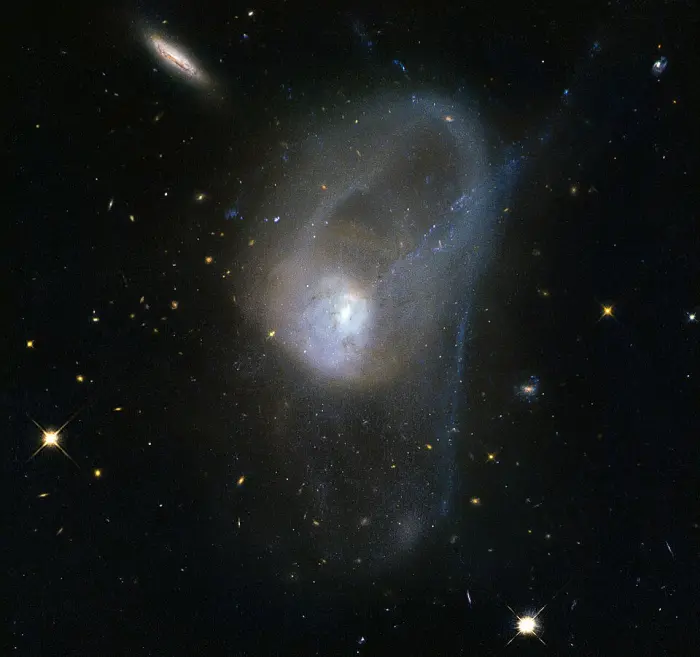
NGC 3921 — found in the constellation of Ursa Major (The Great Bear) — is an interacting pair of disc galaxies in the late stages of its merger. Observations show that both of the galaxies involved were about the same mass and collided about 700 million years ago. You can see clearly in this image the disturbed morphology, tails and loops characteristic of a post-merger. Credit: ESA/Hubble & NASA. Acknowledgement: Judy Schmidt (geckzilla.com) (CC BY 4.0)
Sparky (GOODS-N-774)
GOODS-N-774 is a massive, exceptionally compact distant early galaxy in the process of core formation. Nicknamed Sparky, the galaxy is believed to be evolving into a giant elliptical galaxy. It lies 11 billion light years away and has a comoving distance of around 18 billion light-years. It was discovered in 2014. At the time of discovery, Sparky was the first giant galaxy known to be in this phase of formation.
The galaxy has a diameter of only 5,900 light-years. It is producing new stars at a rate of 300 stars per year, 30 times the rate of the Milky Way. Even though it is much smaller than our galaxy, it is about twice as massive. The absence of an active galactic nucleus continues to puzzle astronomers.
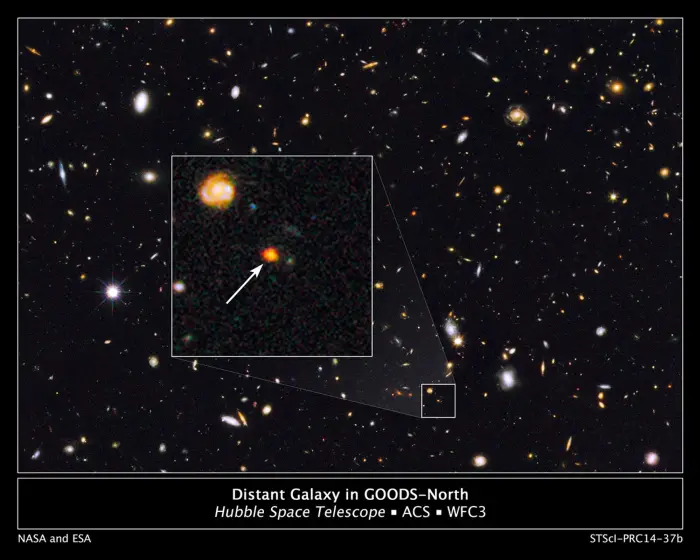
This image shows observations of a newly discovered galaxy core dubbed GOODS-N-774, taken by the NASA/ESA Hubble Space Telescope’s Wide Field Camera 3 and Advanced Camera for Surveys. The core is marked by the box inset, overlaid on a section of the Hubble GOODS-N, or GOODS North, field (Great Observatories Origins Deep Survey). Credit: NASA, ESA, and E. Nelson (Yale University, USA) (PD)
Holmberg II
Holmberg II is an irregular dwarf galaxy located only 11.06 million light-years away in Ursa Major, near the border with Camelopardalis. It has an apparent visual magnitude of 11.10 and an apparent size of 7.9 by 6.3 arcminutes.
The galaxy was discovered by the Swedish astronomer Erik Holmberg in the late 1960s. It contains vast regions of star formation and an ultraluminous X-ray source which may be an intermediate-mass black hole. Holmberg II is listed as Arp 268 in the Atlas of Peculiar Galaxies.
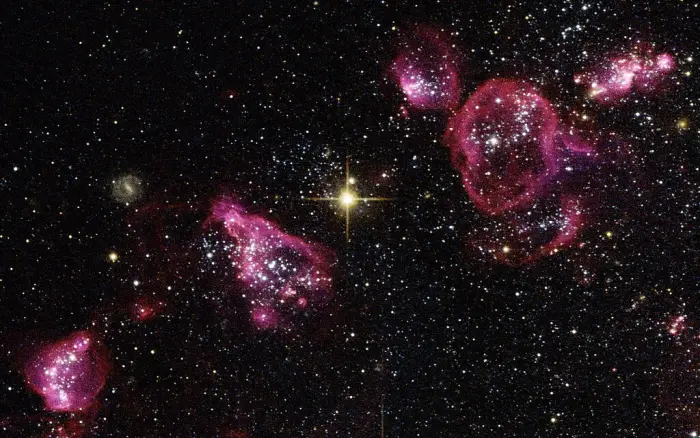
The NASA/ESA Hubble Space Telescope has captured this image of dwarf irregular galaxy Holmberg II. The galaxy is dominated by huge bubbles of glowing gas, which are sites of ongoing star formation. As high-mass stars form in dense regions of gas and dust they expel strong stellar winds that blow away the surrounding material. Credit: UCL Mathematical & Physical Sciences from London, UK (CC BY 2.0)
Holmberg IX
Holmberg IX is a dwarf irregular galaxy located 12 million light years away. The Magellanic-type galaxy is a satellite of the brighter and larger Bode’s Galaxy (M81). It may be the product of the interaction between M81 and M82. It was discovered by the Dutch-Canadian astronomer Sidney van den Bergh in 1959.
The burst of star formation in Holmberg IX may have been triggered by the close encounter between M81 and M82 with the nearby NGC 3077 around 200-300 million years ago. At least 20% of the stellar mass in the galaxy formed within the last 200 million years, which means that Holmberg IX has the youngest stellar population of any galaxy in the Milky Way’s neighbourhood. The young population of stars also suggests that Holmberg IX is a tidal dwarf galaxy, formed from the debris in the tidal arms of two larger colliding spiral galaxies.
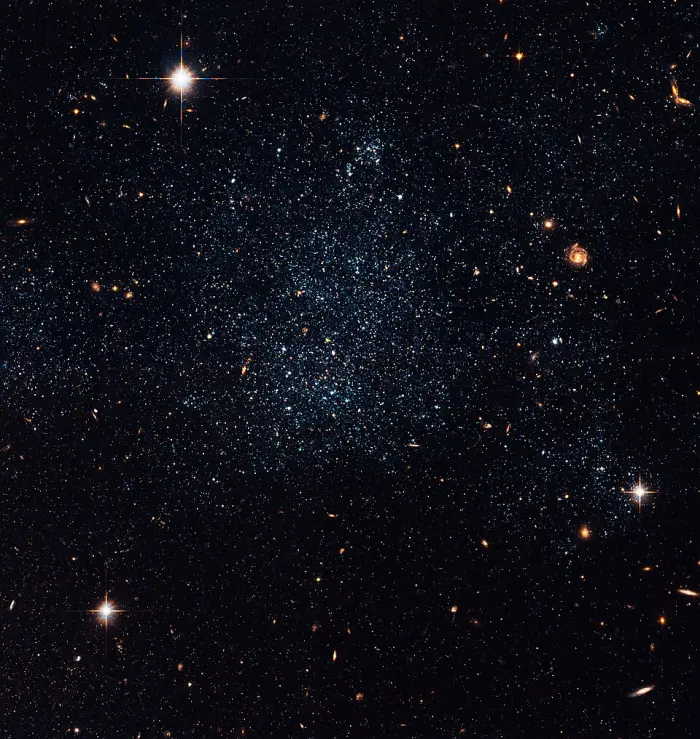
Holmberg IX, credit: NASA, ESA, and the Hubble Heritage Team (PD)
Keenan’s System (Arp 104)
Arp 104 is a pair of galaxies joined by a bridge of material that spans around 22,000 light-years. The interacting galaxies – the elliptical NGC 5216 and barred spiral NGC 5218 – appear about three quarters of the way from Megrez in Ursa Major to Thuban in Draco. They were discovered by William Herschel in 1790. They have apparent magnitudes of 14 and 12.3.
The galaxies are known as Keenan’s system, after the American astronomer Philip C. Keenan, who discovered the bridge connecting them and wrote a paper about it in 1935.
NGC 5216 and NGC 5218 lie approximately 17 million light-years away. They will eventually merge into a single larger system.
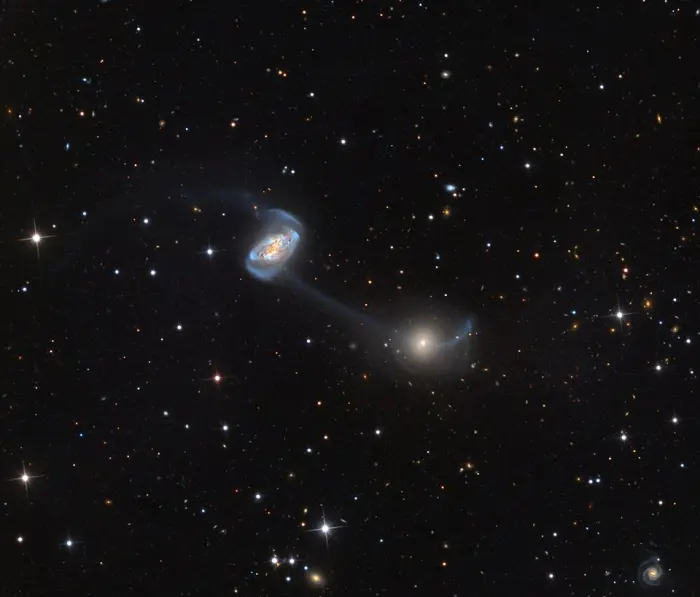
Keenan’s system (Arp 104), image credit: Wikimedia Commons/NGC1535 (CC BY 4.0)
NGC 3738
NGC 3738 is a blue compact dwarf galaxy about 10,000 light-years across, located 12 million light years away. It has an apparent magnitude of 12.04. It appears about a third of the way from Phecda to Merak in the Big Dipper’s bowl. William Herschel discovered the galaxy on April 14, 1789.
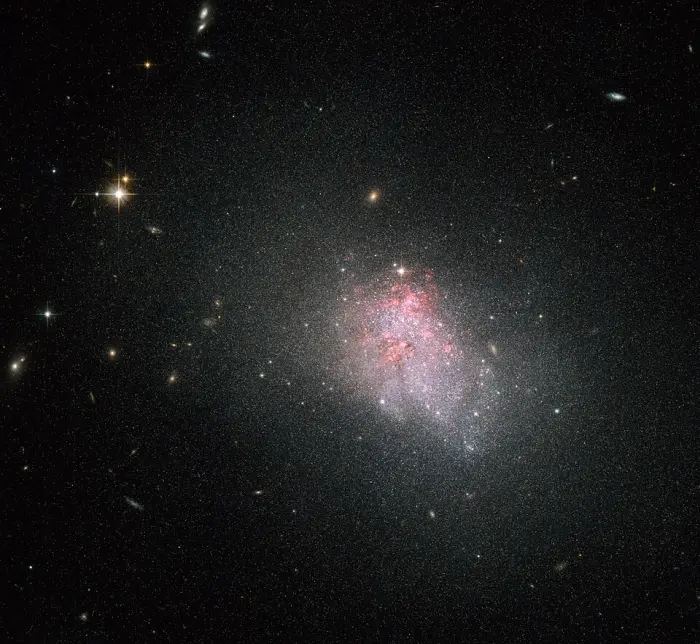
The NASA/ESA Hubble Space Telescope has imaged the faint irregular galaxy NGC 3738, a starburst galaxy. Credit: ESA/Hubble & NASA (CC BY 3.0)
NGC 3786
NGC 3786 is an unbarred spiral galaxy located approximately 107.5 million light-years away. It has an apparent magnitude of 14.6 and an apparent size of 1.207 by 0.627 arcminutes. The galaxy appears in the region of the Great Bear’s hind legs. It forms an interacting pair with the peculiar galaxy NGC 3788.
NGC 3786 is classified as a type 1.8 Seyfert galaxy. It hosted two recent supernovae. SN 1999bu was discovered on April 16, 1999, and SN 2004bd was observed on April 7, 2004.
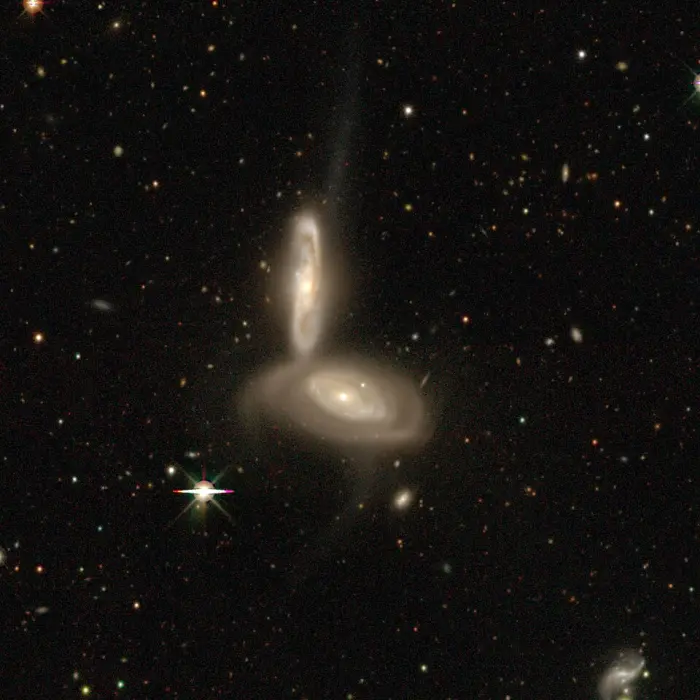
Arp 294 (NGC 3786, NGC 3788), credit: Legacy Surveys / D.Lang (Perimeter Institute) & Meli thev (CC BY 4.0)
Markarian 273
Markarian 273 is the product of a galaxy merger that occurred 502 million light-years away. It is approximately 130,000 light-years across. It is classified as a Seyfert galaxy and an ultraluminous infrared galaxy (ULIRG). The luminosity of the galaxy in the infrared band is due to a high rate of star formation.
The nuclei of the two galaxies that merged are visible at infrared wavelengths. They are separated by about 0.75 kiloparsecs. One of the nuclei corresponds to a Seyfert type II galaxy, while the other one is classified as a LINER.
Markarian 273 has a long tidal tail that extends for 40 kiloparsecs and appears edge-on. The galaxy lies north of the Big Dipper’s handle, in the same area as M101.
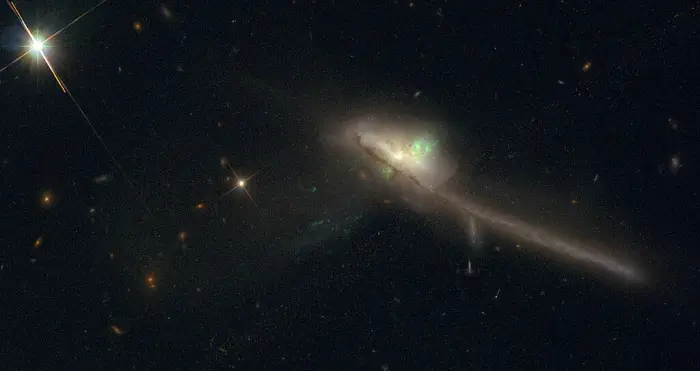
Markarian 273 by the Hubble Space Telescope, credit: NASA/ESA Hubble; Aaron Evans et al. (CC BY 4.0)
Markarian 231
Markarian 231 is a Seyfert type 1 galaxy located 581 million light years away. It contains the nearest known quasar, an exceptionally luminous active galactic nucleus (AGN).
The galaxy contains a nuclear ring where star formation is taking place at a rate of more than 100 solar masses per year. The galaxy’s central black hole has a mass of 150 million solar masses.
Observations with the Herschel Space Observatory in 2010 found evidence of water vapor in the galaxy’s emission. In 2020, molecular oxygen (O2) was detected in the galaxy. This was the first detection of molecular oxygen outside the Milky Way.
Markarian 231 appears close to Alioth, Ursa Major’s brightest star, in the sky. The galaxy was discovered in 1969.
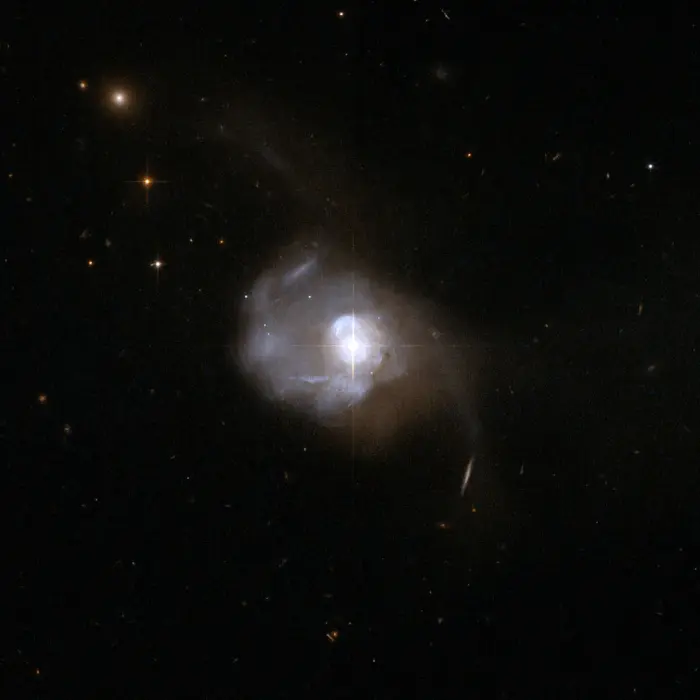
The extraordinary galaxy UGC 8058, also known as Markarian 231, was discovered in 1969 as part of a survey searching for galaxies with strong ultraviolet radiation. It has long tidal tails and a disturbed shape. Results from the first spectrum showed clear signs of the presence of a powerful quasar in the center that made Markarian 231 unique in the Markarian sample. Markarian 231 has maintained its reputation as an exceptional object since those early observations and continues to be a favorite target in all wavelength regimes. Its infrared luminosity is similar to that of quasars, making it one of the most luminous and powerful known ultra-luminous infrared galaxies. Credit: NASA, ESA, the Hubble Heritage (STScI/AURA)-ESA/Hubble Collaboration, and A. Evans (University of Virginia, Charlottesville/NRAO/Stony Brook University) (PD)
UGC 5101
UGC 5101 is a galaxy merger located around 528 million light-years away. It has an apparent magnitude of 15.1. It is classified as an ultraluminous infrared galaxy (ULIRG). The galaxy produces 105 solar masses per year.
UGC 5101 has an active galactic nucleus (AGN) and is classified as a type 1.5 Seyfert galaxy. It is believed to harbour a supermassive black hole surrounded by an accretion disk.
The galaxy has a faint halo of stars and a long tidal tail, created during the merger and appearing edge-on. Another tidal tail forms a ring around the galaxy’s nucleus.
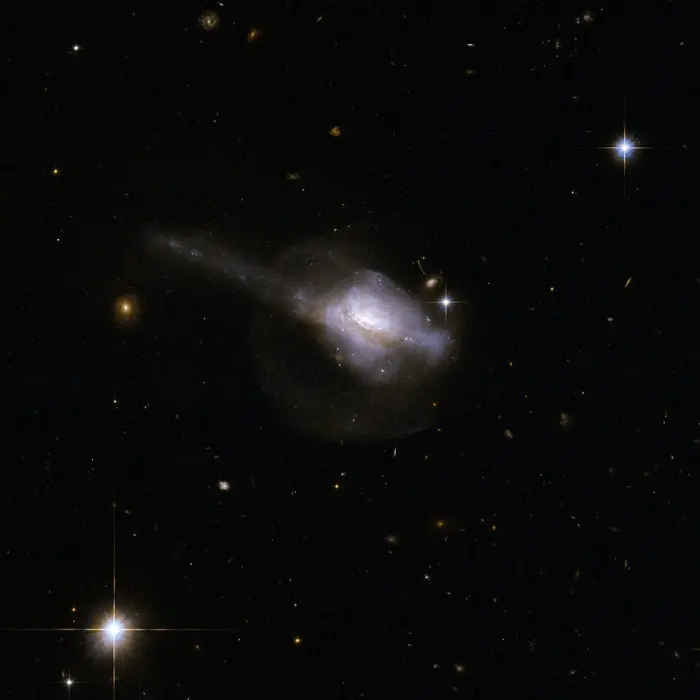
UGC 5101 is a peculiar galaxy with a single nucleus contained within an unstructured main body that suggests a recent interaction and merger. UGC 5101 is thought to contain an active galactic nucleus an extremely bright, compact core – buried deep in the gas and dust. A pronounced tail extends diagonally to the top-right of the frame. A fainter halo of stars surrounds the galaxy and is visible in the image, due to Hubble s ability to collect and detect faint light. This halo is probably a result of the earlier collision. Credit: NASA, ESA, the Hubble Heritage (STScI/AURA)-ESA/Hubble Collaboration, and A. Evans (University of Virginia, Charlottesville/NRAO/Stony Brook University) (PD)
NGC 5256
NGC 5256 is a pair of colliding disc galaxies located approximately 420 million light-years away. It is also catalogued as Markarian 266. The galaxy merger is classified as a luminous infrared galaxy (LIRG). Most of its energy output is at infrared wavelengths.
The colliding galaxies were discovered by William Herschel on May 12, 1787. They appear near Alkaid in the Big Dipper’s handle.
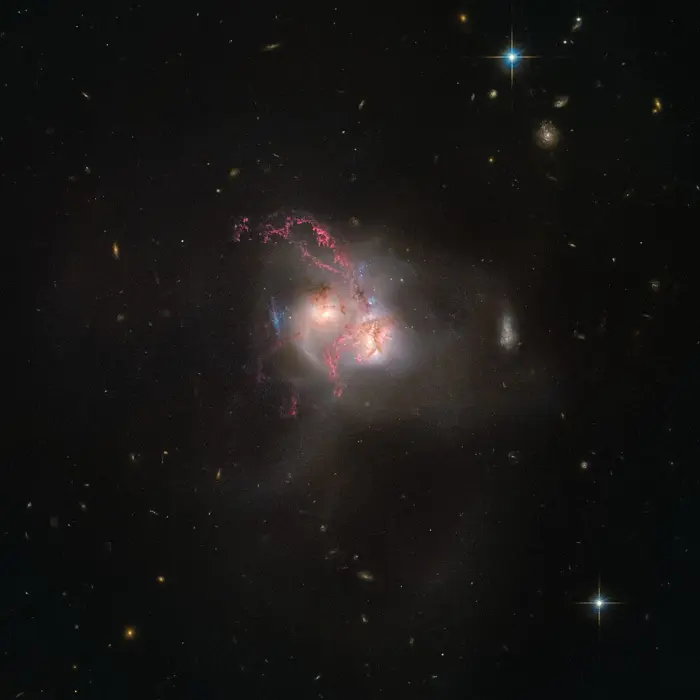
NGC 5256 is a pair of galaxies in its final stage of merging. It was previously observed by Hubble as part of a collection of 59 images of merging galaxies, released on Hubble’s 18th anniversary on 24 April 2008. The new data make the gas and dust being whirled around inside and outside the galaxy more visible than ever before. This image is composed of data gathered with the Advanced Camera for Surveys and the Wide-Field Camera 3. Credit: ESA/Hubble, NASA (CC BY 4.0)
UGC 4879
UGC 4879 (VV 124) is an irregular dwarf galaxy located only 4.5 million light-years away. It is a low-luminosity spheroidal galaxy that lies on the outskirts of the Local Group. It is about 3,000 light-years across and has an apparent magnitude of 14. Astronomers have detected evidence of dark matter in the galaxy.
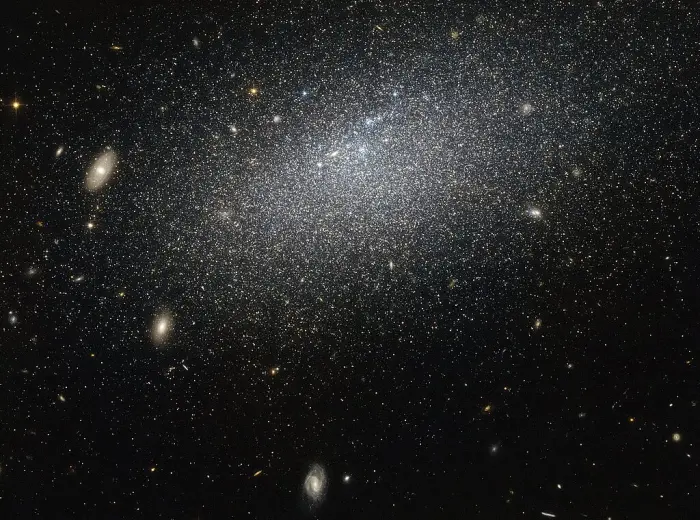
The drizzle of stars scattered across this image forms a galaxy known as UGC 4879. UGC 4879 is an irregular dwarf galaxy — as the name suggests, galaxies of this type are a little smaller and messier than their cosmic cousins, lacking the majestic swirl of a spiral or the coherence of an elliptical. This galaxy is also very isolated. There are about 2.3 million light years between UGC 4879 and its closest neighbour, Leo A, which is about the same distance as that between the Andromeda Galaxy and the Milky Way. Credit: NASA & ESA (CC BY 4.0)